Paul van Yperen's Blog, page 26
January 21, 2025
Ross Verlag, Part 19: Vom Werden deutscher Filmkunst - Der Stumme Film (3)
In the early 1920s, the Weimar Republic faced numerous problems, including hyperinflation and political extremism. But the German film industry thrived and seemed to produce an endless stream of silent masterpieces. In the third post on our (incomplete) series of collector cards of 'Von Werden deutscher Filmkunst - Der Stumme Film' pictures of such classics as Der Golem (1920) with Paul Wegener, Faust (1926) with Emil Jannings and Dr. Mabuse, der Spieler (1922) with Rudolf Klein-Rogge. Ross Verlag published the collector card series for the 'Cigaretten-Bilderdienst' in Altona-Bahrenfeld.
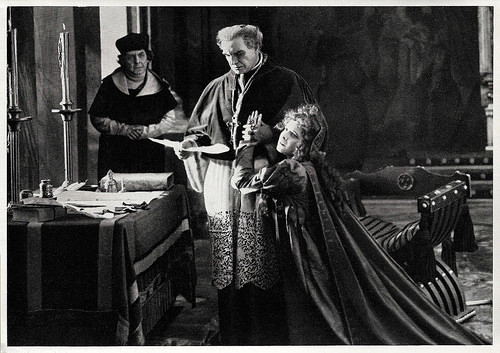
German collector card by Ross Verlag in the series 'Vom Werden deutscher Filmkunst - Der Stumme Film', picture no. 71, group 40. Photo: Ufa. Liane Haid as Lucretia Borgia and Albert Bassermann as pope Alexander VI Rodrigo Borgia in Lucrezia Borgia/Lucretia Borgia (Richard Oswald, 1922).
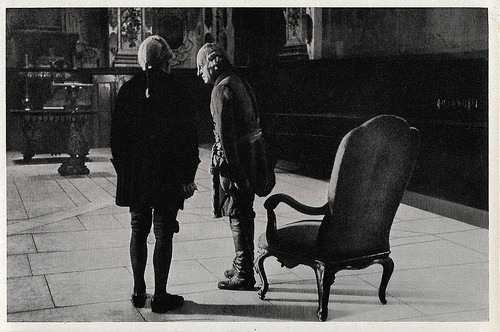
German collector card by Ross Verlag in the series 'Vom Werden deutscher Filmkunst - Der Stumme Film', no. 73, group 43. Photo: Ufa. Otto Gebühr in Fridericus Rex (Arzén von Cserépy, 1922).
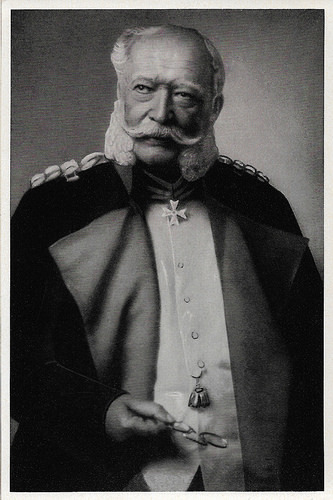
German collector card by Ross Verlag in the series 'Vom Werden deutscher Filmkunst - Der Stumme Film', no. 77, group 43. Photo: Bismarck-Film. Adolf Klein as Kaiser Wilhelm I in Bismarck, 1. Teil/Bismarck, Part 1 (Ernst Wendt, 1925).
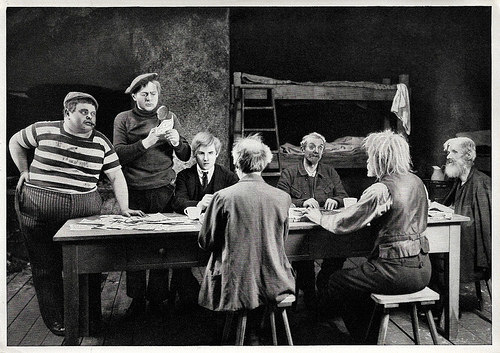
German collector card by Ross Verlag in the series 'Vom Werden deutscher Filmkunst - Der Stumme Film', no. 80, group 40. Photo: Ufa. Rudolf Klein-Rogge (second from left) and Károly Huszár (left) in Dr. Mabuse, der Spieler/Dr. Mabuse, King of Crime (Fritz Lang, 1922). Caption: Dr. Mabuse, who prints false money, lets the false notes be sorted by blind people who can not betray him.
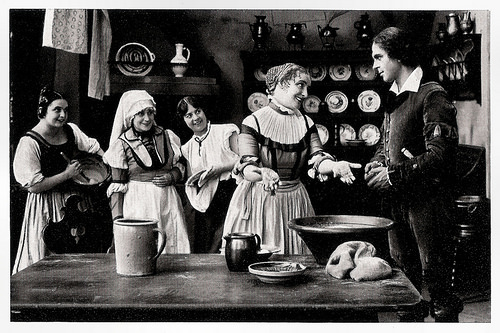
German collector card by Ross Verlag in the series 'Vom Werden deutscher Filmkunst - Der Stumme Film', no, 81, group 43. Photo: Ufa. Henny Porten and Paul Hartmann in Monika Vogelsang (Rudolf Biebrach, 1920).
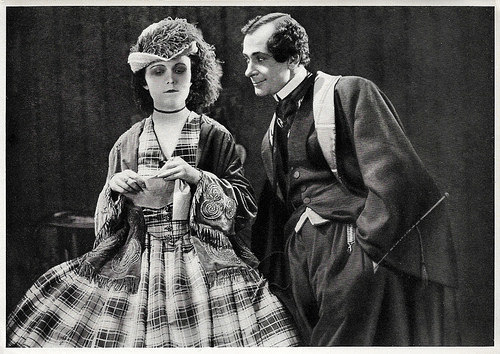
German collector card by Ross Verlag in the series 'Vom Werden deutscher Filmkunst - Der Stumme Film', no. 83, group 40. Photo: Ufa. Pola Negri and Alfred Abel in Die Flamme/The Flame (Ernst Lubitsch, 1923).
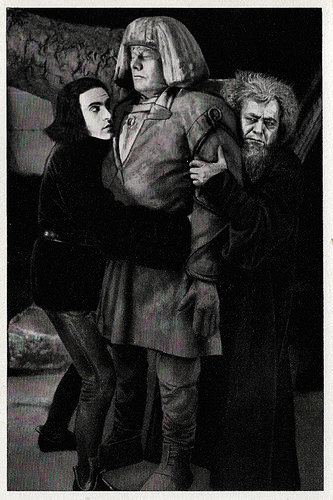
German collector card by Ross Verlag in the series 'Vom Werden deutscher Filmkunst - Der Stumme Film', no. 87, group 43. Photo: Ufa. Paul Wegener , Albert Steinrück and Ernst Deutsch in Der Golem, wie er in die Welt kam/The Golem: How He Came Into the World (Carl Boese, Paul Wegener, 1920). Caption: Paul Wegener as Golem, Albert Steinrück as Rabbi Loew, Ernst Deutsch as Famulus.
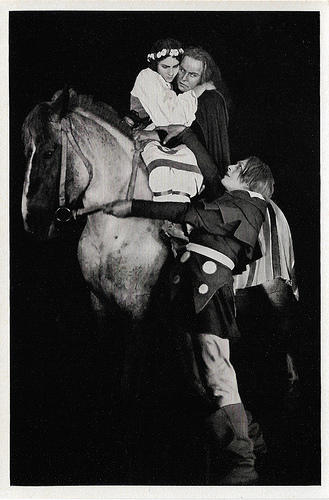
German collector card by Ross Verlag in the series 'Vom Werden deutscher Filmkunst - Der Stumme Film, picture', no. 90, group 43. Photo: Decla-Film. Rudolf Klein-Rogge and Lucie Mannheim in Der steinerne Reiter/The Stone Rider (Fritz Wendhausen, 1923).
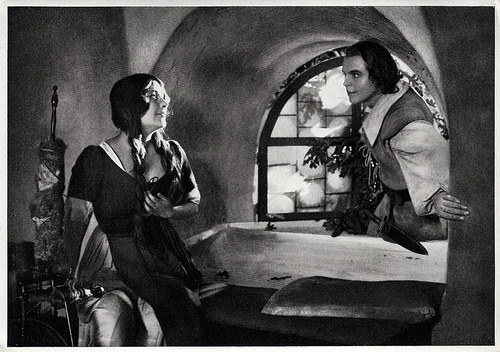
German collector card by Ross Verlag in the series 'Vom Werden deutscher Filmkunst - Der Stumme Film', no. 91, group 40. Photo: Ufa. Lil Dagover and Paul Hartmann in Zur Chronik von Grieshuus/The Chronicles of the Gray House (Arthur von Gerlach, 1925).
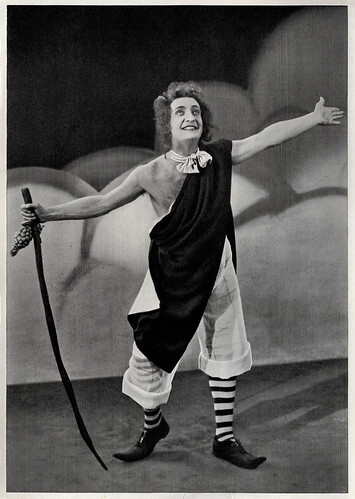
German collector card by Ross Verlag in the series 'Vom Werden deutscher Filmkunst - Der Stumme Film', no. 92, Group 42. Hans Albers as the bad spirit in Der böse Geist/Lumpaci the Vagabond (Carl Wilhelm, 1922).
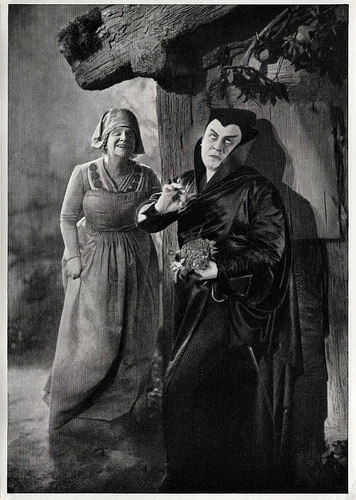
German collector card by Ross Verlag in the series 'Vom Werden deutscher Filmkunst - Der Stumme Film', no. 94, group 40. Photo: Ufa. Emil Jannings as Mephisto and Yvette Guilbert as Marthe in Faust (Friedrich Wilhelm Murnau, 1926).
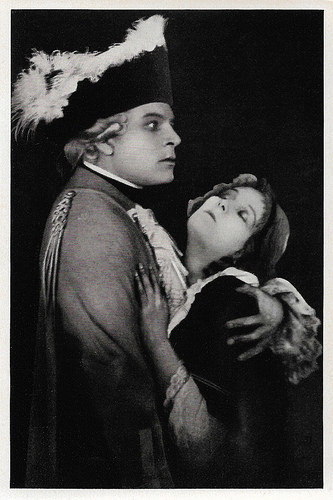
German collector card by Ross Verlag in the series 'Vom Werden deutscher Filmkunst - Der Stumme Film', no. 96, group 43. Photo: Decla-Film. Paul Hartmann and Lil Dagover in Luise Millerin (Carl Froelich, 1922).
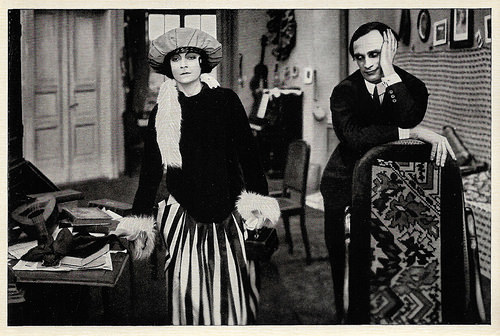
German collector card by Ross Verlag in the series 'Vom Werden deutscher Filmkunst - Der Stumme Film', no. 98. Photo: Ufa. Asta Nielsen and Conrad Veidt in Der Reigen - Ein Werdegang/The Merry-Go-Round (Richard Oswald, 1920).
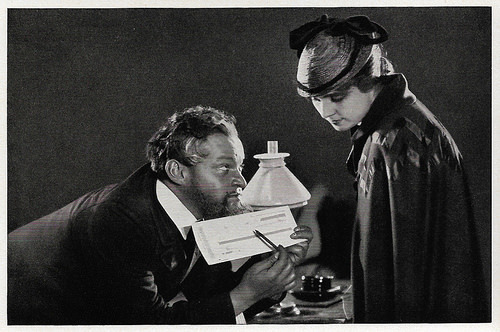
German collector card by Ross Verlag in the series 'Vom Werden deutscher Filmkunst - Der Stumme Film', no. 99, group 43. Photo: Ufa. Fritz Kortner and Olga Tschechowa in Nora (Berthold Viertel, 1923).
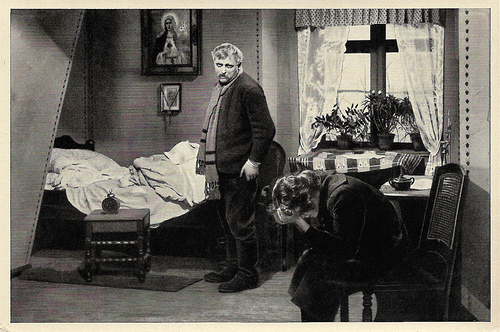
German collector card by Ross Verlag in the series 'Vom Werden deutscher Filmkunst - Der Stumme Film, no. 101. Photo: Ufa. Werner Krauss in the classic German Kammerspiel film Scherben/Shattered (Lupu Pick, 1921). The woman is Edith Posca, who plays the daughter.
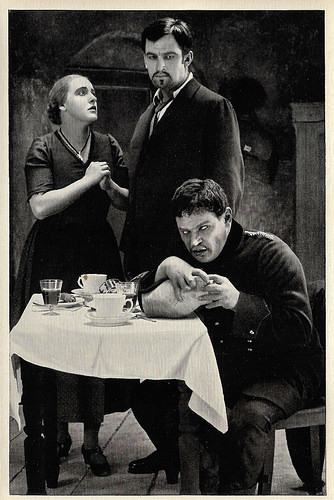
German collector card by Ross Verlag in the series 'Vom Werden deutscher Filmkunst - Der Stumme Film', no. 102. Photo: Ufa. Henny Porten , Wilhelm Dieterle and Fritz Kortner in Hintertreppe/Backstairs (Leopold Jessner, Paul Leni, 1921).
Our Ross Verlag Tribute will be continued next week!

German collector card by Ross Verlag in the series 'Vom Werden deutscher Filmkunst - Der Stumme Film', picture no. 71, group 40. Photo: Ufa. Liane Haid as Lucretia Borgia and Albert Bassermann as pope Alexander VI Rodrigo Borgia in Lucrezia Borgia/Lucretia Borgia (Richard Oswald, 1922).

German collector card by Ross Verlag in the series 'Vom Werden deutscher Filmkunst - Der Stumme Film', no. 73, group 43. Photo: Ufa. Otto Gebühr in Fridericus Rex (Arzén von Cserépy, 1922).

German collector card by Ross Verlag in the series 'Vom Werden deutscher Filmkunst - Der Stumme Film', no. 77, group 43. Photo: Bismarck-Film. Adolf Klein as Kaiser Wilhelm I in Bismarck, 1. Teil/Bismarck, Part 1 (Ernst Wendt, 1925).

German collector card by Ross Verlag in the series 'Vom Werden deutscher Filmkunst - Der Stumme Film', no. 80, group 40. Photo: Ufa. Rudolf Klein-Rogge (second from left) and Károly Huszár (left) in Dr. Mabuse, der Spieler/Dr. Mabuse, King of Crime (Fritz Lang, 1922). Caption: Dr. Mabuse, who prints false money, lets the false notes be sorted by blind people who can not betray him.

German collector card by Ross Verlag in the series 'Vom Werden deutscher Filmkunst - Der Stumme Film', no, 81, group 43. Photo: Ufa. Henny Porten and Paul Hartmann in Monika Vogelsang (Rudolf Biebrach, 1920).

German collector card by Ross Verlag in the series 'Vom Werden deutscher Filmkunst - Der Stumme Film', no. 83, group 40. Photo: Ufa. Pola Negri and Alfred Abel in Die Flamme/The Flame (Ernst Lubitsch, 1923).

German collector card by Ross Verlag in the series 'Vom Werden deutscher Filmkunst - Der Stumme Film', no. 87, group 43. Photo: Ufa. Paul Wegener , Albert Steinrück and Ernst Deutsch in Der Golem, wie er in die Welt kam/The Golem: How He Came Into the World (Carl Boese, Paul Wegener, 1920). Caption: Paul Wegener as Golem, Albert Steinrück as Rabbi Loew, Ernst Deutsch as Famulus.

German collector card by Ross Verlag in the series 'Vom Werden deutscher Filmkunst - Der Stumme Film, picture', no. 90, group 43. Photo: Decla-Film. Rudolf Klein-Rogge and Lucie Mannheim in Der steinerne Reiter/The Stone Rider (Fritz Wendhausen, 1923).

German collector card by Ross Verlag in the series 'Vom Werden deutscher Filmkunst - Der Stumme Film', no. 91, group 40. Photo: Ufa. Lil Dagover and Paul Hartmann in Zur Chronik von Grieshuus/The Chronicles of the Gray House (Arthur von Gerlach, 1925).

German collector card by Ross Verlag in the series 'Vom Werden deutscher Filmkunst - Der Stumme Film', no. 92, Group 42. Hans Albers as the bad spirit in Der böse Geist/Lumpaci the Vagabond (Carl Wilhelm, 1922).

German collector card by Ross Verlag in the series 'Vom Werden deutscher Filmkunst - Der Stumme Film', no. 94, group 40. Photo: Ufa. Emil Jannings as Mephisto and Yvette Guilbert as Marthe in Faust (Friedrich Wilhelm Murnau, 1926).

German collector card by Ross Verlag in the series 'Vom Werden deutscher Filmkunst - Der Stumme Film', no. 96, group 43. Photo: Decla-Film. Paul Hartmann and Lil Dagover in Luise Millerin (Carl Froelich, 1922).

German collector card by Ross Verlag in the series 'Vom Werden deutscher Filmkunst - Der Stumme Film', no. 98. Photo: Ufa. Asta Nielsen and Conrad Veidt in Der Reigen - Ein Werdegang/The Merry-Go-Round (Richard Oswald, 1920).

German collector card by Ross Verlag in the series 'Vom Werden deutscher Filmkunst - Der Stumme Film', no. 99, group 43. Photo: Ufa. Fritz Kortner and Olga Tschechowa in Nora (Berthold Viertel, 1923).

German collector card by Ross Verlag in the series 'Vom Werden deutscher Filmkunst - Der Stumme Film, no. 101. Photo: Ufa. Werner Krauss in the classic German Kammerspiel film Scherben/Shattered (Lupu Pick, 1921). The woman is Edith Posca, who plays the daughter.

German collector card by Ross Verlag in the series 'Vom Werden deutscher Filmkunst - Der Stumme Film', no. 102. Photo: Ufa. Henny Porten , Wilhelm Dieterle and Fritz Kortner in Hintertreppe/Backstairs (Leopold Jessner, Paul Leni, 1921).
Our Ross Verlag Tribute will be continued next week!
Published on January 21, 2025 22:00
January 20, 2025
David Lynch (1946-2025)
On 15 January, American filmmaker David Lynch (1946-2025) passed away in Los Angeles. He was the figurehead of American surrealist cinema and won several awards for his films and television series Twin Peaks (1990-1991). Nightmares, strange worlds, metamorphoses, voyeurism and the unconscious are recurring themes in his work. In his thrillers Blue Velvet (1986), Twin Peaks: Fire Walk with Me (1992) and Mulholland Dr. (2001), he combined sex, violence and black humour with stylistic beauty and an attempt at technical perfection. Besides directing films, Lynch was a producer, actor, screenwriter, and visual artist and he engaged in many other avocations.
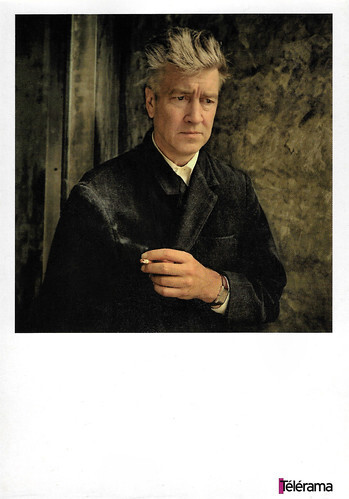
French postcard by CartCom for Télérama. Photo: Richard Dumas / Télérama. David Lynch (1946-2025).
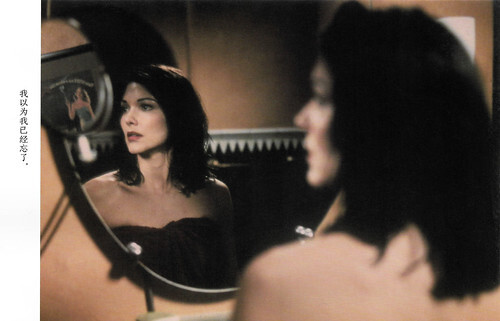
Chinese postcard. Laura Harring in Mulholland Dr. (David Lynch, 2001).
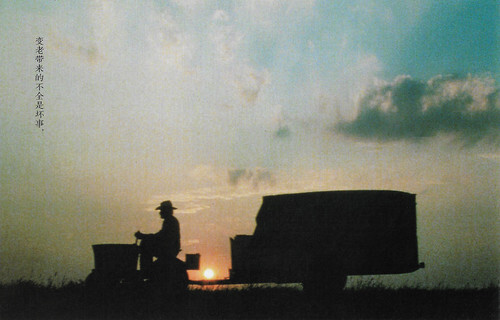
Chinese postcard. Richard Farnsworth in The Straight Story (David Lynch, 1999).
A success in the midnight movie Underground Circuit
David Keith Lynch was born in 1946 in Missoula, Montana, precisely the kind of small-town American setting so familiar from his films. His father, Donald Walton Lynch was a research scientist working for the U.S. Department of Agriculture (USDA), and his mother, Edwina ‘Sunny’ Lynch née Sundholm, was an English language tutor.
Lynch initially wanted to become a painter. He attended several art schools until he found his niche at the Pennsylvania Academy of Fine Arts where he started working with film. He married Peggy Reavey and then fathered future director Jennifer Lynch shortly after he turned 21. During this period, he made four short films with a grant from the American Film Institute.
His first short was Six Men Getting Sick (Six Times) (1967). Lynch played it on a loop at the academy's annual end-of-year exhibit, where it shared the joint-first prize with a painting by Noel Mahaffey. After several exhibitions in local galleries, he moved to Los Angeles where he studied at the AFI Center for Advanced Film Studies. There he started his first larger project, on which he worked obsessively for five years, Eraserhead (1976).
Filmed in black and white, Eraserhead tells the story of Henry (Jack Nance), a quiet young man, living in a dystopian industrial wasteland, whose girlfriend gives birth to a deformed baby whom she leaves in his care. The film reflects dangerous and terrifying elements he encountered while living and studying in a particularly violent and run-down area of Philadelphia. Eraserhead saw success in the midnight movie underground circuit.
Stuart Cornfeld, an executive producer for Brooksfilms, Mel Brooks' newly formed production company, saw it and agreed to help Lynch with his next film. Lynch asked Cornfeld to find him a script by someone else that he could direct. Lynch chose the biographical drama The Elephant Man (1980) by Christopher De Vore and Eric Bergren. It was based on the true story of Joseph Merrick (John Hurt), a severely deformed man in Victorian London, who was held in a sideshow but later taken under the care of a London surgeon, Frederick Treves ( Anthony Hopkins ). Though surrealistic and in black and white, it is one of the more conventional of Lynch's films. The Elephant Man was a huge critical and commercial success, earning eight Academy Award nominations, including Best Director and Best Adapted Screenplay.
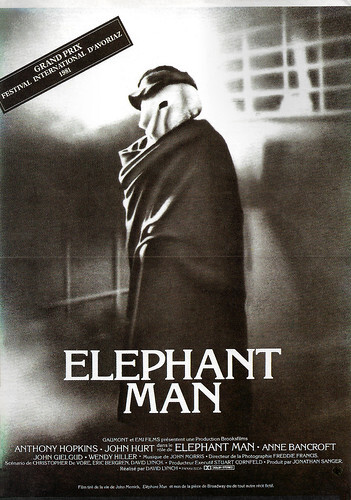
French postcard by Editions F. Nugeron, no. E 411. French poster for The Elephant Man (David Lynch, 1980).
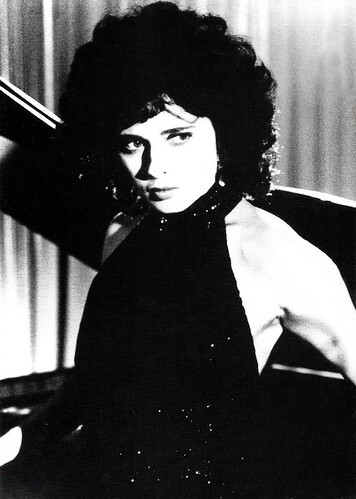
Danish postcard by Forlaget "Holger Danske", Denmark, no. 608. Isabella Rossellini in Blue Velvet (David Lynch, 1986).
A hugely expensive commercial disaster
In 1980, David Lynch was known as one of the most promising new talents in Hollywood. Producer Dino de Laurentiis asked Lynch to create a film adaptation of Frank Herbert's Science Fiction novel ‘Dune’. It became a hugely expensive commercial disaster.
The film is set in the far future when humans live in an interstellar empire under a feudal system. Paul Atreides (Kyle MacLachlan) is the son of a noble who takes control of the desert planet Arrakis, which grows the rare spice melange, the empire's most highly prized commodity.
Lynch was unhappy with the work and didn't have the final cut. Dune cost $45 million to make and grossed $27.4 million domestically. Lynch was contractually obliged to produce two other projects for De Laurentiis, the first a planned sequel to Dune, which due to the film's failure never went beyond the script stage.
The other was a more personal work, the thriller Blue Velvet (1986). Kyle MacLachlan plays a college student, Jeffrey Beaumont, who finds a severed ear in a field. Investigating further with the help of friend Sandy (Laura Dern), he discovers that it is related to a criminal gang led by psychopath Frank Booth (Dennis Hopper). Frank has kidnapped the husband and child of singer Dorothy Vallens ( Isabella Rossellini ) and repeatedly rapes her.
Blue Velvet was Lynch's first collaboration with composer Angelo Badalamenti, who has since written the music for all of Lynch's films. For Blue Velvet, Lynch received his second Oscar nomination. It became a huge critical and moderate commercial success.
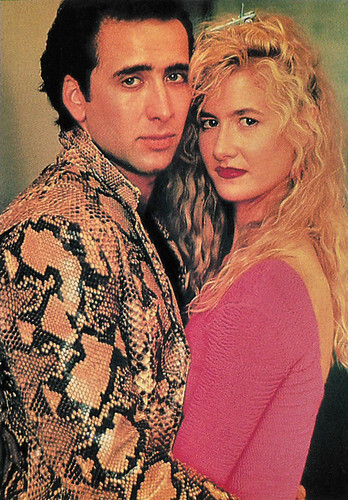
French postcard by Sonis, no. C. 146. Photo: BAC Films. Nicolas Cage and Laura Dern in Wild at Heart (David Lynch, 1990).
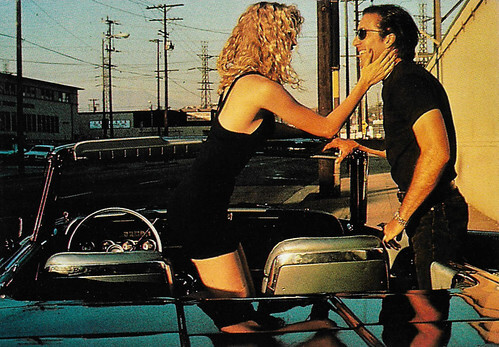
French postcard by Sonis, no. C. 146. Photo: BAC Films. Nicolas Cage and Laura Dern in Wild at Heart (David Lynch, 1990).
A 300-mile journey on a lawnmower
In 1986, David Lynch met screenwriter producer Mark Frost and they started to develop some projects. They created for television the drama series Twin Peaks (1990–1991), set in a small Washington town where popular high school student Laura Palmer has been murdered. Twin Peaks featured FBI Special Agent Dale Cooper (Kyle MacLachlan) as the investigator trying to identify the killer and discover not only the murder's supernatural aspects but also many of the townsfolk's secrets. Lynch portrayed FBI agent Gordon Cole in the series.
35 million viewers watched the pilot and the series soon spawned a cult following. Lynch received five Primetime Emmy Award nominations for the drama series, including Outstanding Directing and Outstanding Writing. Twin Peaks was sold to 55 countries. Lynch co-wrote and directed a film prequel, Twin Peaks: Fire Walk with Me (1992), and a third season in 2017.
His next film, the romantic and violent crime drama Wild at Heart (1990) starring Nicolas Cage as Sailor and Laura Dern as Lula, won the Palme d'Or (Golden Palm) at the Cannes Film Festival. Although he focused almost exclusively on the United States, Lynch had a large audience in Europe and especially France, where several of his later films were co-financed by French production companies.
Lynch won the César twice for ‘Best Foreign Film’. After a few unsuccessful TV ventures, Lynch returned to film. In 1997, he released the Neo-Noir Lost Highway (1997), which was co-written by Barry Gifford and starred Bill Pullman and Patricia Arquette. The film failed commercially and received a mixed response from critics.
Lynch then filmed the biographical drama The Straight Story (1999), based on the true story of Alvin Straight (Richard Farnsworth), an elderly man from Laurens, Iowa, who goes on a 300-mile journey to visit his sick brother (Harry Dean Stanton) in Mount Zion, Wisconsin, by riding a lawnmower. The plot seemed far removed from Lynch's earlier works, but in fact, Lynch made a surreal road movie. Walt Disney Pictures acquired the distribution rights.

American postcard by Smith Western Co., Tacoma, WA, no. CT-3610. Photo: Kyle Smith. Caption: North Bend, Washington - Gateway to the Cascades. Mt. Si is a local attraction, best known for its hiking, hunting, fishing and camping.
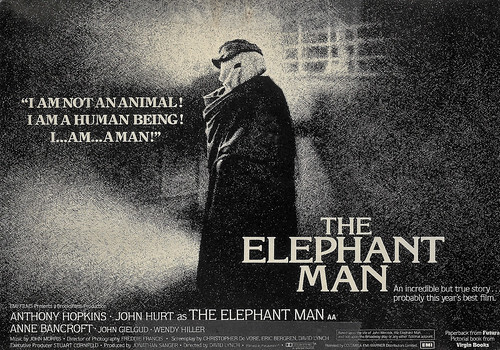
French poster postcard by Editions 'Humour à la Carte', Paris, no. A-C 91. British poster by EMI for The Elephant Man (David Lynch, 1980) with John Hurt.
Fearlessly breaking boundaries in the pursuit of his unique cinematic vision
ABC Network gave David Lynch the go-ahead to shoot a two-hour pilot for the series Mulholland Drive but disputes over content and running time led to the project being shelved indefinitely. But with $7 million from the French production company StudioCanal, Lynch completed the pilot as a film, the Neo-Noir Mulholland Dr. (2001).
The film, a non-linear narrative surrealist tale of Hollywood's dark side, stars Naomi Watts, Laura Harring and Justin Theroux. It performed relatively well at the box office worldwide and was a critical success, earning Lynch the Best Director award at the 2001 Cannes Film Festival (shared with Joel Coen for The Man Who Wasn't There) and his third Academy Award nomination for Best Director.
In 2006, Lynch's longest film, Inland Empire, was released. Like Mulholland Dr. and Lost Highway, it does not follow a traditional narrative structure. It stars Lynch regulars Laura Dern, Harry Dean Stanton and Justin Theroux. Interested in working with Werner Herzog, Lynch collaborated on Herzog's film My Son, My Son, What Have Ye Done? (2009). With a nonstandard narrative, the film is based on a true story of an actor who committed matricide while acting in a production of the 'Oresteia' and starred Lynch regular Grace Zabriskie.
He portrayed Howard in the drama film Lucky (John Carroll Lynch, 2017) alongside friend and collaborator Harry Dean Stanton, and director John Ford in Steven Spielberg's The Fabelmans (2022). He also guest-starred in shows, voicing a bartender in The Cleveland Show (2010–2013) and playing an entertainment veteran in Louie (2012). In 2019, he received an honorary Oscar ‘for fearlessly breaking boundaries in the pursuit of his unique cinematic vision’.
David Lynch was married four times and was the father of two sons and two daughters. In August 2024, he announced he was suffering from pulmonary emphysema due to years of smoking. This left him unable to leave his home. In January 2025, he was evacuated from his home due to the Los Angeles wildfires, after which his health deteriorated rapidly. He died on 15 January 2025 in the home of one of his daughters.
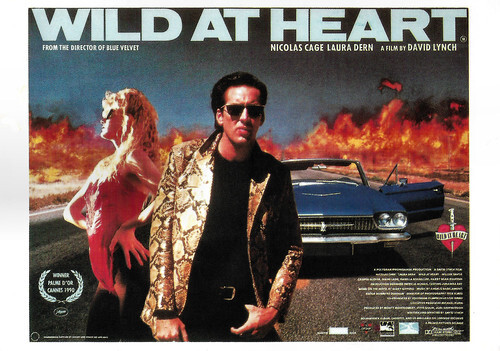
Vintage poster postcard, no. Z 1064. British poster for Wild at Heart (David Lynch, 1990) with Nicolas Cage and Laura Dern. Caption: From the director of Blue Velvet.
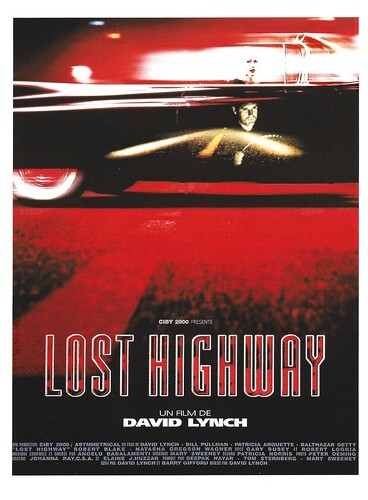
Swiss poster postcard by CVP Publishers / News Productions. Image: Collection Cinémathèque Suisse, Lausanne. French poster for Lost Highway (David Lynch, 1997).
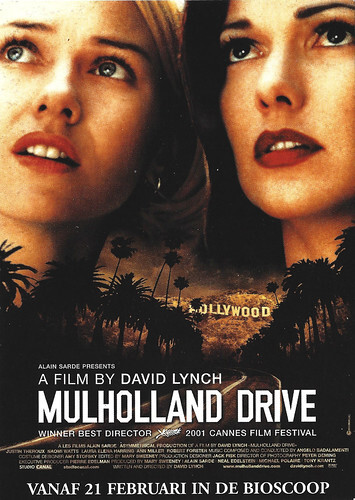
Dutch poster postcard by A-Film. Poster for Mulholland Drive (David Lynch, 2001) with Naomi Watts and Laura Harring.
Sources: (IMDb), Wikipedia (Dutch, German and English) and .

French postcard by CartCom for Télérama. Photo: Richard Dumas / Télérama. David Lynch (1946-2025).

Chinese postcard. Laura Harring in Mulholland Dr. (David Lynch, 2001).

Chinese postcard. Richard Farnsworth in The Straight Story (David Lynch, 1999).
A success in the midnight movie Underground Circuit
David Keith Lynch was born in 1946 in Missoula, Montana, precisely the kind of small-town American setting so familiar from his films. His father, Donald Walton Lynch was a research scientist working for the U.S. Department of Agriculture (USDA), and his mother, Edwina ‘Sunny’ Lynch née Sundholm, was an English language tutor.
Lynch initially wanted to become a painter. He attended several art schools until he found his niche at the Pennsylvania Academy of Fine Arts where he started working with film. He married Peggy Reavey and then fathered future director Jennifer Lynch shortly after he turned 21. During this period, he made four short films with a grant from the American Film Institute.
His first short was Six Men Getting Sick (Six Times) (1967). Lynch played it on a loop at the academy's annual end-of-year exhibit, where it shared the joint-first prize with a painting by Noel Mahaffey. After several exhibitions in local galleries, he moved to Los Angeles where he studied at the AFI Center for Advanced Film Studies. There he started his first larger project, on which he worked obsessively for five years, Eraserhead (1976).
Filmed in black and white, Eraserhead tells the story of Henry (Jack Nance), a quiet young man, living in a dystopian industrial wasteland, whose girlfriend gives birth to a deformed baby whom she leaves in his care. The film reflects dangerous and terrifying elements he encountered while living and studying in a particularly violent and run-down area of Philadelphia. Eraserhead saw success in the midnight movie underground circuit.
Stuart Cornfeld, an executive producer for Brooksfilms, Mel Brooks' newly formed production company, saw it and agreed to help Lynch with his next film. Lynch asked Cornfeld to find him a script by someone else that he could direct. Lynch chose the biographical drama The Elephant Man (1980) by Christopher De Vore and Eric Bergren. It was based on the true story of Joseph Merrick (John Hurt), a severely deformed man in Victorian London, who was held in a sideshow but later taken under the care of a London surgeon, Frederick Treves ( Anthony Hopkins ). Though surrealistic and in black and white, it is one of the more conventional of Lynch's films. The Elephant Man was a huge critical and commercial success, earning eight Academy Award nominations, including Best Director and Best Adapted Screenplay.

French postcard by Editions F. Nugeron, no. E 411. French poster for The Elephant Man (David Lynch, 1980).

Danish postcard by Forlaget "Holger Danske", Denmark, no. 608. Isabella Rossellini in Blue Velvet (David Lynch, 1986).
A hugely expensive commercial disaster
In 1980, David Lynch was known as one of the most promising new talents in Hollywood. Producer Dino de Laurentiis asked Lynch to create a film adaptation of Frank Herbert's Science Fiction novel ‘Dune’. It became a hugely expensive commercial disaster.
The film is set in the far future when humans live in an interstellar empire under a feudal system. Paul Atreides (Kyle MacLachlan) is the son of a noble who takes control of the desert planet Arrakis, which grows the rare spice melange, the empire's most highly prized commodity.
Lynch was unhappy with the work and didn't have the final cut. Dune cost $45 million to make and grossed $27.4 million domestically. Lynch was contractually obliged to produce two other projects for De Laurentiis, the first a planned sequel to Dune, which due to the film's failure never went beyond the script stage.
The other was a more personal work, the thriller Blue Velvet (1986). Kyle MacLachlan plays a college student, Jeffrey Beaumont, who finds a severed ear in a field. Investigating further with the help of friend Sandy (Laura Dern), he discovers that it is related to a criminal gang led by psychopath Frank Booth (Dennis Hopper). Frank has kidnapped the husband and child of singer Dorothy Vallens ( Isabella Rossellini ) and repeatedly rapes her.
Blue Velvet was Lynch's first collaboration with composer Angelo Badalamenti, who has since written the music for all of Lynch's films. For Blue Velvet, Lynch received his second Oscar nomination. It became a huge critical and moderate commercial success.

French postcard by Sonis, no. C. 146. Photo: BAC Films. Nicolas Cage and Laura Dern in Wild at Heart (David Lynch, 1990).

French postcard by Sonis, no. C. 146. Photo: BAC Films. Nicolas Cage and Laura Dern in Wild at Heart (David Lynch, 1990).
A 300-mile journey on a lawnmower
In 1986, David Lynch met screenwriter producer Mark Frost and they started to develop some projects. They created for television the drama series Twin Peaks (1990–1991), set in a small Washington town where popular high school student Laura Palmer has been murdered. Twin Peaks featured FBI Special Agent Dale Cooper (Kyle MacLachlan) as the investigator trying to identify the killer and discover not only the murder's supernatural aspects but also many of the townsfolk's secrets. Lynch portrayed FBI agent Gordon Cole in the series.
35 million viewers watched the pilot and the series soon spawned a cult following. Lynch received five Primetime Emmy Award nominations for the drama series, including Outstanding Directing and Outstanding Writing. Twin Peaks was sold to 55 countries. Lynch co-wrote and directed a film prequel, Twin Peaks: Fire Walk with Me (1992), and a third season in 2017.
His next film, the romantic and violent crime drama Wild at Heart (1990) starring Nicolas Cage as Sailor and Laura Dern as Lula, won the Palme d'Or (Golden Palm) at the Cannes Film Festival. Although he focused almost exclusively on the United States, Lynch had a large audience in Europe and especially France, where several of his later films were co-financed by French production companies.
Lynch won the César twice for ‘Best Foreign Film’. After a few unsuccessful TV ventures, Lynch returned to film. In 1997, he released the Neo-Noir Lost Highway (1997), which was co-written by Barry Gifford and starred Bill Pullman and Patricia Arquette. The film failed commercially and received a mixed response from critics.
Lynch then filmed the biographical drama The Straight Story (1999), based on the true story of Alvin Straight (Richard Farnsworth), an elderly man from Laurens, Iowa, who goes on a 300-mile journey to visit his sick brother (Harry Dean Stanton) in Mount Zion, Wisconsin, by riding a lawnmower. The plot seemed far removed from Lynch's earlier works, but in fact, Lynch made a surreal road movie. Walt Disney Pictures acquired the distribution rights.

American postcard by Smith Western Co., Tacoma, WA, no. CT-3610. Photo: Kyle Smith. Caption: North Bend, Washington - Gateway to the Cascades. Mt. Si is a local attraction, best known for its hiking, hunting, fishing and camping.

French poster postcard by Editions 'Humour à la Carte', Paris, no. A-C 91. British poster by EMI for The Elephant Man (David Lynch, 1980) with John Hurt.
Fearlessly breaking boundaries in the pursuit of his unique cinematic vision
ABC Network gave David Lynch the go-ahead to shoot a two-hour pilot for the series Mulholland Drive but disputes over content and running time led to the project being shelved indefinitely. But with $7 million from the French production company StudioCanal, Lynch completed the pilot as a film, the Neo-Noir Mulholland Dr. (2001).
The film, a non-linear narrative surrealist tale of Hollywood's dark side, stars Naomi Watts, Laura Harring and Justin Theroux. It performed relatively well at the box office worldwide and was a critical success, earning Lynch the Best Director award at the 2001 Cannes Film Festival (shared with Joel Coen for The Man Who Wasn't There) and his third Academy Award nomination for Best Director.
In 2006, Lynch's longest film, Inland Empire, was released. Like Mulholland Dr. and Lost Highway, it does not follow a traditional narrative structure. It stars Lynch regulars Laura Dern, Harry Dean Stanton and Justin Theroux. Interested in working with Werner Herzog, Lynch collaborated on Herzog's film My Son, My Son, What Have Ye Done? (2009). With a nonstandard narrative, the film is based on a true story of an actor who committed matricide while acting in a production of the 'Oresteia' and starred Lynch regular Grace Zabriskie.
He portrayed Howard in the drama film Lucky (John Carroll Lynch, 2017) alongside friend and collaborator Harry Dean Stanton, and director John Ford in Steven Spielberg's The Fabelmans (2022). He also guest-starred in shows, voicing a bartender in The Cleveland Show (2010–2013) and playing an entertainment veteran in Louie (2012). In 2019, he received an honorary Oscar ‘for fearlessly breaking boundaries in the pursuit of his unique cinematic vision’.
David Lynch was married four times and was the father of two sons and two daughters. In August 2024, he announced he was suffering from pulmonary emphysema due to years of smoking. This left him unable to leave his home. In January 2025, he was evacuated from his home due to the Los Angeles wildfires, after which his health deteriorated rapidly. He died on 15 January 2025 in the home of one of his daughters.

Vintage poster postcard, no. Z 1064. British poster for Wild at Heart (David Lynch, 1990) with Nicolas Cage and Laura Dern. Caption: From the director of Blue Velvet.

Swiss poster postcard by CVP Publishers / News Productions. Image: Collection Cinémathèque Suisse, Lausanne. French poster for Lost Highway (David Lynch, 1997).

Dutch poster postcard by A-Film. Poster for Mulholland Drive (David Lynch, 2001) with Naomi Watts and Laura Harring.
Sources: (IMDb), Wikipedia (Dutch, German and English) and .
Published on January 20, 2025 22:00
January 19, 2025
Jackie Lane
Austrian-born starlet Jackie Lane (1937) was a stunningly beautiful model and film actress of the 1950s and 1960s, who starred both in European films and in Hollywood pictures. She was married to Prince Alfonso of Hohenlohe-Langenburg.
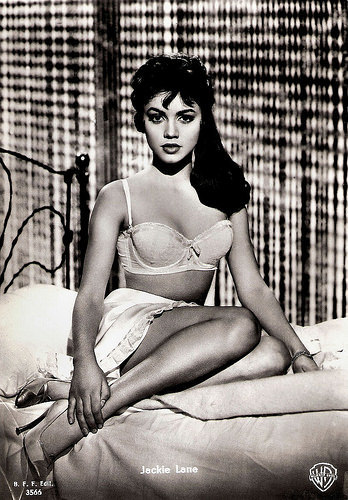
Italian postcard by B.F.F. Edit., no. 3566. Photo: Warner Bros. Publicity still for Tickle Me (Norman Taurog, 1965).
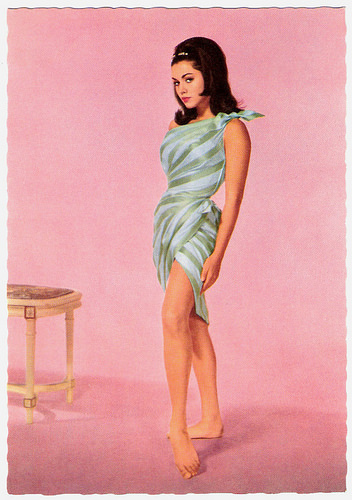
German by ISV, Sort. 11/6.
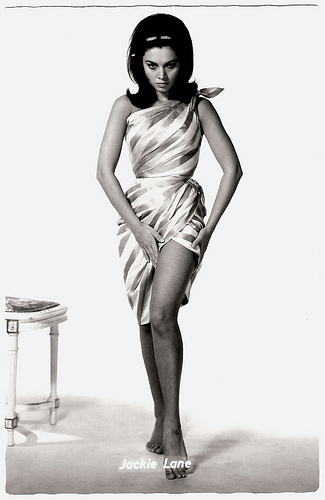
German postcard by Fred. W. Sander-Verlag, Minden / Kolibri, no. 2051.
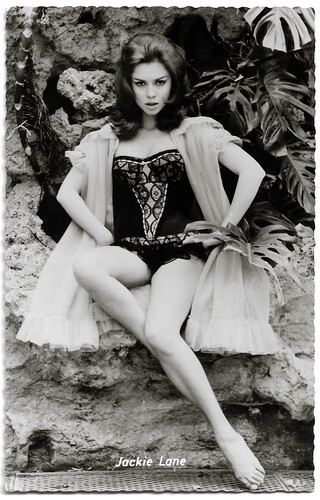
German postcard by Kolibri-Verlag, Minden/Westf., no. 1860.
Not above fibbing about her age
Jackie Lane was born Jocelyn Olga Bolton in Vienna, Austria, in 1937. She is the youngest daughter of a Russian-born pianist mother, Olga Mironova, and an English father, John Bolton, who worked for an American oil firm. She was educated in New Rochelle, New York, in the United States.
At the age of 14, she moved to Britain where she received dance training. Her elder sister, Mara Lane, was a well-known British model and actress in the 1950s. Jocelyn established herself as a popular model in the United Kingdom by the time she was 18, using the pseudonym Jackie Lane.
She appeared on hundreds of magazine covers around the world. H. David Schleicher at IMDb : "Jackie was not above fibbing about her age; in a 1957 photo pictorial by Russ Meyer in Modern Man, the 20-year-old Jackie is referred to as 'Mara's 18-year-old sister'."
From 1954 on, she acted in several British films like the travel film April in Portugal (Euan Lloyd, 1954/1956). She also appeared in the Anglo-American Science Fiction film The Gamma People (John Gilling, 1955) starring Paul Douglas, and the Frankie Vaughan musicals These Dangerous Years (Herbert Wilcox, 1957) and Wonderful Things! (Herbert Wilcox, 1958).
She played a supporting part in The Angry Hills (Robert Aldrich, 1959), based on the novel by Leon Uris, and starring Robert Mitchum . She also appeared in the British thriller Jet Storm (Cy Endfield, 1959), with Richard Attenborough, and the Italian adventure film Robin Hood e i pirati/Robin Hood and the Pirates (Giorgio Simonelli, 1960) starring Lex Barker .
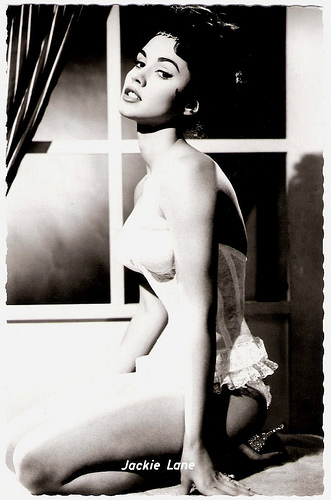
German postcard by Kolibri-Verlag G.m.b.H., Minden-Westf., no. 1266.
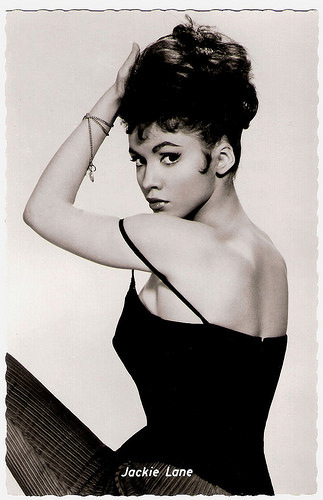
German postcard by Kolibri-Verlag G.m.b.H. Minden/Westf., no. 1614.
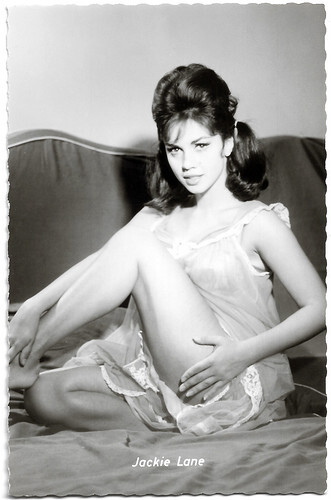
German postcard by Kolibri-Verlag G.m.b.H., Minden/Westf., no. 1745.
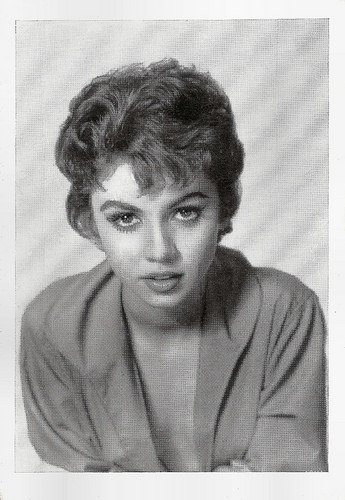
German cigarette card.
Hell's Belle
In the early 1960s, Jackie Lane appeared in several European film productions. She had a supporting part in the drama Aimez-vous Brahms?/Goodbye Again (Anatole Litvak, 1961), starring Ingrid Bergman . The screenplay was written by Samuel A. Taylor, based on the novel by Françoise Sagan.
In Britain, she played in Two and Two Make Six (Freddie Francis, 1962), starring George Chakiris , and the comedy Operation Snatch (Robert Day, 1962) starring Terry-Thomas and George Sanders . In Italy she starred in the Peplums Marte, dio della guerra/Venus Against the Son of Hercules (Marcello Baldi, 1962) opposite Roger Browne, and Le sette folgori di Assur/War Gods of Babylon (Silvio Amadio, 1962), with Howard Duff.
In 1964, Lane moved to Hollywood. As she was confused with another actress named Jackie Lane (known for starring in the TV series Doctor Who), she began to be credited with her full first name, Jocelyn Lane. Her resemblance to Brigitte Bardot was widely remarked upon.
In 1965, Jackie Lane co-starred with Elvis Presley in Tickle Me (Norman Taurog, 1965) and was featured in the September 1966 issue of Playboy magazine. Later, she appeared in several other Hollywood films, including the Western Incident at Phantom Hill (Earl Bellamy, 1966) with Robert Fuller and the action film Hell's Belles (Maury Dexter, 1969), as a biker chick. Her final film was A Bullet for Pretty Boy (Larry Buchana, 1970), starring Fabian Forte as gangster Pretty Boy Floyd. Lane also made guest appearances on American television series. She retired in 1971.
Two years later, she married Prince Alfonso of Hohenlohe-Langenburg, the playboy who turned the Spanish fishing village of Marbella into a glamorous resort. Lane gave birth to her only child, Princess Arriana Theresa Maria of Hohenlohe-Langenburg, in 1975. The divorce with the Prince was settled with $1m. H. David Schleicher: "However, she remains in the memory, literally becoming a fixture of her cinematic times. One image of her, used on the poster of her film Hell's Belles (1969), features a ground-level shot of the 32-year old-Jocelyn (looking all of 22) in a black leather miniskirt and boots, staring haughtily at the camera, an icon of 1960s pop culture."
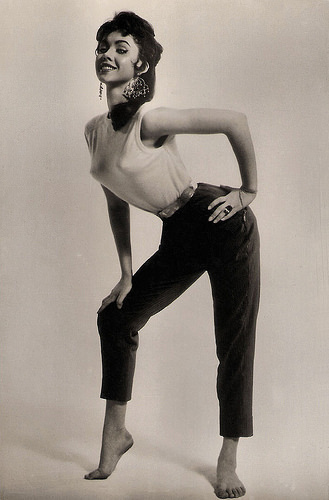
Spanish postcard by Ediciones JRB, no. 201/4. Photo: Mundial Film. Publicity still for The Truth About Women (Muriel Box, 1957).
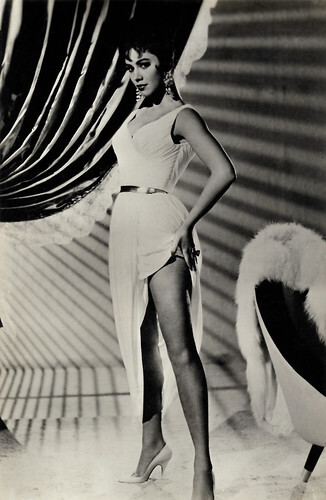
Spanish postcard by Archivo Bermejo, no. 149 / 6579. Photo: Mundial Films. Jackie Lane in The Truth About Women (Muriel Box, 1957).
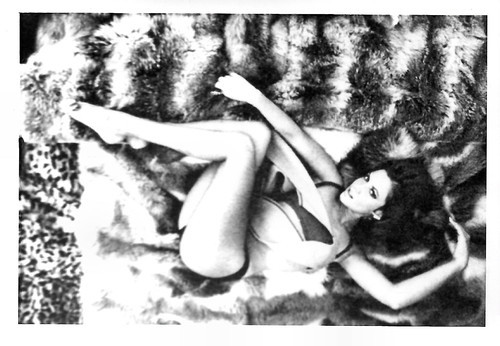
Small Dutch collectors card.
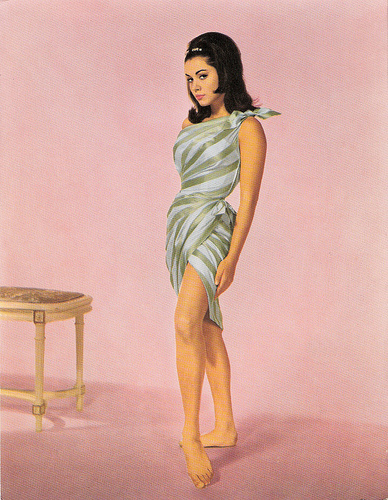
Big German card by ISV, no. PX 4.
Source: (IMDb), Michael Eaude (The Guardian), Wikipedia and.

Italian postcard by B.F.F. Edit., no. 3566. Photo: Warner Bros. Publicity still for Tickle Me (Norman Taurog, 1965).

German by ISV, Sort. 11/6.

German postcard by Fred. W. Sander-Verlag, Minden / Kolibri, no. 2051.

German postcard by Kolibri-Verlag, Minden/Westf., no. 1860.
Not above fibbing about her age
Jackie Lane was born Jocelyn Olga Bolton in Vienna, Austria, in 1937. She is the youngest daughter of a Russian-born pianist mother, Olga Mironova, and an English father, John Bolton, who worked for an American oil firm. She was educated in New Rochelle, New York, in the United States.
At the age of 14, she moved to Britain where she received dance training. Her elder sister, Mara Lane, was a well-known British model and actress in the 1950s. Jocelyn established herself as a popular model in the United Kingdom by the time she was 18, using the pseudonym Jackie Lane.
She appeared on hundreds of magazine covers around the world. H. David Schleicher at IMDb : "Jackie was not above fibbing about her age; in a 1957 photo pictorial by Russ Meyer in Modern Man, the 20-year-old Jackie is referred to as 'Mara's 18-year-old sister'."
From 1954 on, she acted in several British films like the travel film April in Portugal (Euan Lloyd, 1954/1956). She also appeared in the Anglo-American Science Fiction film The Gamma People (John Gilling, 1955) starring Paul Douglas, and the Frankie Vaughan musicals These Dangerous Years (Herbert Wilcox, 1957) and Wonderful Things! (Herbert Wilcox, 1958).
She played a supporting part in The Angry Hills (Robert Aldrich, 1959), based on the novel by Leon Uris, and starring Robert Mitchum . She also appeared in the British thriller Jet Storm (Cy Endfield, 1959), with Richard Attenborough, and the Italian adventure film Robin Hood e i pirati/Robin Hood and the Pirates (Giorgio Simonelli, 1960) starring Lex Barker .

German postcard by Kolibri-Verlag G.m.b.H., Minden-Westf., no. 1266.

German postcard by Kolibri-Verlag G.m.b.H. Minden/Westf., no. 1614.

German postcard by Kolibri-Verlag G.m.b.H., Minden/Westf., no. 1745.

German cigarette card.
Hell's Belle
In the early 1960s, Jackie Lane appeared in several European film productions. She had a supporting part in the drama Aimez-vous Brahms?/Goodbye Again (Anatole Litvak, 1961), starring Ingrid Bergman . The screenplay was written by Samuel A. Taylor, based on the novel by Françoise Sagan.
In Britain, she played in Two and Two Make Six (Freddie Francis, 1962), starring George Chakiris , and the comedy Operation Snatch (Robert Day, 1962) starring Terry-Thomas and George Sanders . In Italy she starred in the Peplums Marte, dio della guerra/Venus Against the Son of Hercules (Marcello Baldi, 1962) opposite Roger Browne, and Le sette folgori di Assur/War Gods of Babylon (Silvio Amadio, 1962), with Howard Duff.
In 1964, Lane moved to Hollywood. As she was confused with another actress named Jackie Lane (known for starring in the TV series Doctor Who), she began to be credited with her full first name, Jocelyn Lane. Her resemblance to Brigitte Bardot was widely remarked upon.
In 1965, Jackie Lane co-starred with Elvis Presley in Tickle Me (Norman Taurog, 1965) and was featured in the September 1966 issue of Playboy magazine. Later, she appeared in several other Hollywood films, including the Western Incident at Phantom Hill (Earl Bellamy, 1966) with Robert Fuller and the action film Hell's Belles (Maury Dexter, 1969), as a biker chick. Her final film was A Bullet for Pretty Boy (Larry Buchana, 1970), starring Fabian Forte as gangster Pretty Boy Floyd. Lane also made guest appearances on American television series. She retired in 1971.
Two years later, she married Prince Alfonso of Hohenlohe-Langenburg, the playboy who turned the Spanish fishing village of Marbella into a glamorous resort. Lane gave birth to her only child, Princess Arriana Theresa Maria of Hohenlohe-Langenburg, in 1975. The divorce with the Prince was settled with $1m. H. David Schleicher: "However, she remains in the memory, literally becoming a fixture of her cinematic times. One image of her, used on the poster of her film Hell's Belles (1969), features a ground-level shot of the 32-year old-Jocelyn (looking all of 22) in a black leather miniskirt and boots, staring haughtily at the camera, an icon of 1960s pop culture."

Spanish postcard by Ediciones JRB, no. 201/4. Photo: Mundial Film. Publicity still for The Truth About Women (Muriel Box, 1957).

Spanish postcard by Archivo Bermejo, no. 149 / 6579. Photo: Mundial Films. Jackie Lane in The Truth About Women (Muriel Box, 1957).

Small Dutch collectors card.

Big German card by ISV, no. PX 4.
Source: (IMDb), Michael Eaude (The Guardian), Wikipedia and.
Published on January 19, 2025 22:00
January 17, 2025
Marion Davies
On the third day of the Netherlands Silent Film Festival, we want to see Lights of Old Broadway (Monta Bell, 1925). Marion Davies (1897-1961) plays a double role as twins who are separated as babies and grow up in different New York families. Davies shines in this film, which is full of drama, romance, joy, and dancing in a city where anything is possible. The American actress starred in nearly four dozen films between 1917 and 1937, but her once glittering career was later overshadowed by Orson Welles' classic Citizen Kane (1941) which viciously portrayed her as a talentless and sad failure, while in fact, she was one of the great comedic actresses of the silent era.
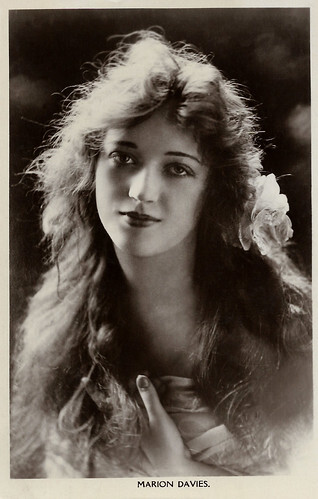
British postcard in the Picturegoer Series, London, no. 113. Co-published by A. Butterworth, Johannesburg.
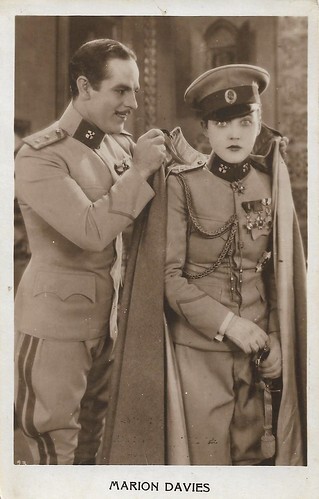
Romanian postcard. Photo: MGM. Marion Davies and Antonio Moreno in Beverly of Graustark (Sidney Franklin, 1926).
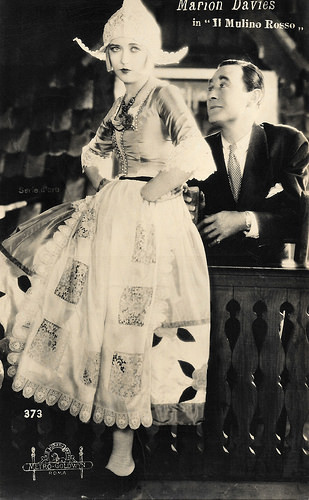
Italian postcard by Casa Editrice Ballerini & Fratini, Firenze (B.F.F. Editore), no. 373. Photo: Metro-Goldwyn, Roma. Publicity still for The Red Mill (Roscoe 'Fatty' Arbuckle (as William Goodrich), 1927) with Owen Moore.
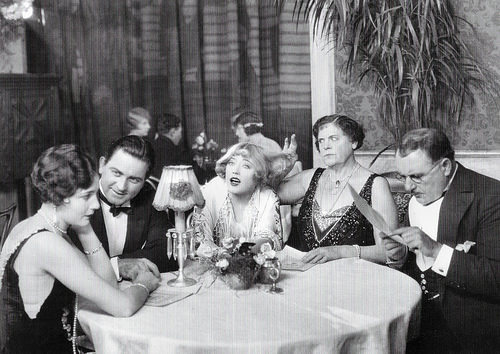
Promotion card for Il Cinema Ritrovato, Bologna, 2017. Photo: publicity still for The Patsy (King Vidor, 1928) with Marion Davies (middle), Jane Winton, Orville Caldwell, Marie Dressler and Dell Henderson.
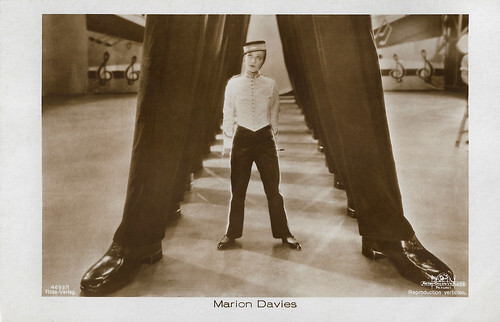
German postcard by Ross Verlag, no. 4693/1, 1929-1930. Photo: Metro-Goldwyn-Mayer. Marion Davies in The Hollywood Revue of 1929 (Charles Reisner, Christy Cabanne, Norman Houston, 1929).
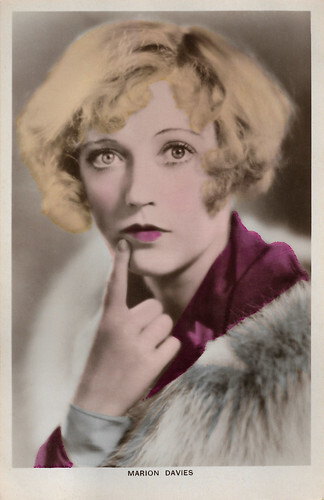
British postcard in the Colourgraph Series, London, no. C 35.
The famous Ziegfeld Follies
Marion Davies was born Marion Cecelia Douras in the borough of Brooklyn, New York in 1897. She had been bitten by the show biz bug early as she watched her sisters perform in local stage productions. She wanted to do the same. As Marion got older, she tried out for various school plays and did fairly well. Once her formal education had ended, Marion began her career as a chorus girl in New York City, first in the Pony Follies and eventually in the famous Ziegfeld Follies.
Her stage name came when she and her family passed the Davies Insurance Building. One of her sisters called out "Davies!!! That shall be my stage name," and the whole family took on that name. Marion wanted more than to dance. Acting, to her, was the epitome of show business and she aimed her sights in that direction. She had met newspaper magnate William Randolph Hearst and went to live with him at his San Simeon castle in California. They would stay together for over 30 years, while Hearst’s wife Millicent resided in New York. Millicent would not grant him a divorce so that he could marry Davies.
San Simeon is a spectacular and elaborate mansion, which now stands as a California landmark. At San Simeon, the couple threw elaborate parties, frequented by all of the top names in Hollywood and other celebrities including the mayor of New York City, President Calvin Coolidge and Charles Lindbergh.
When she was 20, Marion made her first film, Runaway Romany (George W. Lederer, 1917). Written by Marion and directed by her brother-in-law, the film wasn't exactly a box-office smash, but for Marion, it was a start and a stepping stone to bigger things.
The following year Marion starred in The Burden of Proof (John G. Adolfi, Julius Steger, 1918) and Cecilia of the Pink Roses (Julius Steger, 1918). The latter film was backed by William Randolph Hearst. Because of Hearst's newspaper empire, Marion would be promoted as no actress before her. She appeared in numerous films over the next few years, including the superior comedy Getting Mary Married (Allan Dwan, 1919) with Norman Kerry , the suspenseful The Cinema Murder (George D. Baker, 1919) and the drama The Restless Sex (Leon D'Usseau, Robert Z. Leonard, 1920) with Carlyle Blackwell.
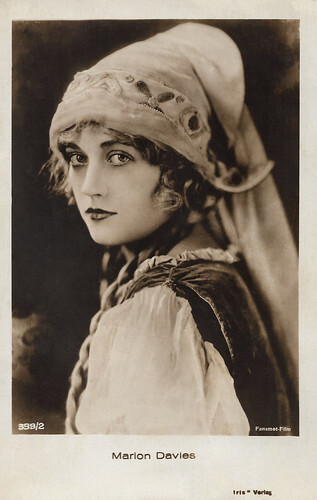
Austrian postcard by Iris Verlag, no. 399/2. Photo: Fanamet-Film. Marion Davies in Yolanda (Robert G. Vignola, 1924).
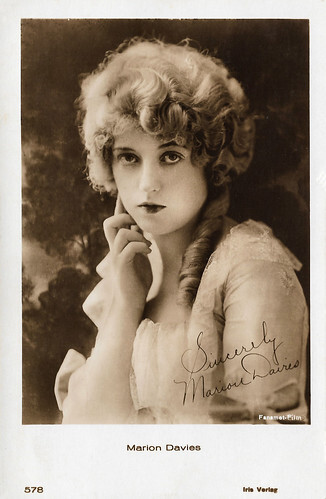
Austrian postcard by Iris-Verlag, no. 578. Photo: Fanamet-Film.
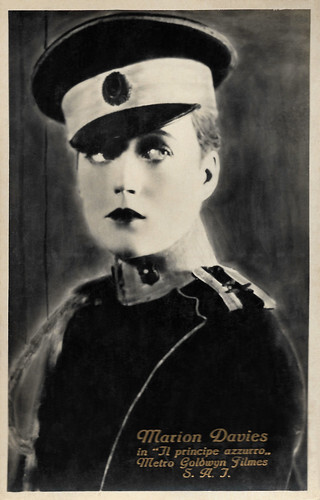
Italian postcard by G.B. Falci Editore, Milano, no. 603. Photo: Metro Goldwyn Films. Marion Davies in Beverly of Graustark (Sidney Franklin, 1926).
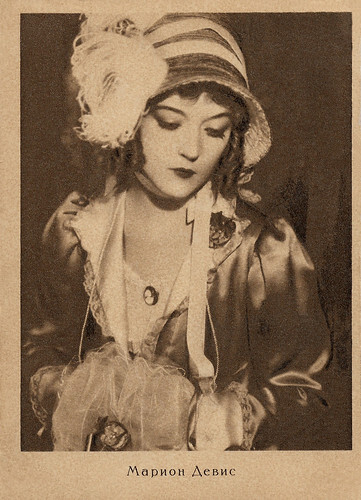
Russian postcard by Goznak, Moscow, no. 8, A-16279, 1928. The card was issued in an edition of 30,000 copies. Marion Davies in Quality Street (Sidney Franklin, 1927).
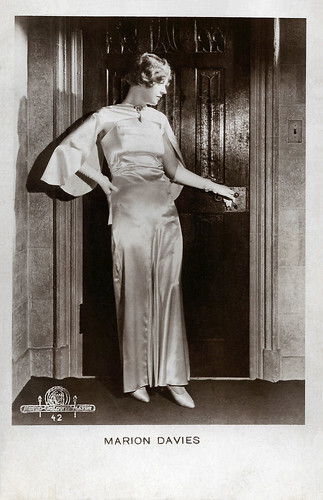
Belgian postcard by P.I.A. Belgaphot, Bruxelles, no. 42. Photo: Metro-Goldwyn-Mayer.
A very sharp and savvy businesswoman
In 1922, Marion Davies appeared as Mary Tudor in the historical romantic epic, When Knighthood Was in Flower (Robert G. Vignola, 1922). It was a film into which Hearst poured millions of dollars as a showcase for her. Although Marion didn't normally appear in period pieces, she turned in a wonderful performance, according to Denny Jackson at IMDb , and the film became a box office hit. Marion remained busy, one of the staples in cinemas around the country. Time after time, film after film, Marion turned in masterful performances. Her best films were the comedies The Patsy (1928) also with Marie Dressler , and Show People (1929) with William Haines , both directed by King Vidor .
At the end of the 1920s, it was obvious that sound films were about to replace the silent films. Marion was nervous because she had a stutter when she became excited and worried she wouldn't make a successful transition to the new medium. But she was a true professional who had no problem with the change. In 1930, two of her better films were Not So Dumb (King Vidor, 1930) and The Florodora Girl (Harry Beaumont, 1930), with Lawrence Grant. By the early 1930s, Marion had lost her box office appeal and the downward slide began. Hearst tried to push MGM executives to hire Marion for the role of Elizabeth Barrett in The Barretts of Wimpole Street (Sidney Franklin, 1934). Louis B. Mayer had other ideas and hired producer Irving Thalberg's wife Norma Shearer instead. Hearst reacted by pulling his newspaper support for MGM without much impact.
By the late 1930s, Hearst suffered financial reversals and Marion bailed him out by selling off $1 million of her jewellery. Hearst's financial problems also spelt the end of her career. Although she made the transition to sound, other stars fared better and her roles became fewer and further between. In 1937, a 40-year-old Marion filmed her last movie, Ever Since Eve (Lloyd Bacon, 1937) with Robert Montgomery . Out of films and with the intense pressures of her relationship with Hearst, Marion turned more and more to alcohol. Despite those problems, Marion was a very sharp and savvy businesswoman.
When Hearst lay dying in 1951 at age 88, Davies was given a sedative by his lawyer. When she awoke several hours later, she discovered that Hearst had passed away and that his associates had removed his body as well as all his belongings and any trace that he had lived there with her. His family had a big formal funeral for him in San Francisco, from which she was banned Later, Marion married for the first time at the age of 54, to Horace Brown. The union would last until she died of cancer in 1961 in Los Angeles, California. She was 64 years old. Upon Marion’s niece Patricia Van Cleve Lake's death, it was revealed she had been the love child of Davies and Hearst.
The love affair of Marion Davies and Hearst was mirrored in the films Citizen Kane (Orson Welles, 1941), RKO 281 (Benjamin Ross, 1999), and The Cat's Meow (Peter Bogdanovich, 2001). In Citizen Kane (1941), the title character's second wife (played by Dorothy Comingore) — an untalented singer whom he tries to promote — was widely assumed to be based on Davies. But many commentators, including Citizen Kane writer/director Orson Welles himself, have defended Davies' record as a gifted actress, to whom Hearst's patronage did more harm than good.
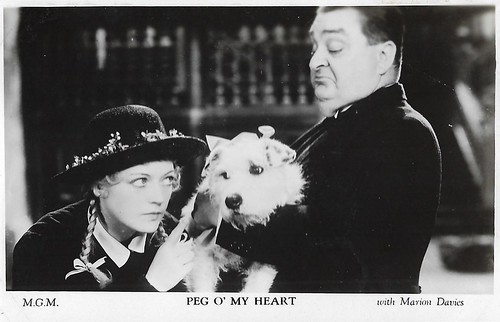
British postcard by Film Weekly. Photo: MGM. Marion Davies as Peg and Robert Greig as butler Jarvis in the Pre-Code movie Peg O'My Heart (Robert Z. Leonard, 1933). Marion Davies stars as a poor Irish girl who stands to inherit a fortune if she satisfies certain conditions. She is taken away from her father and brought to the posh estate of her late grandfather. Within three years she has to learn to become a lady.
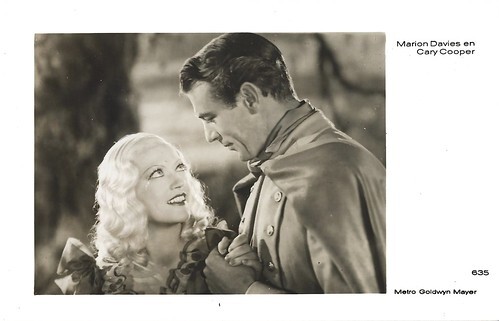
Dutch postcard, editor unknown, no. 635. Photo: Metro-Goldwyn-Mayer. Gary Cooper and Marion Davies in Operator 13 (Richard Boleslawski, 1934).
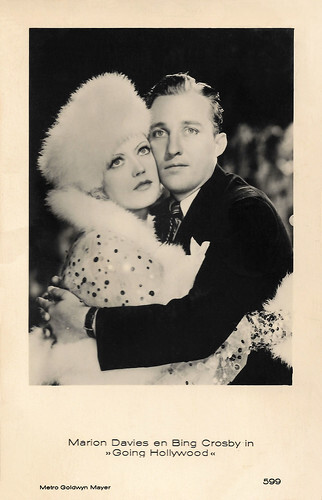
Dutch postcard, no. 599, sent by mail in 1934. Photo: Metro-Goldwyn-Mayer. Marion Davies and Bing Crosby in Going Hollywood (Raoul Walsh, 1933).
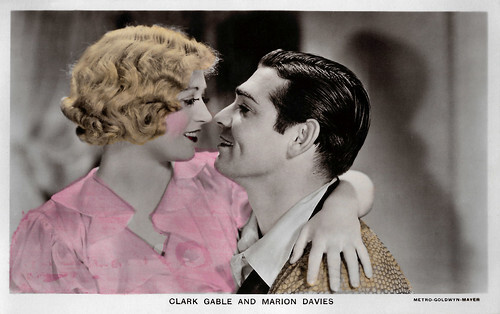
British postcard in the Film Partners Series, London, no. PC 63. Photo: Metro-Goldwyn-Mayer. Clark Gable in Cain and Mabel (Lloyd Bacon, 1936).
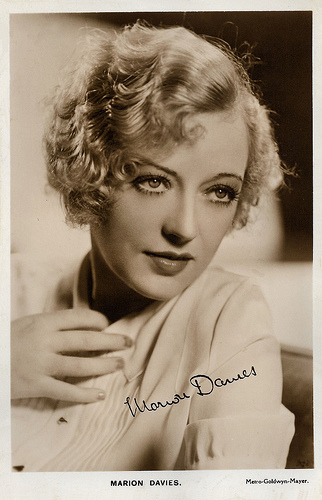
British postcard. Photo: Metro-Goldwyn-Mayer.
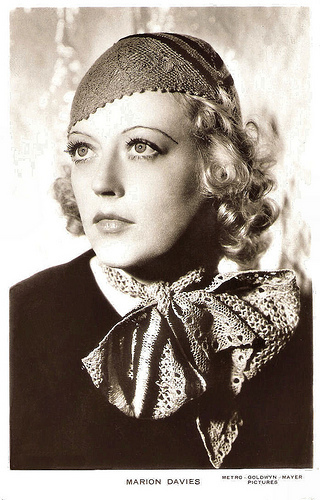
British postcard. Photo: Metro-Goldwyn-Mayer.

French postcard by Europe, no. 666. Photo: Goldwyn Mayer.
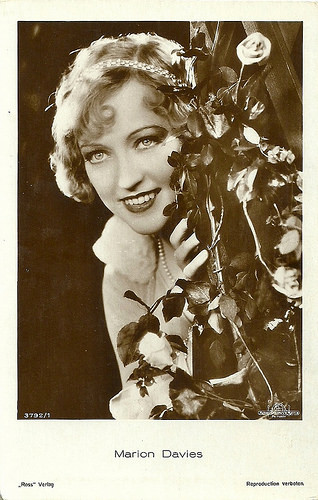
German postcard by Ross Verlag, no. 3732/1, 1928-1929. Photo: Metro-Goldwyn-Mayer.

Italian postcard. Photo: Metro-Goldwyn-Mayer.
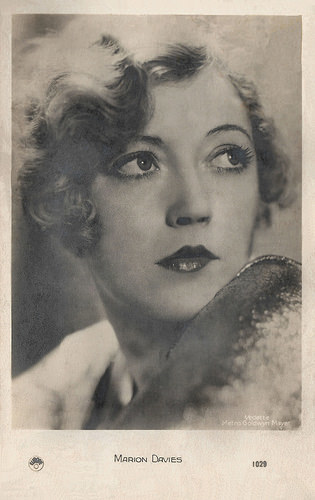
French postcard by Europe, no. 1029. Photo: Metro-Goldwyn-Mayer.
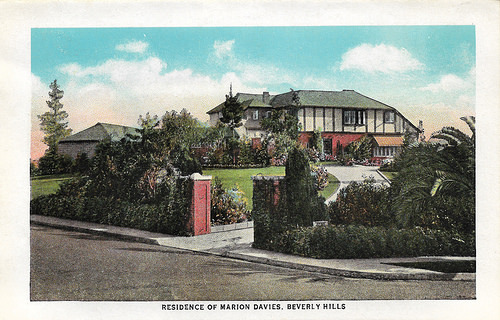
American postcard by C.T. & Co., Chi, in the series Homes of Movie Stars in California. Residence of Marion Davies, Beverly Hills.
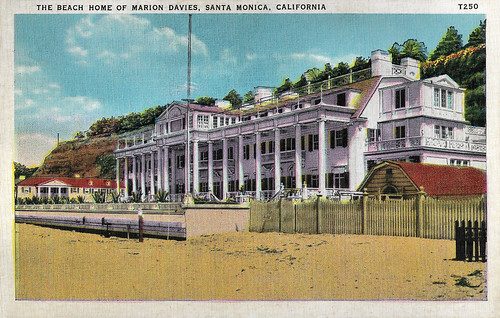
American postcard by Tichnor Art Company, L.A., no. T 250. Caption: The Beach home of Marion Davies, Santa Monica, California.
Sources: Nick Enoch (Mail on Line), (IMDb), Wikipedia and

British postcard in the Picturegoer Series, London, no. 113. Co-published by A. Butterworth, Johannesburg.

Romanian postcard. Photo: MGM. Marion Davies and Antonio Moreno in Beverly of Graustark (Sidney Franklin, 1926).

Italian postcard by Casa Editrice Ballerini & Fratini, Firenze (B.F.F. Editore), no. 373. Photo: Metro-Goldwyn, Roma. Publicity still for The Red Mill (Roscoe 'Fatty' Arbuckle (as William Goodrich), 1927) with Owen Moore.

Promotion card for Il Cinema Ritrovato, Bologna, 2017. Photo: publicity still for The Patsy (King Vidor, 1928) with Marion Davies (middle), Jane Winton, Orville Caldwell, Marie Dressler and Dell Henderson.

German postcard by Ross Verlag, no. 4693/1, 1929-1930. Photo: Metro-Goldwyn-Mayer. Marion Davies in The Hollywood Revue of 1929 (Charles Reisner, Christy Cabanne, Norman Houston, 1929).

British postcard in the Colourgraph Series, London, no. C 35.
The famous Ziegfeld Follies
Marion Davies was born Marion Cecelia Douras in the borough of Brooklyn, New York in 1897. She had been bitten by the show biz bug early as she watched her sisters perform in local stage productions. She wanted to do the same. As Marion got older, she tried out for various school plays and did fairly well. Once her formal education had ended, Marion began her career as a chorus girl in New York City, first in the Pony Follies and eventually in the famous Ziegfeld Follies.
Her stage name came when she and her family passed the Davies Insurance Building. One of her sisters called out "Davies!!! That shall be my stage name," and the whole family took on that name. Marion wanted more than to dance. Acting, to her, was the epitome of show business and she aimed her sights in that direction. She had met newspaper magnate William Randolph Hearst and went to live with him at his San Simeon castle in California. They would stay together for over 30 years, while Hearst’s wife Millicent resided in New York. Millicent would not grant him a divorce so that he could marry Davies.
San Simeon is a spectacular and elaborate mansion, which now stands as a California landmark. At San Simeon, the couple threw elaborate parties, frequented by all of the top names in Hollywood and other celebrities including the mayor of New York City, President Calvin Coolidge and Charles Lindbergh.
When she was 20, Marion made her first film, Runaway Romany (George W. Lederer, 1917). Written by Marion and directed by her brother-in-law, the film wasn't exactly a box-office smash, but for Marion, it was a start and a stepping stone to bigger things.
The following year Marion starred in The Burden of Proof (John G. Adolfi, Julius Steger, 1918) and Cecilia of the Pink Roses (Julius Steger, 1918). The latter film was backed by William Randolph Hearst. Because of Hearst's newspaper empire, Marion would be promoted as no actress before her. She appeared in numerous films over the next few years, including the superior comedy Getting Mary Married (Allan Dwan, 1919) with Norman Kerry , the suspenseful The Cinema Murder (George D. Baker, 1919) and the drama The Restless Sex (Leon D'Usseau, Robert Z. Leonard, 1920) with Carlyle Blackwell.

Austrian postcard by Iris Verlag, no. 399/2. Photo: Fanamet-Film. Marion Davies in Yolanda (Robert G. Vignola, 1924).

Austrian postcard by Iris-Verlag, no. 578. Photo: Fanamet-Film.

Italian postcard by G.B. Falci Editore, Milano, no. 603. Photo: Metro Goldwyn Films. Marion Davies in Beverly of Graustark (Sidney Franklin, 1926).

Russian postcard by Goznak, Moscow, no. 8, A-16279, 1928. The card was issued in an edition of 30,000 copies. Marion Davies in Quality Street (Sidney Franklin, 1927).

Belgian postcard by P.I.A. Belgaphot, Bruxelles, no. 42. Photo: Metro-Goldwyn-Mayer.
A very sharp and savvy businesswoman
In 1922, Marion Davies appeared as Mary Tudor in the historical romantic epic, When Knighthood Was in Flower (Robert G. Vignola, 1922). It was a film into which Hearst poured millions of dollars as a showcase for her. Although Marion didn't normally appear in period pieces, she turned in a wonderful performance, according to Denny Jackson at IMDb , and the film became a box office hit. Marion remained busy, one of the staples in cinemas around the country. Time after time, film after film, Marion turned in masterful performances. Her best films were the comedies The Patsy (1928) also with Marie Dressler , and Show People (1929) with William Haines , both directed by King Vidor .
At the end of the 1920s, it was obvious that sound films were about to replace the silent films. Marion was nervous because she had a stutter when she became excited and worried she wouldn't make a successful transition to the new medium. But she was a true professional who had no problem with the change. In 1930, two of her better films were Not So Dumb (King Vidor, 1930) and The Florodora Girl (Harry Beaumont, 1930), with Lawrence Grant. By the early 1930s, Marion had lost her box office appeal and the downward slide began. Hearst tried to push MGM executives to hire Marion for the role of Elizabeth Barrett in The Barretts of Wimpole Street (Sidney Franklin, 1934). Louis B. Mayer had other ideas and hired producer Irving Thalberg's wife Norma Shearer instead. Hearst reacted by pulling his newspaper support for MGM without much impact.
By the late 1930s, Hearst suffered financial reversals and Marion bailed him out by selling off $1 million of her jewellery. Hearst's financial problems also spelt the end of her career. Although she made the transition to sound, other stars fared better and her roles became fewer and further between. In 1937, a 40-year-old Marion filmed her last movie, Ever Since Eve (Lloyd Bacon, 1937) with Robert Montgomery . Out of films and with the intense pressures of her relationship with Hearst, Marion turned more and more to alcohol. Despite those problems, Marion was a very sharp and savvy businesswoman.
When Hearst lay dying in 1951 at age 88, Davies was given a sedative by his lawyer. When she awoke several hours later, she discovered that Hearst had passed away and that his associates had removed his body as well as all his belongings and any trace that he had lived there with her. His family had a big formal funeral for him in San Francisco, from which she was banned Later, Marion married for the first time at the age of 54, to Horace Brown. The union would last until she died of cancer in 1961 in Los Angeles, California. She was 64 years old. Upon Marion’s niece Patricia Van Cleve Lake's death, it was revealed she had been the love child of Davies and Hearst.
The love affair of Marion Davies and Hearst was mirrored in the films Citizen Kane (Orson Welles, 1941), RKO 281 (Benjamin Ross, 1999), and The Cat's Meow (Peter Bogdanovich, 2001). In Citizen Kane (1941), the title character's second wife (played by Dorothy Comingore) — an untalented singer whom he tries to promote — was widely assumed to be based on Davies. But many commentators, including Citizen Kane writer/director Orson Welles himself, have defended Davies' record as a gifted actress, to whom Hearst's patronage did more harm than good.

British postcard by Film Weekly. Photo: MGM. Marion Davies as Peg and Robert Greig as butler Jarvis in the Pre-Code movie Peg O'My Heart (Robert Z. Leonard, 1933). Marion Davies stars as a poor Irish girl who stands to inherit a fortune if she satisfies certain conditions. She is taken away from her father and brought to the posh estate of her late grandfather. Within three years she has to learn to become a lady.

Dutch postcard, editor unknown, no. 635. Photo: Metro-Goldwyn-Mayer. Gary Cooper and Marion Davies in Operator 13 (Richard Boleslawski, 1934).

Dutch postcard, no. 599, sent by mail in 1934. Photo: Metro-Goldwyn-Mayer. Marion Davies and Bing Crosby in Going Hollywood (Raoul Walsh, 1933).

British postcard in the Film Partners Series, London, no. PC 63. Photo: Metro-Goldwyn-Mayer. Clark Gable in Cain and Mabel (Lloyd Bacon, 1936).

British postcard. Photo: Metro-Goldwyn-Mayer.

British postcard. Photo: Metro-Goldwyn-Mayer.

French postcard by Europe, no. 666. Photo: Goldwyn Mayer.

German postcard by Ross Verlag, no. 3732/1, 1928-1929. Photo: Metro-Goldwyn-Mayer.

Italian postcard. Photo: Metro-Goldwyn-Mayer.

French postcard by Europe, no. 1029. Photo: Metro-Goldwyn-Mayer.

American postcard by C.T. & Co., Chi, in the series Homes of Movie Stars in California. Residence of Marion Davies, Beverly Hills.

American postcard by Tichnor Art Company, L.A., no. T 250. Caption: The Beach home of Marion Davies, Santa Monica, California.
Sources: Nick Enoch (Mail on Line), (IMDb), Wikipedia and
Published on January 17, 2025 22:00
January 16, 2025
Directed by John Ford
On the second day of the Netherlands Silent Film Festival, we salute John Ford (1894-1973), one of the most respected directors in American cinema. Along with D.W. Griffith and Cecil B. DeMille, Ford was one of the first-generation pioneers who created the narrative film in America. In a career of more than 50 years, he directed over 130 films between 1917 and 1970 although most of his over sixty silent films are now lost. The NSSF presents today his silent Western 3 Bad Men (1926).
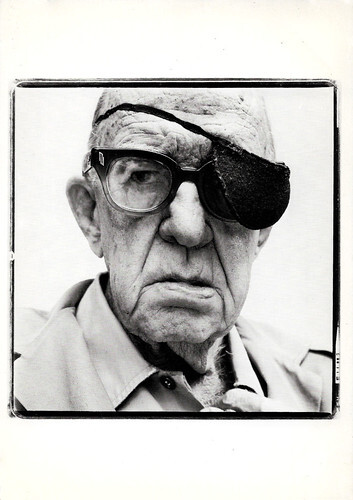
American postcard by Fotofolio, NY, NY, no. RA26. Photo: Richard Avedon. Caption: John Ford, Director, Bel Air, California, 4-11-72.
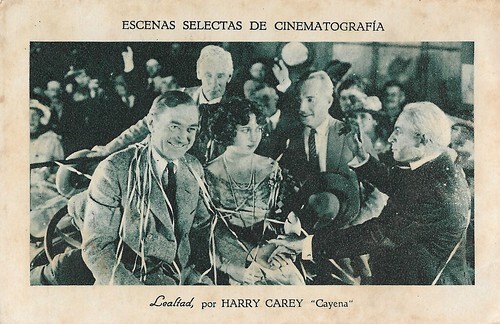
Spanish collector card in the 'Escenas selectas de cinematografia' series, series A, no. 12. Harry Carey in Three Mounted Men (John Ford, 1918). 'Cayena' refers to Carey's regular character Cheyenne Harry (Marked Men (1919), A Gun Fightin' Gentleman (1919), Ace of the Dalle (1919), etc.). The Spanish release title Lealtad (Loyalty) refers to this lost Western Three Mounted Men (1918).
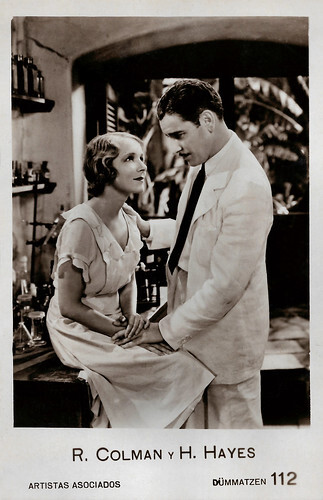
Spanish postcard by Dümmatzen, no. 112. Photo: United Artists. Ronald Colman and Helen Hayes in Arrowsmith (John Ford, 1931).
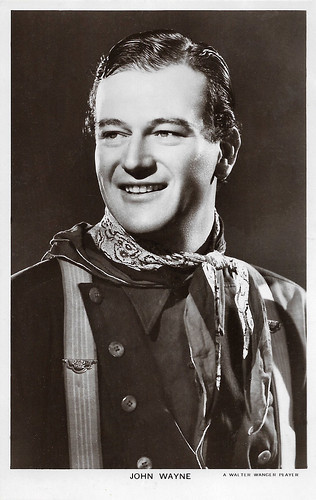
British postcard in the Picturegoer Series, London, no. 797b. Photo: Walter Wanger. John Wayne in Stagecoach (John Ford, 1939).
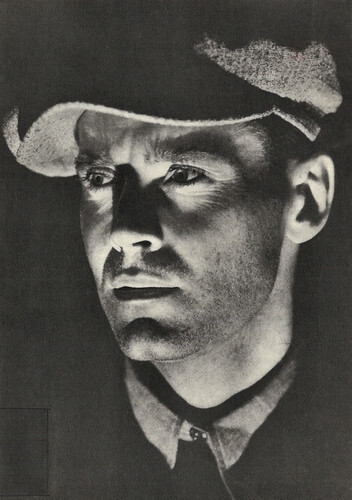
French postcard by Humour à la Carte, Paris, no. 3400. Henry Fonda in The Grapes of Wrath (John Ford, 1940).
A large, long and difficult production
John Ford was born John Martin Feeney in 1894 in Cape Elizabeth, Maine, which is just south of Portland. His parents, John Augustine Feeney and Barbara Curran, were Irish immigrants who arrived in the United States in 1872. They had 11 children in all, six of whom lived to adulthood. John was their tenth child, born between a girl and a boy who both died as infants. A saloon keeper and an alderman, the Feeney family pater familias was a stereotypical Irish American, dabbling in both booze and politics in Portland, where John attended high school.
John Feeney followed his older brother Frank, who had renamed himself Francis Ford, to Hollywood. Frank, who was 13 years John's senior, had started as a film actor in 1909 and eventually appeared in about 500 films. He also established himself as a film director, helming almost 200 films beginning in 1912, when he shot Western shorts for Thomas H. Ince at Bison Motion Pictures. Ford started in his brother's films as an assistant, handyman, and stuntman. Francis gave his younger brother his first acting role in The Mysterious Rose (1914).
Renaming himself Jack Ford, John Feeney acted in 15 of his brother's pictures from 1914 through 1916. He also appeared as a member of the Ku Klux Klan in D.W. Griffith 's The Birth of a Nation (1915), the American cinema's first certifiable blockbuster. The film was banned in Boston to forestall the possibility of its inciting racial violence and is still controversial. Young Jack Ford began to exit his brother's orbit and establish himself on his own when he moved from Bison to Universal as a director. It was by directing films from behind the camera instead of acting in them before the camera that he made his reputation.
Ford's first feature-length production was Straight Shooting (1917) with Harry Carey , which is also his earliest complete surviving film as director. He was extraordinarily productive in his first few years as a director — he made ten films in 1917, eight in 1918 and fifteen in 1919. When his Western Hell Bent (1918) for Universal was released, Motion Picture News praised Ford's direction, writing, "Few directors put such sustained punch in their pictures as does this Mr. Ford." It was the ninth in a series of films featuring Harry Carey as Cheyenne Harry. Carey was the star of 25 Ford silent films. His feature Cameo Kirby (1923), starring screen idol John Gilbert - another of the few surviving Ford silents - marked his first directing credit under the name 'John Ford'.
A year later, he directed his first masterpiece, the Western The Iron Horse (1924), an epic account of the building of the First transcontinental railroad. It was a large, long and difficult production, filmed on location in the Sierra Nevada. The logistics were enormous—two entire towns were constructed, there were 5000 extras, 100 cooks, 2000 rail layers, a cavalry regiment, 800 Native Americans, 1300 bison, 2000 horses, 10,000 cattle and 50,000 properties, including the original stagecoach used by Horace Greeley, Wild Bill Hickok's derringer pistol and replicas of the 'Jupiter' and '119' locomotives that met at Promontory Summit when the two ends of the line were joined in 1869. The Iron Horse became one of the top-grossing films of the decade, taking over US$2 million worldwide, against a budget of $280,000. Ford made a wide range of films in this period, and he became well known for his Western and 'frontier' pictures, but the genre rapidly lost its appeal for major studios in the late 1920s. Ford's last silent Western was 3 Bad Men (1926). Only ten of the more than sixty silent films John Ford made between 1917 and 1928 still survive in their entirety.

British postcard. Photo: Columbia. Jean Arthur in The Whole Town’s Talking (John Ford, 1935). Collection: Marlene Pilaete. Passport to Fame was the British premiere title.
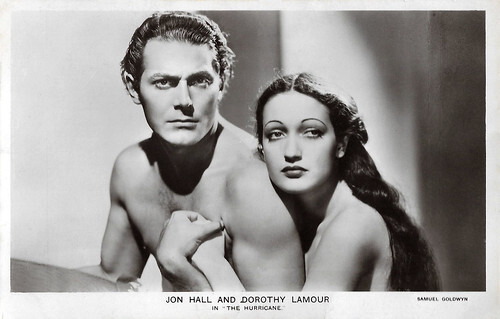
British Real Photograph postcard, London, no. FS 121. Photo: Samuel Goldwyn. Jon Hall and Dorothy Lamour for The Hurricane (John Ford, 1937).
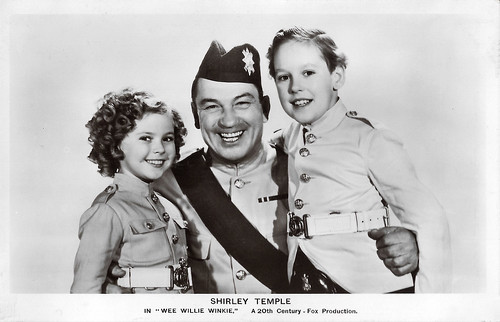
British Real Photograph postcard, London, no. FS 108. Photo: 20th Century Fox Film. Shirley Temple , Victor McLaglen and Douglas Scott in Wee Willie Winkie (John Ford, 1937).
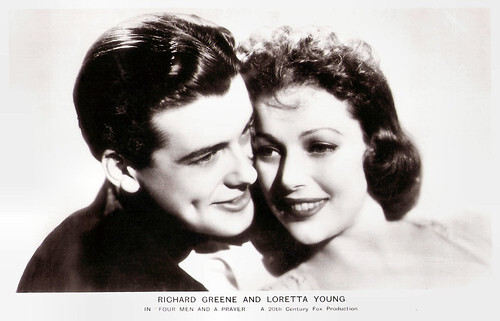
British postcard in the Picturegoer Series, London, no. FS 163. Photo: 20th Century Fox. Richard Greene and Loretta Young in Four Men and a Prayer (John Ford, 1938).
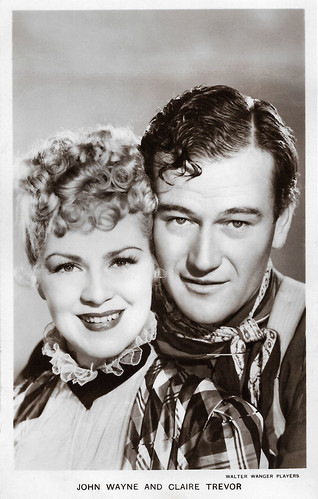
British postcard in the Film Partners Series, London, no. P 289. Photo: Walter Wanger. John Wayne and Claire Trevor in Stagecoach (John Ford, 1939).
Exploding industry prejudices by becoming both a critical and commercial hit
John Ford was one of the pioneer directors of sound films. He shot Fox's first song sung on screen, for his film Mother Machree (1928). In the 1930s, Ford began to create the body of work that established his greatness while working for production chief Darryl F. Zanuck at 20th Century Fox. Ford worked with the studio's two superstars, Shirley Temple and Will Rogers , the #1 and #2 draws at the box office. He won his first Oscar for R.K.O.'s The Informer (1935). The film also earned an Academy Award nomination for Best Picture and garnered a Best Actor Oscar for long-time Ford collaborator Victor McLaglen . Ford was a master of many genres, and even directed comedies such as Will Rogers 's Steamboat Round the Bend (1935).
The politically charged The Prisoner of Shark Island (1936) — which marked the debut with Ford of long-serving 'Stock Company' player John Carradine — explored the little-known story of Samuel Mudd, a physician who was caught up in the Abraham Lincoln assassination conspiracy and consigned to an offshore prison for treating the injured John Wilkes Booth. He directed the South Seas melodrama The Hurricane (1937) and the lighthearted Shirley Temple vehicle Wee Willie Winkie (1937), each of which had a first-year US gross of more than $1 million.
John Ford directed contemporary dramas and historical epics, but strangely, he stayed away from the Western, except for Stagecoach (1939). The genre had fallen out of favour with the big studios during the 1930s and Westerns were regarded as B-grade 'pulp' movies at best. As a result, Ford shopped the project around Hollywood for almost a year. Stagecoach exploded industry prejudices by becoming both a critical and commercial hit, grossing over US$1 million in its first year (against a budget of just under $400,000), and its success helped to revitalise the moribund genre, showing that Westerns could be "intelligent, artful, great entertainment—and profitable". Stagecoach was nominated for seven Academy Awards, including Best Picture and Best Director, and won two Oscars, for Best Supporting Actor (Thomas Mitchell) and Best Score. The classic created the cliché of the drunken doctor (Thomas Mitchell) in an action film.
In the 1940s, Ford won back-to-back Best Director Oscars for The Grapes of Wrath (1941), the screen adaptation of John Steinbeck's Pulitzer Prize-winning novel and How Green Was My Valley (1942), based on Richard Llewellyn's memoir of his youth in the coal-mining region of Wales. Ford had sat out the First World War, the War to End All Wars, but in the 1930s, John Ford had joined the U.S. Naval Reserve as the country once again moved towards participation in a European war that seemed inevitable with the rise of Hitler in Germany. When the U.S. entered World War II after the Japanese attack on Pearl Harbor, Ford went on active duty and headed a documentary film unit. For his Navy documentaries, he won back-to-back Academy Awards for The Battle of Midway (1942) in 1943 and for December 7th (1943) in 1944. Thus, from 1941 through 1944, John Ford won an Oscar each year for directing two feature films and two documentaries, a feat which remains unprecedented.
In the mid-1940s, John Ford began to focus on Westerns again, beginning with My Darling Clementine (1946) starring Linda Darnell and Henry Fonda , one of the classics of the genre. In his Westerns, he made frequent use of location shooting and wide shots, in which his characters were framed against a vast, harsh, and rugged natural terrain. Many of his Westerns featured John Wayne , whom he had first worked with on Stagecoach (1939) and who became a superstar in Howard Hawks ' classic oater Red River (1948) opposite Montgomery Clift . For Ford, Wayne appeared in Fort Apache (1948), She Wore a Yellow Ribbon (1949) and Rio Grande (1950), the famous 'Cavalry Trilogy.'
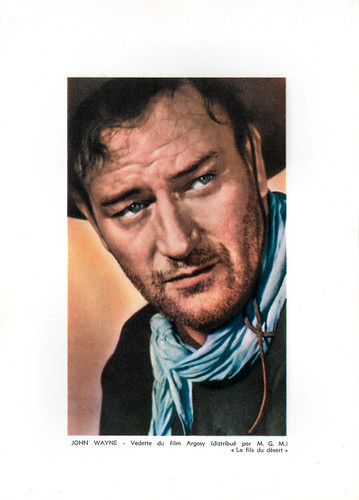
Belgian collectors card. Photo: Argosy / M.G.M. John Wayne in 3 Godfathers (John Ford, 1948).
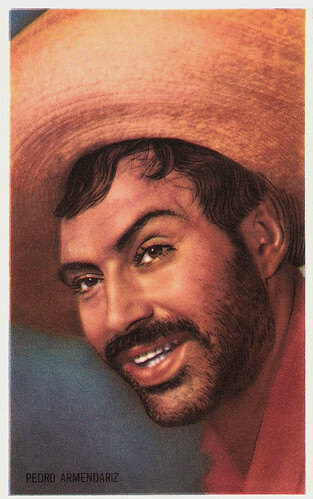
Mexican collector card. Photo: Pedro Armendáriz in 3 Godfathers (John Ford, 1948).
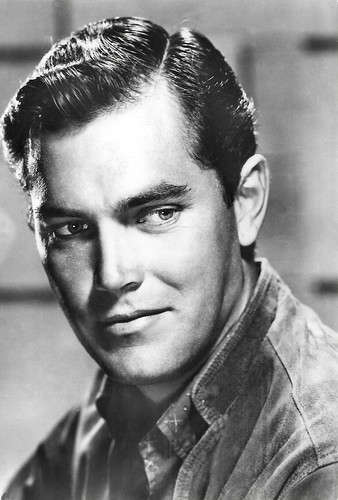
Spanish postcard by Ediciones Raker, Barcelona, no. 129. Photo: Warner Bros. Jeffrey Hunter in Sergeant Rutledge (John Ford, 1960).
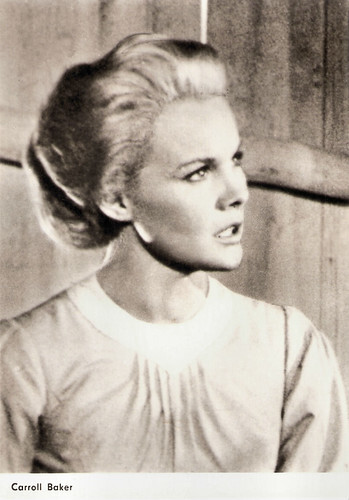
East-German postcard by VEB Progress Film-Vertrieb, Berlin, no. 3143, 1968. Retail price: 0,20 M. Photo: Carroll Baker in Cheyenne Autumn (John Ford, 1964).
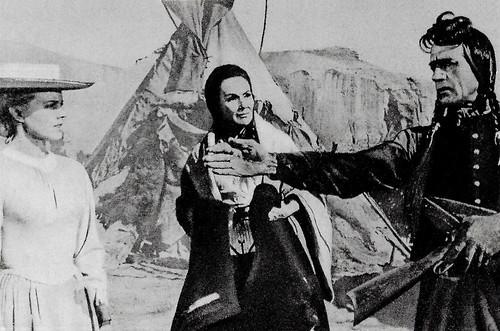
East-German collector card in the 'Neu im Kino' series by VEB Progress Film-Vertrieb, Berlin, no. 500/6/68. Carroll Baker , Dolores del Río and Ricardo Montalban in Cheyenne Autumn (John Ford, 1964).
The perfect correlative for Hollywood myth-making
John Ford directed sixteen features and several documentaries in the decade between 1946 and 1956. As with his pre-war career, his films alternated between (relative) box office flops and major successes, but most of his later films made a solid profit. In 1953, Ford won his sixth Best Director Oscar for his paean to the Ireland of his parents, The Quiet Man (1952), starring John Wayne and Maureen O'Hara .
It's notable that from 1950 through 1959, Ford made only one Western, the classic The Searchers (1956), one of the greatest examples of the genre. Starting with The Horse Soldiers (1959) which he made for the Mirisch Co. at the end of the decade, six of his last eight completed films were Westerns. His final great Western was The Man Who Shot Liberty Valance (1962) starring James Stewart and John Wayne .
Jon Hopwood at IMDb : "Ford was plumbing the nature of American myth-making, and the creation of history as a historical narrative, that is, the re-creation of history, after the fact, i.e., history as something man-made, thus fallible. He had found the perfect correlative for Hollywood myth-making." The Man Who Shot Liberty Valance (1962) took on these issues with a literalness that caused many contemporary critics to dismiss the film. Donovan's Reef (1963) was Ford's last film with John Wayne . Filmed on location on the Hawaiian island of Kauai, it was a morality play disguised as an action-comedy, which subtly but sharply engaged with issues of racial bigotry, corporate connivance, greed and American beliefs of societal superiority. The supporting cast included Lee Marvin , Elizabeth Allen, Jack Warden, Dorothy Lamour , and Cesar Romero. It was also Ford's last commercial success, grossing $3.3 million against a budget of $2.6 million.
Cheyenne Autumn (1964) was Ford's epic farewell to the West, which he publicly declared to be an elegy to the Native Americans. It was his last Western, his longest film and the most expensive movie of his career ($4.2 million), but it failed to recoup its costs at the box office and lost about $1 million on its first release. Ford's last completed feature film was 7 Women (1966), a drama set in about 1935, about missionary women in China trying to protect themselves from the advances of a barbaric Mongolian warlord. Anne Bancroft took over the lead role from Patricia Neal, who suffered a near-fatal stroke two days into the shooting.
Ford's health deteriorated rapidly in the early 1970s; he suffered a broken hip in 1970 which put him in a wheelchair. As befitted his status as America's premier director, in 1973, John Ford was the recipient of the first Lifetime Achievement Award from the American Film Institute. President Richard Nixon presented Ford with the Presidential Medal of Freedom, the highest civilian award in the U.S. Ford died in 1973, at Palm Desert and was interred in Holy Cross Cemetery in Culver City, California. John Ford had one wife, Mary Ford-McBride Smith, a son, Patrick Ford, and a daughter, Barbara Ford. His grandson, Dan Ford wrote a biography on his famous grandfather.
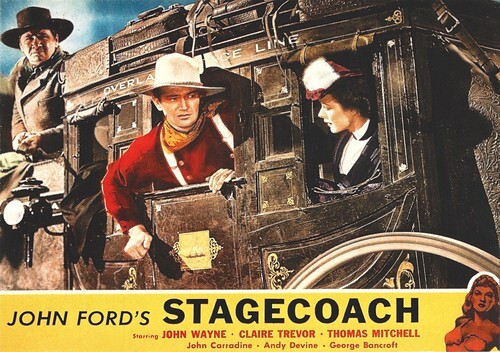
British poster postcard by Pyramid, London, no. PC 8499. Photo: United Artists. John Wayne in the classic Western Stagecoach (John Ford, 1939).
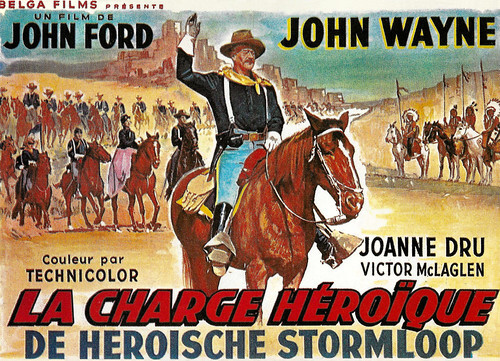
French poster postcard by Edition F. Nugeron, no. E 64. Photo: Belga Films. Belgian poster for the classic Western She Wore a Yellow Ribbon (John Ford, 1949) with John Wayne .
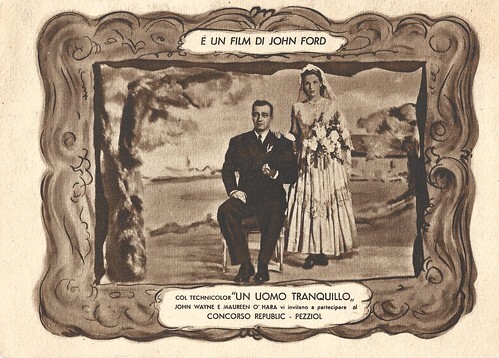
Italian collector card by G.B. Pezziol, Padova / Stab. Pezzini, Milano. Photo: Republic Pictures. John Wayne and Maureen O'Hara in The Quiet Man (John Ford, 1952), released in Italy as Un uomo tranquillo.
Sources: (IMDb), Wikipedia and .

American postcard by Fotofolio, NY, NY, no. RA26. Photo: Richard Avedon. Caption: John Ford, Director, Bel Air, California, 4-11-72.

Spanish collector card in the 'Escenas selectas de cinematografia' series, series A, no. 12. Harry Carey in Three Mounted Men (John Ford, 1918). 'Cayena' refers to Carey's regular character Cheyenne Harry (Marked Men (1919), A Gun Fightin' Gentleman (1919), Ace of the Dalle (1919), etc.). The Spanish release title Lealtad (Loyalty) refers to this lost Western Three Mounted Men (1918).

Spanish postcard by Dümmatzen, no. 112. Photo: United Artists. Ronald Colman and Helen Hayes in Arrowsmith (John Ford, 1931).

British postcard in the Picturegoer Series, London, no. 797b. Photo: Walter Wanger. John Wayne in Stagecoach (John Ford, 1939).

French postcard by Humour à la Carte, Paris, no. 3400. Henry Fonda in The Grapes of Wrath (John Ford, 1940).
A large, long and difficult production
John Ford was born John Martin Feeney in 1894 in Cape Elizabeth, Maine, which is just south of Portland. His parents, John Augustine Feeney and Barbara Curran, were Irish immigrants who arrived in the United States in 1872. They had 11 children in all, six of whom lived to adulthood. John was their tenth child, born between a girl and a boy who both died as infants. A saloon keeper and an alderman, the Feeney family pater familias was a stereotypical Irish American, dabbling in both booze and politics in Portland, where John attended high school.
John Feeney followed his older brother Frank, who had renamed himself Francis Ford, to Hollywood. Frank, who was 13 years John's senior, had started as a film actor in 1909 and eventually appeared in about 500 films. He also established himself as a film director, helming almost 200 films beginning in 1912, when he shot Western shorts for Thomas H. Ince at Bison Motion Pictures. Ford started in his brother's films as an assistant, handyman, and stuntman. Francis gave his younger brother his first acting role in The Mysterious Rose (1914).
Renaming himself Jack Ford, John Feeney acted in 15 of his brother's pictures from 1914 through 1916. He also appeared as a member of the Ku Klux Klan in D.W. Griffith 's The Birth of a Nation (1915), the American cinema's first certifiable blockbuster. The film was banned in Boston to forestall the possibility of its inciting racial violence and is still controversial. Young Jack Ford began to exit his brother's orbit and establish himself on his own when he moved from Bison to Universal as a director. It was by directing films from behind the camera instead of acting in them before the camera that he made his reputation.
Ford's first feature-length production was Straight Shooting (1917) with Harry Carey , which is also his earliest complete surviving film as director. He was extraordinarily productive in his first few years as a director — he made ten films in 1917, eight in 1918 and fifteen in 1919. When his Western Hell Bent (1918) for Universal was released, Motion Picture News praised Ford's direction, writing, "Few directors put such sustained punch in their pictures as does this Mr. Ford." It was the ninth in a series of films featuring Harry Carey as Cheyenne Harry. Carey was the star of 25 Ford silent films. His feature Cameo Kirby (1923), starring screen idol John Gilbert - another of the few surviving Ford silents - marked his first directing credit under the name 'John Ford'.
A year later, he directed his first masterpiece, the Western The Iron Horse (1924), an epic account of the building of the First transcontinental railroad. It was a large, long and difficult production, filmed on location in the Sierra Nevada. The logistics were enormous—two entire towns were constructed, there were 5000 extras, 100 cooks, 2000 rail layers, a cavalry regiment, 800 Native Americans, 1300 bison, 2000 horses, 10,000 cattle and 50,000 properties, including the original stagecoach used by Horace Greeley, Wild Bill Hickok's derringer pistol and replicas of the 'Jupiter' and '119' locomotives that met at Promontory Summit when the two ends of the line were joined in 1869. The Iron Horse became one of the top-grossing films of the decade, taking over US$2 million worldwide, against a budget of $280,000. Ford made a wide range of films in this period, and he became well known for his Western and 'frontier' pictures, but the genre rapidly lost its appeal for major studios in the late 1920s. Ford's last silent Western was 3 Bad Men (1926). Only ten of the more than sixty silent films John Ford made between 1917 and 1928 still survive in their entirety.

British postcard. Photo: Columbia. Jean Arthur in The Whole Town’s Talking (John Ford, 1935). Collection: Marlene Pilaete. Passport to Fame was the British premiere title.

British Real Photograph postcard, London, no. FS 121. Photo: Samuel Goldwyn. Jon Hall and Dorothy Lamour for The Hurricane (John Ford, 1937).

British Real Photograph postcard, London, no. FS 108. Photo: 20th Century Fox Film. Shirley Temple , Victor McLaglen and Douglas Scott in Wee Willie Winkie (John Ford, 1937).

British postcard in the Picturegoer Series, London, no. FS 163. Photo: 20th Century Fox. Richard Greene and Loretta Young in Four Men and a Prayer (John Ford, 1938).

British postcard in the Film Partners Series, London, no. P 289. Photo: Walter Wanger. John Wayne and Claire Trevor in Stagecoach (John Ford, 1939).
Exploding industry prejudices by becoming both a critical and commercial hit
John Ford was one of the pioneer directors of sound films. He shot Fox's first song sung on screen, for his film Mother Machree (1928). In the 1930s, Ford began to create the body of work that established his greatness while working for production chief Darryl F. Zanuck at 20th Century Fox. Ford worked with the studio's two superstars, Shirley Temple and Will Rogers , the #1 and #2 draws at the box office. He won his first Oscar for R.K.O.'s The Informer (1935). The film also earned an Academy Award nomination for Best Picture and garnered a Best Actor Oscar for long-time Ford collaborator Victor McLaglen . Ford was a master of many genres, and even directed comedies such as Will Rogers 's Steamboat Round the Bend (1935).
The politically charged The Prisoner of Shark Island (1936) — which marked the debut with Ford of long-serving 'Stock Company' player John Carradine — explored the little-known story of Samuel Mudd, a physician who was caught up in the Abraham Lincoln assassination conspiracy and consigned to an offshore prison for treating the injured John Wilkes Booth. He directed the South Seas melodrama The Hurricane (1937) and the lighthearted Shirley Temple vehicle Wee Willie Winkie (1937), each of which had a first-year US gross of more than $1 million.
John Ford directed contemporary dramas and historical epics, but strangely, he stayed away from the Western, except for Stagecoach (1939). The genre had fallen out of favour with the big studios during the 1930s and Westerns were regarded as B-grade 'pulp' movies at best. As a result, Ford shopped the project around Hollywood for almost a year. Stagecoach exploded industry prejudices by becoming both a critical and commercial hit, grossing over US$1 million in its first year (against a budget of just under $400,000), and its success helped to revitalise the moribund genre, showing that Westerns could be "intelligent, artful, great entertainment—and profitable". Stagecoach was nominated for seven Academy Awards, including Best Picture and Best Director, and won two Oscars, for Best Supporting Actor (Thomas Mitchell) and Best Score. The classic created the cliché of the drunken doctor (Thomas Mitchell) in an action film.
In the 1940s, Ford won back-to-back Best Director Oscars for The Grapes of Wrath (1941), the screen adaptation of John Steinbeck's Pulitzer Prize-winning novel and How Green Was My Valley (1942), based on Richard Llewellyn's memoir of his youth in the coal-mining region of Wales. Ford had sat out the First World War, the War to End All Wars, but in the 1930s, John Ford had joined the U.S. Naval Reserve as the country once again moved towards participation in a European war that seemed inevitable with the rise of Hitler in Germany. When the U.S. entered World War II after the Japanese attack on Pearl Harbor, Ford went on active duty and headed a documentary film unit. For his Navy documentaries, he won back-to-back Academy Awards for The Battle of Midway (1942) in 1943 and for December 7th (1943) in 1944. Thus, from 1941 through 1944, John Ford won an Oscar each year for directing two feature films and two documentaries, a feat which remains unprecedented.
In the mid-1940s, John Ford began to focus on Westerns again, beginning with My Darling Clementine (1946) starring Linda Darnell and Henry Fonda , one of the classics of the genre. In his Westerns, he made frequent use of location shooting and wide shots, in which his characters were framed against a vast, harsh, and rugged natural terrain. Many of his Westerns featured John Wayne , whom he had first worked with on Stagecoach (1939) and who became a superstar in Howard Hawks ' classic oater Red River (1948) opposite Montgomery Clift . For Ford, Wayne appeared in Fort Apache (1948), She Wore a Yellow Ribbon (1949) and Rio Grande (1950), the famous 'Cavalry Trilogy.'

Belgian collectors card. Photo: Argosy / M.G.M. John Wayne in 3 Godfathers (John Ford, 1948).

Mexican collector card. Photo: Pedro Armendáriz in 3 Godfathers (John Ford, 1948).

Spanish postcard by Ediciones Raker, Barcelona, no. 129. Photo: Warner Bros. Jeffrey Hunter in Sergeant Rutledge (John Ford, 1960).

East-German postcard by VEB Progress Film-Vertrieb, Berlin, no. 3143, 1968. Retail price: 0,20 M. Photo: Carroll Baker in Cheyenne Autumn (John Ford, 1964).

East-German collector card in the 'Neu im Kino' series by VEB Progress Film-Vertrieb, Berlin, no. 500/6/68. Carroll Baker , Dolores del Río and Ricardo Montalban in Cheyenne Autumn (John Ford, 1964).
The perfect correlative for Hollywood myth-making
John Ford directed sixteen features and several documentaries in the decade between 1946 and 1956. As with his pre-war career, his films alternated between (relative) box office flops and major successes, but most of his later films made a solid profit. In 1953, Ford won his sixth Best Director Oscar for his paean to the Ireland of his parents, The Quiet Man (1952), starring John Wayne and Maureen O'Hara .
It's notable that from 1950 through 1959, Ford made only one Western, the classic The Searchers (1956), one of the greatest examples of the genre. Starting with The Horse Soldiers (1959) which he made for the Mirisch Co. at the end of the decade, six of his last eight completed films were Westerns. His final great Western was The Man Who Shot Liberty Valance (1962) starring James Stewart and John Wayne .
Jon Hopwood at IMDb : "Ford was plumbing the nature of American myth-making, and the creation of history as a historical narrative, that is, the re-creation of history, after the fact, i.e., history as something man-made, thus fallible. He had found the perfect correlative for Hollywood myth-making." The Man Who Shot Liberty Valance (1962) took on these issues with a literalness that caused many contemporary critics to dismiss the film. Donovan's Reef (1963) was Ford's last film with John Wayne . Filmed on location on the Hawaiian island of Kauai, it was a morality play disguised as an action-comedy, which subtly but sharply engaged with issues of racial bigotry, corporate connivance, greed and American beliefs of societal superiority. The supporting cast included Lee Marvin , Elizabeth Allen, Jack Warden, Dorothy Lamour , and Cesar Romero. It was also Ford's last commercial success, grossing $3.3 million against a budget of $2.6 million.
Cheyenne Autumn (1964) was Ford's epic farewell to the West, which he publicly declared to be an elegy to the Native Americans. It was his last Western, his longest film and the most expensive movie of his career ($4.2 million), but it failed to recoup its costs at the box office and lost about $1 million on its first release. Ford's last completed feature film was 7 Women (1966), a drama set in about 1935, about missionary women in China trying to protect themselves from the advances of a barbaric Mongolian warlord. Anne Bancroft took over the lead role from Patricia Neal, who suffered a near-fatal stroke two days into the shooting.
Ford's health deteriorated rapidly in the early 1970s; he suffered a broken hip in 1970 which put him in a wheelchair. As befitted his status as America's premier director, in 1973, John Ford was the recipient of the first Lifetime Achievement Award from the American Film Institute. President Richard Nixon presented Ford with the Presidential Medal of Freedom, the highest civilian award in the U.S. Ford died in 1973, at Palm Desert and was interred in Holy Cross Cemetery in Culver City, California. John Ford had one wife, Mary Ford-McBride Smith, a son, Patrick Ford, and a daughter, Barbara Ford. His grandson, Dan Ford wrote a biography on his famous grandfather.

British poster postcard by Pyramid, London, no. PC 8499. Photo: United Artists. John Wayne in the classic Western Stagecoach (John Ford, 1939).

French poster postcard by Edition F. Nugeron, no. E 64. Photo: Belga Films. Belgian poster for the classic Western She Wore a Yellow Ribbon (John Ford, 1949) with John Wayne .

Italian collector card by G.B. Pezziol, Padova / Stab. Pezzini, Milano. Photo: Republic Pictures. John Wayne and Maureen O'Hara in The Quiet Man (John Ford, 1952), released in Italy as Un uomo tranquillo.
Sources: (IMDb), Wikipedia and .
Published on January 16, 2025 22:00
January 15, 2025
Lawrence Gray
Today starts the Netherlands Silent Film Festival in the City of Eindhoven. From Thursday 16 January to Sunday 19 January 2025, the NSFF programmes as varied an offer as possible with musical accompaniment. The silent film was never silent. From the very beginning, films were musically accompanied. Often by a pianist or small band, but also by full symphony orchestras. The festival tries to keep silent film alive in all its facets and the initiators think that it's important to let new generations see and experience that silent film is not a primitive precursor of contemporary cinema, but rather a unique art form in its own right.
EFSP salutes this young festival with four posts connecting to the programme. The Netherlands Silent Film Festival begins on Thursday evening 16 January with the romantic comedy Kids Boots (Frank Tuttle, 1926), starring the comedian Eddie Cantor, the irresistible Clara Bow and a forgotten American film actor of the silent screen, Lawrence Gray. Who was this 'ideal son-in-law'?
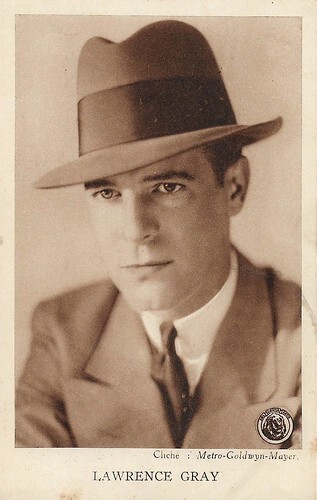
Belgian postcard. Photo Artistes Associés (United Artists). S.A. Cacao et Chocolat Kivou, Vilvoorde / N.V. Cacao en Chocolade Kivou, Vilvoorde.
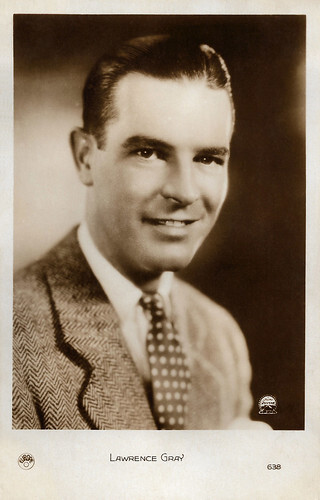
French postcard by Europe, no. 638. Photo: Paramount.
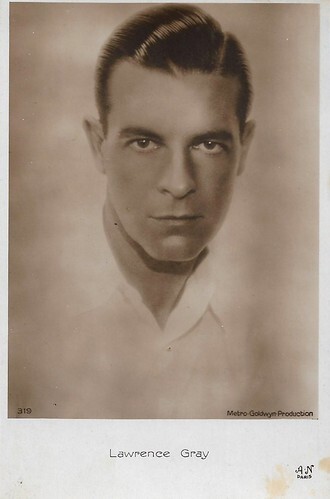
French postcard by A.N., Paris, no. 319. Photo: Metro-Goldwyn-Mayer.
Partner of Hollywood's biggest female stars
Lawrence Gray was born in 1898 in San Francisco, California. His parents were Henry and Mamie Gray. Larry attended schools in San Francisco and worked in Standard Oil Company's export department. He served in the Navy during World War I and became an ensign.
After the war, Gray began to work in the technical field of the film industry at Lasky Studios. He also worked as an extra. He liked the job and decided to become an actor.
Between 1925 and 1936, Lawrence Gray appeared in over forty films although many were B movies.
He was also often partnered with Hollywood's biggest female stars such as Gloria Swanson in Stage Struck (Cecil B. DeMille, 1925) and The Untamed Lady (Frank Tuttle, 1926), Norma Shearer in After Midnight (Monta Bell, 1927) and Colleen Moore in Oh, Kay! (Mervyn LeRoy, 1928).
Memorable is his part as the rich playboy Billy Caldwell in The Patsy (King Vidor 1928), who is overcome with sleep. At the same time, Marion Davies tries to get his attention with impersonations of Lilian Gish , Mae Murray , and Pola Negri . Somehow she manages to convince her family that Billy has assaulted her while rather the opposite has happened.
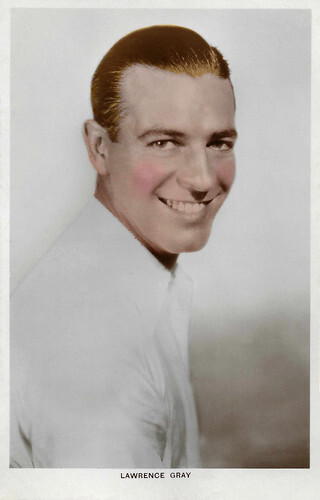
British postcard by Colourgraph, London, no. C53.
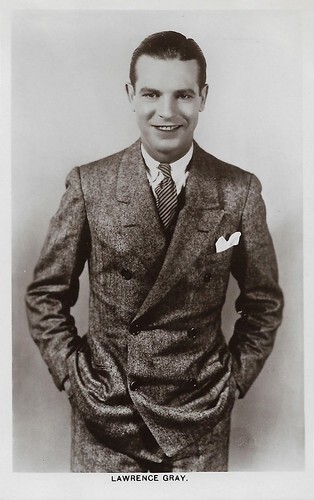
British postcard in the Picturegoer Series, London, no. 277a.
The ideal son or son-in-law
Lawrence Gray had a light and pleasing tenor voice which enabled his easy transition from silent to musical films. He was Marion Davies 's co-singer in Marianne (Robert Z. Leonard, 1929), her talkie-debut.
He contributed to the soundtrack of the Metro-Goldwyn-Mayer musical Children of Pleasure (Harry Beaumont, 1930), in which he starred himself alongside Wynne Gibson, and The Florodora Girl (Harry Beaumont, 1930), with again Marion Davies .
He also starred in the comedy It's a Great Life (Sam Wood, 1929), with the Duncan Sisters - Rosetta and Vivian, and the Vitaphone musicals Sunny (William A. Seiter, 1930), with Marilyn Miller and Spring is Here (John Francis Dillon, 1930), a film version of the 1929 Rodgers & Hart stage musical. Like in his silent films, Gray was either the leading man to the featured female star or a supporting player. His career in musicals ended in 1931 when their over-production caused audiences to lose interest.
Lawrence 'Larry' Gray was often considered the ideal son or son-in-law. He was devoted to his parents, who lived with him. His father Henry died in 1932. Larry continued to share a home with his mother until Dolores Del Rio introduced him to Maria Luisa Figueroa. In 1935 Gray married the Mexican former actress. In 1936 he ended his Hollywood film career and his final film was the comedy In Paris, A.W.O.L. (Roland D. Reed, 1936) also starring Lola Lane and Irene Ware.
Shortly thereafter, the couple relocated permanently to Mexico City. For thirty-three years Gray henceforth worked in Mexico as a coordinator between the Mexican and US film industries. In 1970, Lawrence Gray died at age 71, in Mexico City. His marriage produced no children.
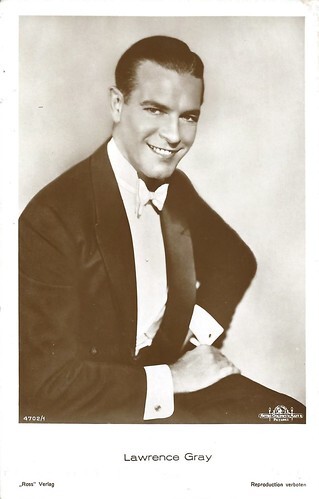
German postcard by Ross Verlag, no. 4702/1, 1929-1930. Photo: Metro-Goldwyn-Mayer.
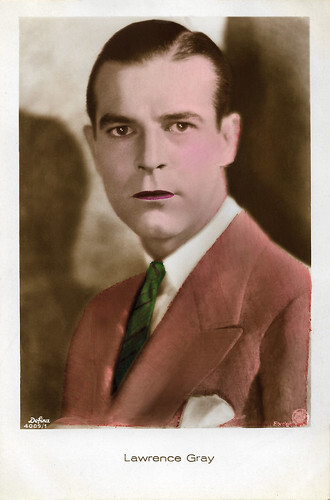
British postcard by Ross Verlag Foreign, no. 4009/1, 1929-1930. Photo: Defina / First National.
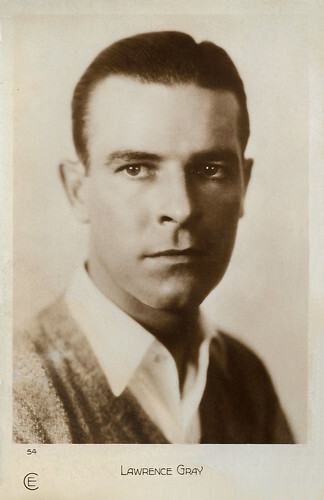
French postcard by Cinémagazine-Édition, Paris, no. 54.
Sources: Netherlands Silent Film Festival, Wikipedia (English and Italian) and .
EFSP salutes this young festival with four posts connecting to the programme. The Netherlands Silent Film Festival begins on Thursday evening 16 January with the romantic comedy Kids Boots (Frank Tuttle, 1926), starring the comedian Eddie Cantor, the irresistible Clara Bow and a forgotten American film actor of the silent screen, Lawrence Gray. Who was this 'ideal son-in-law'?

Belgian postcard. Photo Artistes Associés (United Artists). S.A. Cacao et Chocolat Kivou, Vilvoorde / N.V. Cacao en Chocolade Kivou, Vilvoorde.

French postcard by Europe, no. 638. Photo: Paramount.

French postcard by A.N., Paris, no. 319. Photo: Metro-Goldwyn-Mayer.
Partner of Hollywood's biggest female stars
Lawrence Gray was born in 1898 in San Francisco, California. His parents were Henry and Mamie Gray. Larry attended schools in San Francisco and worked in Standard Oil Company's export department. He served in the Navy during World War I and became an ensign.
After the war, Gray began to work in the technical field of the film industry at Lasky Studios. He also worked as an extra. He liked the job and decided to become an actor.
Between 1925 and 1936, Lawrence Gray appeared in over forty films although many were B movies.
He was also often partnered with Hollywood's biggest female stars such as Gloria Swanson in Stage Struck (Cecil B. DeMille, 1925) and The Untamed Lady (Frank Tuttle, 1926), Norma Shearer in After Midnight (Monta Bell, 1927) and Colleen Moore in Oh, Kay! (Mervyn LeRoy, 1928).
Memorable is his part as the rich playboy Billy Caldwell in The Patsy (King Vidor 1928), who is overcome with sleep. At the same time, Marion Davies tries to get his attention with impersonations of Lilian Gish , Mae Murray , and Pola Negri . Somehow she manages to convince her family that Billy has assaulted her while rather the opposite has happened.

British postcard by Colourgraph, London, no. C53.

British postcard in the Picturegoer Series, London, no. 277a.
The ideal son or son-in-law
Lawrence Gray had a light and pleasing tenor voice which enabled his easy transition from silent to musical films. He was Marion Davies 's co-singer in Marianne (Robert Z. Leonard, 1929), her talkie-debut.
He contributed to the soundtrack of the Metro-Goldwyn-Mayer musical Children of Pleasure (Harry Beaumont, 1930), in which he starred himself alongside Wynne Gibson, and The Florodora Girl (Harry Beaumont, 1930), with again Marion Davies .
He also starred in the comedy It's a Great Life (Sam Wood, 1929), with the Duncan Sisters - Rosetta and Vivian, and the Vitaphone musicals Sunny (William A. Seiter, 1930), with Marilyn Miller and Spring is Here (John Francis Dillon, 1930), a film version of the 1929 Rodgers & Hart stage musical. Like in his silent films, Gray was either the leading man to the featured female star or a supporting player. His career in musicals ended in 1931 when their over-production caused audiences to lose interest.
Lawrence 'Larry' Gray was often considered the ideal son or son-in-law. He was devoted to his parents, who lived with him. His father Henry died in 1932. Larry continued to share a home with his mother until Dolores Del Rio introduced him to Maria Luisa Figueroa. In 1935 Gray married the Mexican former actress. In 1936 he ended his Hollywood film career and his final film was the comedy In Paris, A.W.O.L. (Roland D. Reed, 1936) also starring Lola Lane and Irene Ware.
Shortly thereafter, the couple relocated permanently to Mexico City. For thirty-three years Gray henceforth worked in Mexico as a coordinator between the Mexican and US film industries. In 1970, Lawrence Gray died at age 71, in Mexico City. His marriage produced no children.

German postcard by Ross Verlag, no. 4702/1, 1929-1930. Photo: Metro-Goldwyn-Mayer.

British postcard by Ross Verlag Foreign, no. 4009/1, 1929-1930. Photo: Defina / First National.

French postcard by Cinémagazine-Édition, Paris, no. 54.
Sources: Netherlands Silent Film Festival, Wikipedia (English and Italian) and .
Published on January 15, 2025 22:00
January 14, 2025
Ross Verlag, Part 18: Vom Werden deutscher Filmkunst - Der Stumme Film (2)
We continue our Ross Verlag Tribute with a second post on the collector card series Vom Werden deutscher Filmkunst which Ross Verlag produced for the 'Cigaretten-Bilderdienst', Altona-Bahrenfeld in 1935. The cards were included with cigarette packs. Last week the pictures showed the first stars of the early German silent cinema, like Asta Nielsen, Wanda Treumann and Viggo Larsen. After the First World War new faces joined them and also such directors as Ernst Lubitsch and Fritz Lang started their careers. So, meet today Mia May as the Mistress of the World, meet Lil Dagover, Werner Krauss, Harry Liedtke and the very young Hans Albers.
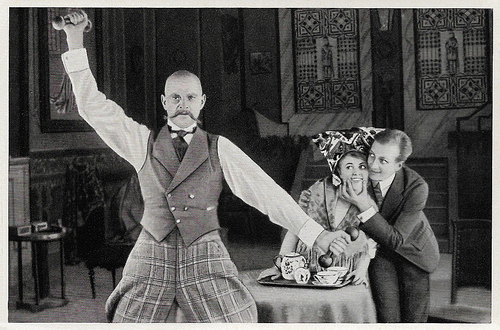
German collector card by Ross Verlag in the series 'Vom Werden deutscher Filmkunst - Der Stumme Film', picture no. 38, group 43. Photo: Paul Westermeier , Hanne Brinkmann and Hans Albers in Baroneßchen auf Strafurlaub/Little Baroness on Punishment Holiday (Otto Rippert, 1917). Caption: Paul Westermeier 'works out', Hans Albers - in a small secondary role - is allowed to pinch Hanne Brinkmann in the cheek.
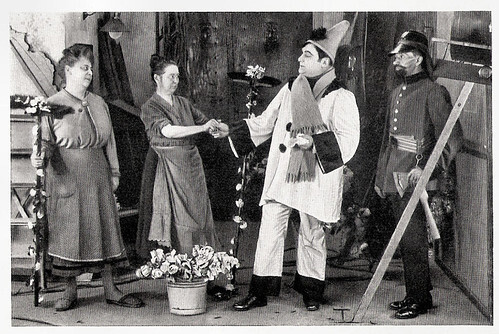
German collector card by Ross Verlag in the series 'Vom Werden Deutscher Filmkunst - Der Stumme Film', no. 39, group 41. Photo: Ufa. Leo Peukert in Lohengrin's Heirat/Lohengrin's marriage (Leo Peukert, 1922).
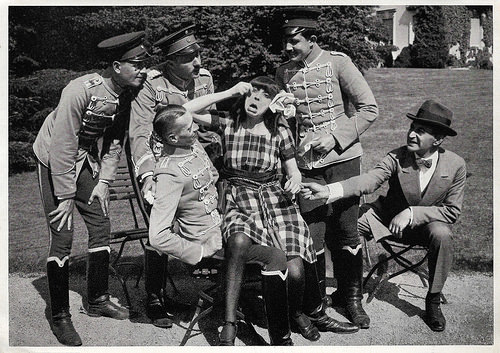
German collector card by Ross Verlag in the series 'Vom Werden deutscher Filmkunst - Der Stumme Film', no. 42, group 40. Photo: Ufa. Asta Nielsen , Bruno Kastner and Max Landa in Engelein/Little Angel (Urban Gad, 1914).
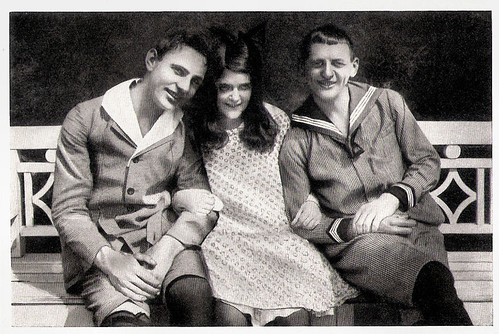
German collector card by Ross Verlag in the series 'Vom Werden deutscher Filmkunst - Der Stumme Film', no. 43, group 41. Photo: Treumann-Larsen-Film. Eduard von Winterstein , Rosa Porten and Reinhold Schünzel in Die Erzkokette/The Superflirt (Franz Eckstein, Rosa Porten, 1917).
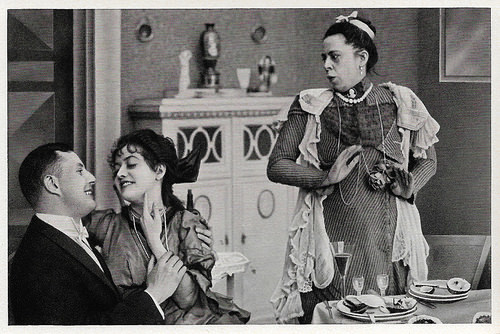
German collector card by Ross Verlag in the series 'Vom Werden deutscher Filmkunst - Der Stumme Film', no. 45, group 43. Photo: Tobias-Film. Bruno Kastner , Dorrit Weixler and Frida Richard in Dorittchens Vergnügungsreise/Little Dorrit's Pleasure Trip (Paul Heidemann, 1916).
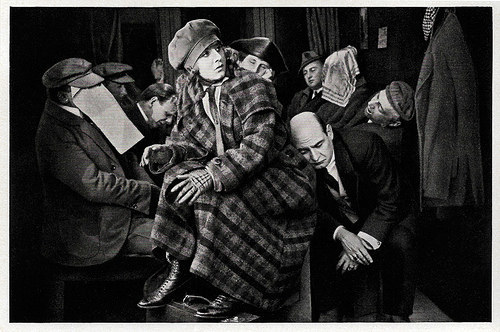
German collector card by Ross Verlag in the series 'Vom Werden deutscher Filmkunst - Der Stumme Film', no. 46, group 43. Photo: Ufa. Ossi Oswalda in Kakadu und Kiebitz/Kakadu and Kiebitz (Erich Schönfelder, 1920).
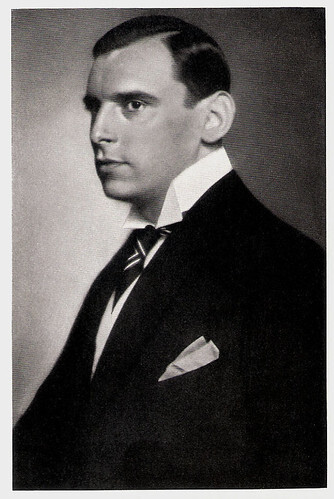
German collector card by Ross Verlag in the series 'Vom Werden Deutscher Filmkunst - Der Stumme Film', no. 47, group 41. Photo: Schenker. Caption: Ernst Reicher , der Detektiv Stuart Webbs.
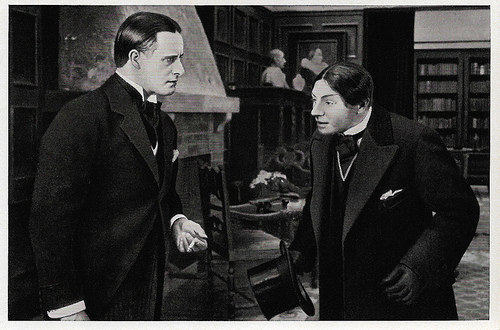
German collector card by Ross Verlag in the series 'Vom Werden deutscher Filmkunst - Der Stumme Film', no. 50, group 43. Photo: Ufa. Carl Auen in Der heulende Wolf/The Crying Wolf (Leo Lasko, 1919). Caption: " Carl Auen as detective in Der heulende Wolf".
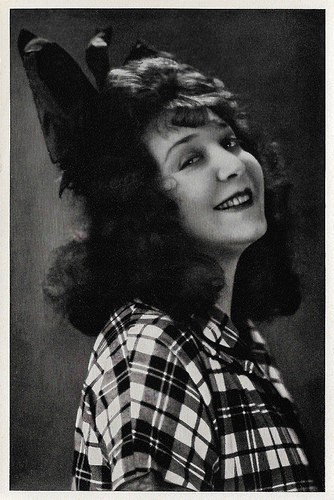
German collector card by Ross Verlag in the series 'Vom Werden deutscher Filmkunst - Der Stumme Film', no. 52, group 43. Photo: Alex Binder. Caption: " Erika Glässner , the Backfisch (young flapper) from West Berlin in many Aufklärungsfilmen (educational films on social issues)."
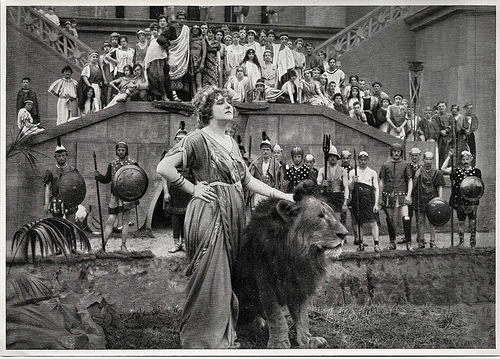
German collector card by Ross Verlag in the series 'Vom Werden deutscher Filmkunst - Der Stumme Film', no. 55, group 40. Photo: Ufa. Mia May in Veritas Vincit (Joe May, 1919).
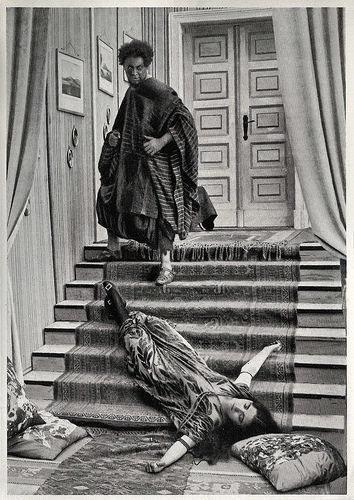
German collector card by Ross Verlag in the series 'Vom Werden deutscher Filmkunst - Der Stumme Film', no. 58, group 40. Photo: Ufa. Emil Jannings and Pola Negri in Die Augen der Mumie Ma/The Eyes of the Mummy (Ernst Lubitsch, 1918).
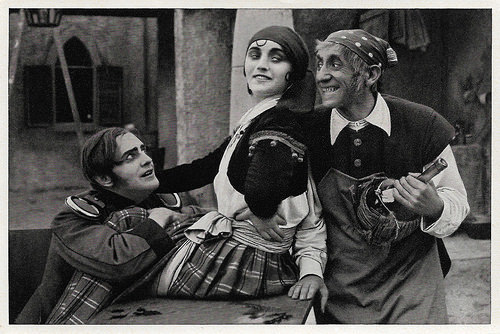
German collector card by Ross Verlag in the series 'Vom Werden deutscher Filmkunst - Der Stumme Film', no, 59, group 43. Photo: Ufa. Harry Liedtke and Pola Negri in Carmen (Ernst Lubitsch, 1918).
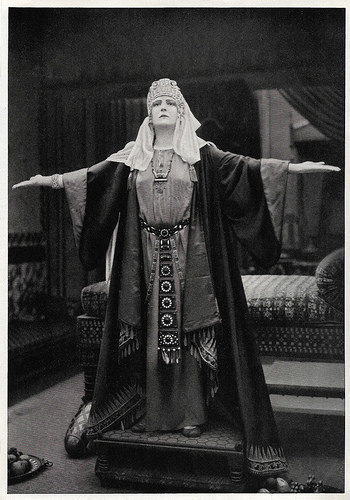
German collector card by Ross Verlag in the series 'Vom Werden deutscher Filmkunst - Der Stumme Film', no. 62, group 40. Photo: Ufa. Mia May in Die Herrin der Welt/Mistress of the World (Joe May and others, 1919).
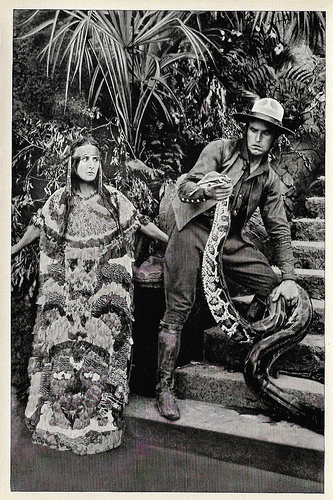
German collector card by Ross Verlag in the series 'Vom Werden deutscher Filmkunst - Der stumme Film' by Ross Verlag, no. 63. Photo: Decla-Film. Lil Dagover and Carl de Vogt in Die Spinnen/The Spiders (Fritz Lang, 1919-1920).
German collector card by Ross Verlag in the series 'Vom Werden deutscher Filmkunst - Der Stumme Film', no. 64, group 43. Photo: Ufa. Georg Alexander , Harry Liedtke and Hubert von Meyerinck in Der Mann ohne Nahmen/The Man Without a Name (Georg Jacoby, 1921).
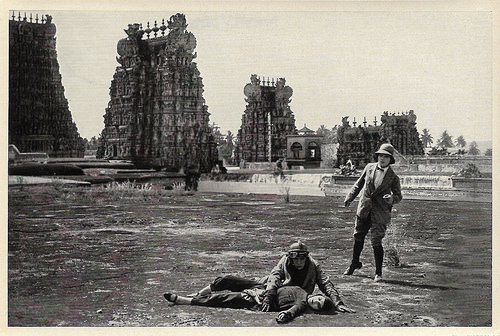
German collector card by Ross Verlag in the series 'Vom Werden deutscher Filmkunst - Der Stumme Film', no. 66. Photo: Ellen-Richter-Film. Ellen Richter , Anton Pointner and Hans Brausewetter in Der flug um den Erdball/The Flight Around the Globe (Willi Wolff, 1925).
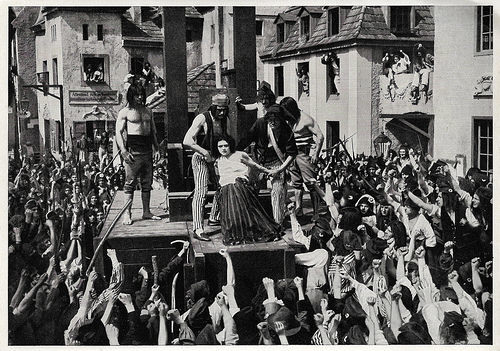
German collector card by Ross Verlag in the series 'Vom Werden deutscher Filmkunst - Der Stumme Film', no. 67, group 40. Photo: Ufa. Pola Negri in Madame Dubarry (Ernst Lubitsch, 1919). Caption: Pola Negri as Madame Dubarry, execution on the market square in Paris.
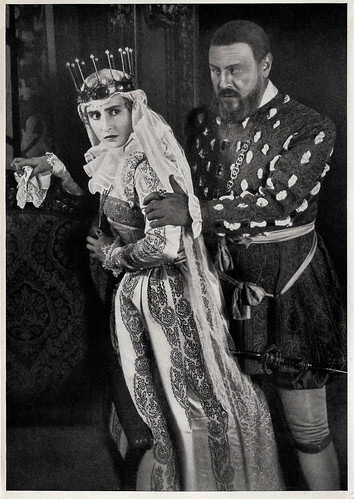
German collector card by Ross Verlag in the series 'Vom Werden deutscher Filmkunst - Der Stumme Film', no. 68, group 42. Photo: Ufa. Emil Jannings as the British king Henry VIII and Henny Porten as Anna Boleyn in Anna Boleyn/Anne Boleyn (Ernst Lubitsch, 1920).
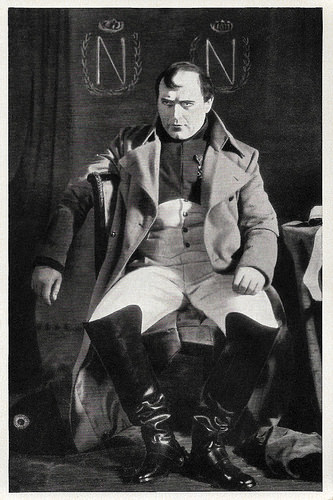
German collector card by Ross Verlag in the series Vom Werden Deutscher Filmkunst - Der Stumme Film, no. 69, group 39. Photo: D.L.S. Werner Krauss in Napoleon auf St. Helena/Napoleon at St. Helena (Lupu Pick, 1929).
The Ross Verlag Tribute will be continued next week!

German collector card by Ross Verlag in the series 'Vom Werden deutscher Filmkunst - Der Stumme Film', picture no. 38, group 43. Photo: Paul Westermeier , Hanne Brinkmann and Hans Albers in Baroneßchen auf Strafurlaub/Little Baroness on Punishment Holiday (Otto Rippert, 1917). Caption: Paul Westermeier 'works out', Hans Albers - in a small secondary role - is allowed to pinch Hanne Brinkmann in the cheek.

German collector card by Ross Verlag in the series 'Vom Werden Deutscher Filmkunst - Der Stumme Film', no. 39, group 41. Photo: Ufa. Leo Peukert in Lohengrin's Heirat/Lohengrin's marriage (Leo Peukert, 1922).

German collector card by Ross Verlag in the series 'Vom Werden deutscher Filmkunst - Der Stumme Film', no. 42, group 40. Photo: Ufa. Asta Nielsen , Bruno Kastner and Max Landa in Engelein/Little Angel (Urban Gad, 1914).

German collector card by Ross Verlag in the series 'Vom Werden deutscher Filmkunst - Der Stumme Film', no. 43, group 41. Photo: Treumann-Larsen-Film. Eduard von Winterstein , Rosa Porten and Reinhold Schünzel in Die Erzkokette/The Superflirt (Franz Eckstein, Rosa Porten, 1917).

German collector card by Ross Verlag in the series 'Vom Werden deutscher Filmkunst - Der Stumme Film', no. 45, group 43. Photo: Tobias-Film. Bruno Kastner , Dorrit Weixler and Frida Richard in Dorittchens Vergnügungsreise/Little Dorrit's Pleasure Trip (Paul Heidemann, 1916).

German collector card by Ross Verlag in the series 'Vom Werden deutscher Filmkunst - Der Stumme Film', no. 46, group 43. Photo: Ufa. Ossi Oswalda in Kakadu und Kiebitz/Kakadu and Kiebitz (Erich Schönfelder, 1920).

German collector card by Ross Verlag in the series 'Vom Werden Deutscher Filmkunst - Der Stumme Film', no. 47, group 41. Photo: Schenker. Caption: Ernst Reicher , der Detektiv Stuart Webbs.

German collector card by Ross Verlag in the series 'Vom Werden deutscher Filmkunst - Der Stumme Film', no. 50, group 43. Photo: Ufa. Carl Auen in Der heulende Wolf/The Crying Wolf (Leo Lasko, 1919). Caption: " Carl Auen as detective in Der heulende Wolf".

German collector card by Ross Verlag in the series 'Vom Werden deutscher Filmkunst - Der Stumme Film', no. 52, group 43. Photo: Alex Binder. Caption: " Erika Glässner , the Backfisch (young flapper) from West Berlin in many Aufklärungsfilmen (educational films on social issues)."

German collector card by Ross Verlag in the series 'Vom Werden deutscher Filmkunst - Der Stumme Film', no. 55, group 40. Photo: Ufa. Mia May in Veritas Vincit (Joe May, 1919).

German collector card by Ross Verlag in the series 'Vom Werden deutscher Filmkunst - Der Stumme Film', no. 58, group 40. Photo: Ufa. Emil Jannings and Pola Negri in Die Augen der Mumie Ma/The Eyes of the Mummy (Ernst Lubitsch, 1918).

German collector card by Ross Verlag in the series 'Vom Werden deutscher Filmkunst - Der Stumme Film', no, 59, group 43. Photo: Ufa. Harry Liedtke and Pola Negri in Carmen (Ernst Lubitsch, 1918).

German collector card by Ross Verlag in the series 'Vom Werden deutscher Filmkunst - Der Stumme Film', no. 62, group 40. Photo: Ufa. Mia May in Die Herrin der Welt/Mistress of the World (Joe May and others, 1919).

German collector card by Ross Verlag in the series 'Vom Werden deutscher Filmkunst - Der stumme Film' by Ross Verlag, no. 63. Photo: Decla-Film. Lil Dagover and Carl de Vogt in Die Spinnen/The Spiders (Fritz Lang, 1919-1920).
German collector card by Ross Verlag in the series 'Vom Werden deutscher Filmkunst - Der Stumme Film', no. 64, group 43. Photo: Ufa. Georg Alexander , Harry Liedtke and Hubert von Meyerinck in Der Mann ohne Nahmen/The Man Without a Name (Georg Jacoby, 1921).

German collector card by Ross Verlag in the series 'Vom Werden deutscher Filmkunst - Der Stumme Film', no. 66. Photo: Ellen-Richter-Film. Ellen Richter , Anton Pointner and Hans Brausewetter in Der flug um den Erdball/The Flight Around the Globe (Willi Wolff, 1925).

German collector card by Ross Verlag in the series 'Vom Werden deutscher Filmkunst - Der Stumme Film', no. 67, group 40. Photo: Ufa. Pola Negri in Madame Dubarry (Ernst Lubitsch, 1919). Caption: Pola Negri as Madame Dubarry, execution on the market square in Paris.

German collector card by Ross Verlag in the series 'Vom Werden deutscher Filmkunst - Der Stumme Film', no. 68, group 42. Photo: Ufa. Emil Jannings as the British king Henry VIII and Henny Porten as Anna Boleyn in Anna Boleyn/Anne Boleyn (Ernst Lubitsch, 1920).

German collector card by Ross Verlag in the series Vom Werden Deutscher Filmkunst - Der Stumme Film, no. 69, group 39. Photo: D.L.S. Werner Krauss in Napoleon auf St. Helena/Napoleon at St. Helena (Lupu Pick, 1929).
The Ross Verlag Tribute will be continued next week!
Published on January 14, 2025 22:00
January 13, 2025
Elke Arendt
German actress and author Elke Arendt (1939) became known for her impersonation of the fairy tale character Snow White in Schneewittchen und die sieben Zwerge/Snowwhite and the Seven Dwarfs (1955). Her later films included Hula-Hopp Conny (1959), Jazz und Jux in Heidelberg (1964) and Nebelmörder (1964).
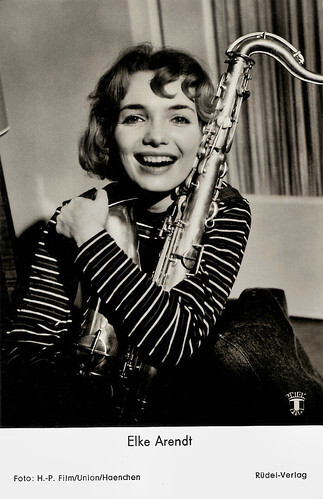
German postcard by Hans Josef Rüdel, Filmpostkartenverlag, Hamburg-Bergedorf, no. 2627. Photo: H-P Film / Union / Haenchen. Elke Arendt in Hula-Hopp Conny (Heinz Paul, 1959).
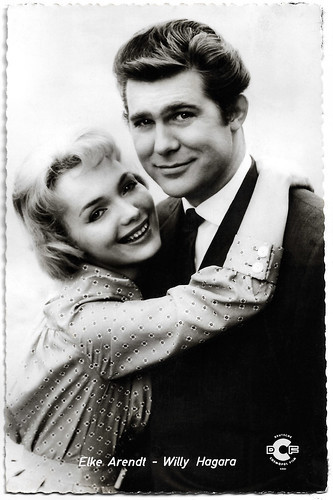
German postcard by Kolibri-Verlag G.m.b.H., Minden/Westf. Photo: Deutsche Cosmopol Film (DCF). Elke Arendt and Willy Hagara in Paprika (Kurt Wilhelm, 1959).
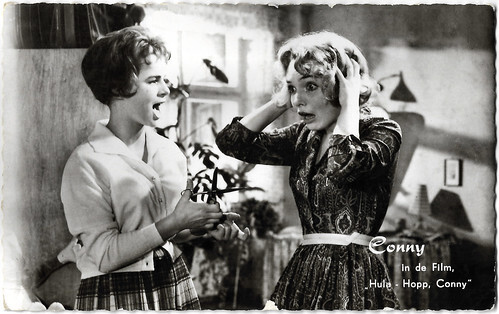
Dutch postcard. Conny Froboess and Elke Arendt in Hula-Hopp, Conny (Heinz Paul, 1959).
Snowwhite
Elke Arendt was born in Munich in 1939 and trained at the Children's Ballet of the Bavarian State Opera in 1946. She also played children's roles in theatre and film.
After engagements as a stage actress, she appeared in over 20 different productions in the 1950s and 1960s. She made her film debut in 1955 at the age of 16 under the direction of Erich Kobler in the fairy tale film Schneewittchen und die sieben Zwerge/Snowwhite and the Seven Dwarfs (1955), filmed at Neuschwanstein Castle.
After training as an actress in Munich, she appeared in several films from 1956, such as the fairy-tale Die Heinzelmännchen/The Shoemaker and the Elves (Erich Kobler, 1956), Einmal eine große Dame sein/Be a great lady for once (Erik Ode, 1957), the Children's film Rübezahl - Herr der Berge/Rübezahl - Lord of the mountains (Erich Kobler, 1957), the Conny Froboess vehicle Hula-Hopp, Conny (Heinz Paul, 1959) and Paprika (Kurt Wilhelm, 1959).
In the 1960s she appeared in Ein Student ging vorbei/A Student Walked Past (Werner Klingler, 1960), Hauptmann - Deine Sterne/Captain - Your Stars (Géza von Cziffra, 1960), Davon träumen alle Mädchen/All girls dream of this (Thomas Engel, 1961), Zwei Bayern in Bonn/Two Bavarians in Bonn (Rudolf Lubowski, 1962) with Beppo Brem, Nebelmörder/Fog killer (Eugen York, 1964) with Hansjörg Felmy and the TV film Liebe auf den zweiten Blick/Love at Second Sight (Wolfgang Spier, Hans-Georg Thiemt, 1964).
Theatre engagements took her to the Volksbühne Berlin, the Staatstheater Kassel, the Schauspielhaus Bochum, the Staatstheater Darmstadt and the Bayerisches Staatsschauspiel, and she also appeared in guest performances and tours.
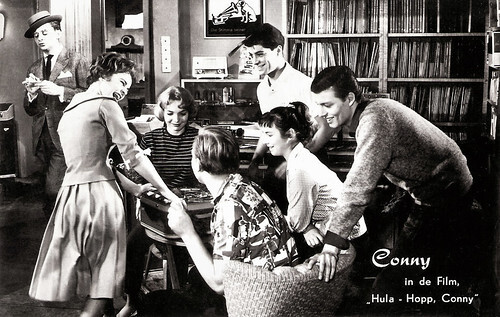
Dutch postcard. Conny Froboess , Richard Hellmann , Elke Arendt, Monika Leonhardt, Sergio Casmai and Hans Zander in Hula-Hopp, Conny (Heinz Paul, 1959).
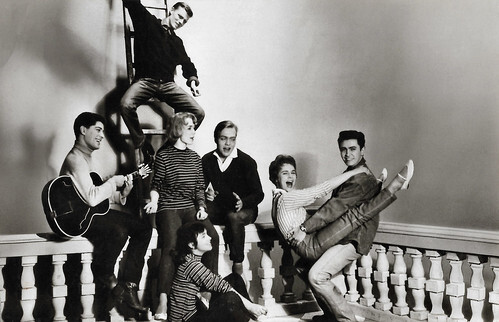
German postcard by Hans Josef Rüdel, Filmpostkartenverlag, Hamburg-Bergedorf, no. 2647. Photo: H.P. / Union / Haenchen. Conny Froboess , Rex Gildo , Richard Hellmann , Elke Arendt, Monika Leonhardt, Sergio Casmai and Hans Zander in Hula-Hopp, Conny (Heinz Paul, 1959).
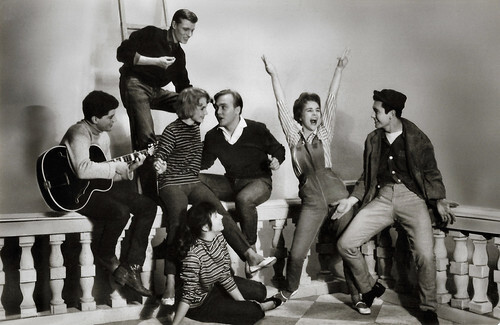
German postcard by Hans Josef Rüdel, Filmpostkartenverlag, Hamburg-Bergedorf, no. 2649. Photo: H.P. / Union / Haenchen. Conny Froboess , Rex Gildo , Richard Hellmann , Elke Arendt, Monika Leonhardt, Sergio Casmai and Hans Zander in Hula-Hopp, Conny (Heinz Paul, 1959).
Self-employed as a life coach
After a family break and professional reorientation, Elke Arendt became active in radio plays and theatre with her own productions, such as 'Undine geht' by Ingeborg Bachmann and 'Die gelbe Tapete' by Charlotte Perkins Gilman.
In the 1990s she appeared as an actress in several television roles and later became self-employed as a life coach in Munich with her publications. In 2000, she sketched the life of the actress and poet Emmy Hennings in the biography 'Der blonde Fetzen. She directed the accompanying stage production at the Stadttheater Ingolstadt.
In November 2019, she published her novel 'Louise, Hofnärrin zu Weimar', about Luise von Göchhausen, First Lady-in-Waiting to Duchess Anna Amalia of Saxe-Weimar-Eisenach, under the name Elke Orlac.
In the 1960s, Elke Arendt was married to the American singer, actor and presenter Charlie Hickman. Their daughter Lauretta Hickman (1964) was born in this marriage.
In her second marriage, she was married to the actor Stephan Orlac until he died in 2020. Two more children were born of this marriage, including the director, screenwriter and author Sebastian Orlac (1970).
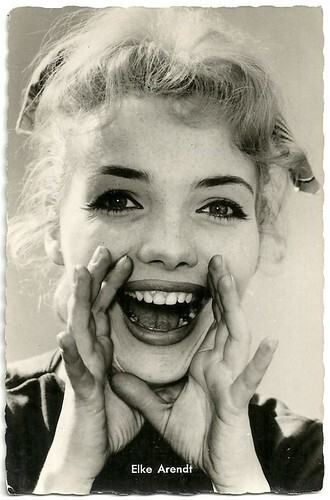
German postcard by Kolibri-Verlag G.m.b.H., Minden/Westf. Photo: Deutsche Cosmopol Film (DCF). Elke Arendt in Paprika (Kurt Wilhelm, 1959).
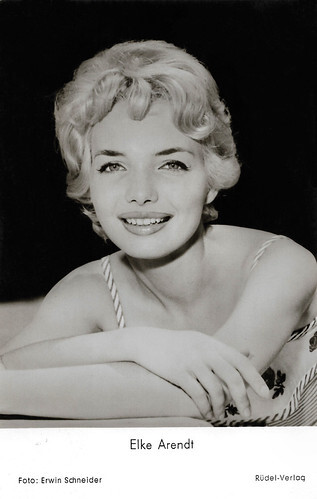
German postcard by Rüdel-Verlag, Hamburg-Bergedorf, no. 2873. Photo: Erwin Schneider.
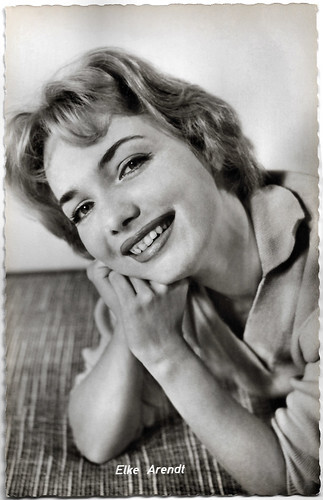
German postcard by Kolibri-Verlag G.m.b.H., Minden/Westf., no. 745. Photo: Kolibri / Sander.
Sources: Filmportal, Wikipedia (German) and .

German postcard by Hans Josef Rüdel, Filmpostkartenverlag, Hamburg-Bergedorf, no. 2627. Photo: H-P Film / Union / Haenchen. Elke Arendt in Hula-Hopp Conny (Heinz Paul, 1959).

German postcard by Kolibri-Verlag G.m.b.H., Minden/Westf. Photo: Deutsche Cosmopol Film (DCF). Elke Arendt and Willy Hagara in Paprika (Kurt Wilhelm, 1959).

Dutch postcard. Conny Froboess and Elke Arendt in Hula-Hopp, Conny (Heinz Paul, 1959).
Snowwhite
Elke Arendt was born in Munich in 1939 and trained at the Children's Ballet of the Bavarian State Opera in 1946. She also played children's roles in theatre and film.
After engagements as a stage actress, she appeared in over 20 different productions in the 1950s and 1960s. She made her film debut in 1955 at the age of 16 under the direction of Erich Kobler in the fairy tale film Schneewittchen und die sieben Zwerge/Snowwhite and the Seven Dwarfs (1955), filmed at Neuschwanstein Castle.
After training as an actress in Munich, she appeared in several films from 1956, such as the fairy-tale Die Heinzelmännchen/The Shoemaker and the Elves (Erich Kobler, 1956), Einmal eine große Dame sein/Be a great lady for once (Erik Ode, 1957), the Children's film Rübezahl - Herr der Berge/Rübezahl - Lord of the mountains (Erich Kobler, 1957), the Conny Froboess vehicle Hula-Hopp, Conny (Heinz Paul, 1959) and Paprika (Kurt Wilhelm, 1959).
In the 1960s she appeared in Ein Student ging vorbei/A Student Walked Past (Werner Klingler, 1960), Hauptmann - Deine Sterne/Captain - Your Stars (Géza von Cziffra, 1960), Davon träumen alle Mädchen/All girls dream of this (Thomas Engel, 1961), Zwei Bayern in Bonn/Two Bavarians in Bonn (Rudolf Lubowski, 1962) with Beppo Brem, Nebelmörder/Fog killer (Eugen York, 1964) with Hansjörg Felmy and the TV film Liebe auf den zweiten Blick/Love at Second Sight (Wolfgang Spier, Hans-Georg Thiemt, 1964).
Theatre engagements took her to the Volksbühne Berlin, the Staatstheater Kassel, the Schauspielhaus Bochum, the Staatstheater Darmstadt and the Bayerisches Staatsschauspiel, and she also appeared in guest performances and tours.

Dutch postcard. Conny Froboess , Richard Hellmann , Elke Arendt, Monika Leonhardt, Sergio Casmai and Hans Zander in Hula-Hopp, Conny (Heinz Paul, 1959).

German postcard by Hans Josef Rüdel, Filmpostkartenverlag, Hamburg-Bergedorf, no. 2647. Photo: H.P. / Union / Haenchen. Conny Froboess , Rex Gildo , Richard Hellmann , Elke Arendt, Monika Leonhardt, Sergio Casmai and Hans Zander in Hula-Hopp, Conny (Heinz Paul, 1959).

German postcard by Hans Josef Rüdel, Filmpostkartenverlag, Hamburg-Bergedorf, no. 2649. Photo: H.P. / Union / Haenchen. Conny Froboess , Rex Gildo , Richard Hellmann , Elke Arendt, Monika Leonhardt, Sergio Casmai and Hans Zander in Hula-Hopp, Conny (Heinz Paul, 1959).
Self-employed as a life coach
After a family break and professional reorientation, Elke Arendt became active in radio plays and theatre with her own productions, such as 'Undine geht' by Ingeborg Bachmann and 'Die gelbe Tapete' by Charlotte Perkins Gilman.
In the 1990s she appeared as an actress in several television roles and later became self-employed as a life coach in Munich with her publications. In 2000, she sketched the life of the actress and poet Emmy Hennings in the biography 'Der blonde Fetzen. She directed the accompanying stage production at the Stadttheater Ingolstadt.
In November 2019, she published her novel 'Louise, Hofnärrin zu Weimar', about Luise von Göchhausen, First Lady-in-Waiting to Duchess Anna Amalia of Saxe-Weimar-Eisenach, under the name Elke Orlac.
In the 1960s, Elke Arendt was married to the American singer, actor and presenter Charlie Hickman. Their daughter Lauretta Hickman (1964) was born in this marriage.
In her second marriage, she was married to the actor Stephan Orlac until he died in 2020. Two more children were born of this marriage, including the director, screenwriter and author Sebastian Orlac (1970).

German postcard by Kolibri-Verlag G.m.b.H., Minden/Westf. Photo: Deutsche Cosmopol Film (DCF). Elke Arendt in Paprika (Kurt Wilhelm, 1959).

German postcard by Rüdel-Verlag, Hamburg-Bergedorf, no. 2873. Photo: Erwin Schneider.

German postcard by Kolibri-Verlag G.m.b.H., Minden/Westf., no. 745. Photo: Kolibri / Sander.
Sources: Filmportal, Wikipedia (German) and .
Published on January 13, 2025 22:00
January 12, 2025
Chester Morris
American actor Chester Morris (1901-1970) was a Broadway star who billed himself as 'the youngest leading man in the country'. With his dark, good looks and chiselled jaw, he became a film star in the sound era. Morris was Oscar-nominated for Alibi (1929), but his greatest success was The Big House (1930). However, his star dimmed and by the end of the decade, he was appearing in B-pictures, From 1941, the Boston Blackie series at Columbia Pictures revived his career. In all, he appeared in 14 films as a detective.
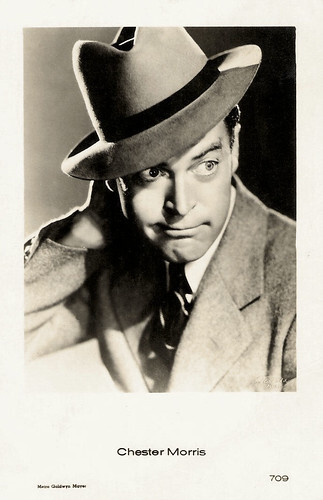
Dutch postcard by JosPe, no. 709. Photo: Metro-Goldwyn-Mayer.
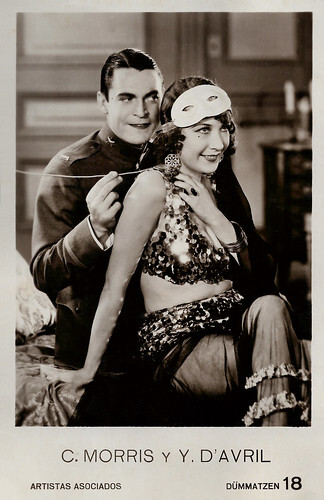
Spanish postcard by Dümmatzen, no. 18. Photo: United Artists. Chester Morris and Yola d'Avril in Cock of the Air (Tom Buckingham, 1932).
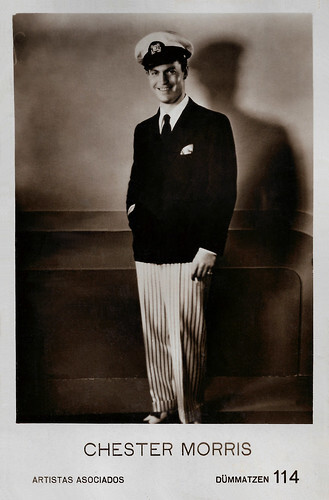
Spanish postcard by Dümmatzen, no. 114. Photo: United Artists. Chester Morris in Corsair (Roland West, 1931).
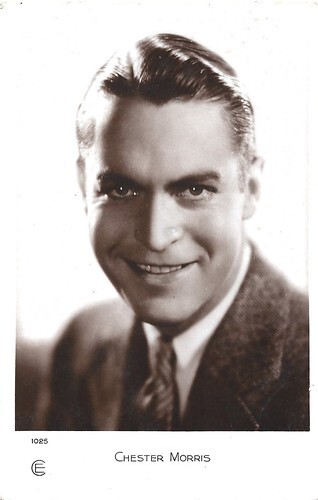
French postcard by Cinémagazine-Edition, no. 1025.
The youngest leading man in the country
Chester Morris was born John Chester Brooks Morris in New York City, in 1901. He was the son of Broadway stage actor William Morris and comedienne Etta Hawkins. His siblings were screenwriter-actor Gordon Morris, actor Adrian Morris, and actress Wilhelmina Morris. Another brother, Lloyd Morris, had died young.
Morris dropped out of school and began his Broadway career at 15 years old in the play 'The Copperhead' (1918), in support of the great Lionel Barrymore .
A year earlier, Chet Morris had made his film debut in the silent comedy-drama An Amateur Orphan (Van Dyke Brooke, 1917), but he didn't become a real film actor until the sound era. Instead, Morris appeared on Broadway in the plays 'Thunder' and 'The Mountain Man' in 1919.
He returned to the Great White Way in 1922 in the comedy 'The Exciters'. He followed it up with the comedy-drama 'Extra' in 1923. Now established, Chester Morris began billing himself as 'The youngest leading man in the country'.
In 1923, Morris joined his parents, sister, and two brothers, Gordon and Adrian, on the vaudeville circuit. They performed William Morris' original sketch called 'All the Horrors of Home', which premiered at the Palace Theatre, New York, then on the Keith-Orpheum circuit for two years, including Proctor's Theatre, Mount Vernon, New York, and culminating in Los Angeles in 1925. Morris returned to Broadway with roles in 'The Home Towners' (1926) and 'Yellow' (1927). While appearing in the 1927 play 'Crime', he was spotted by a talent agent and was signed to a film contract.
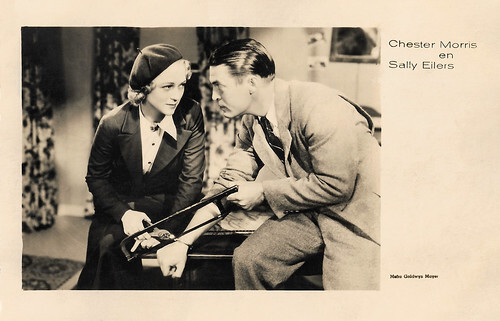
Dutch postcard. Chester Morris and Sally Eilers in She Couldn't Say No (Lloyd Bacon, 1930).
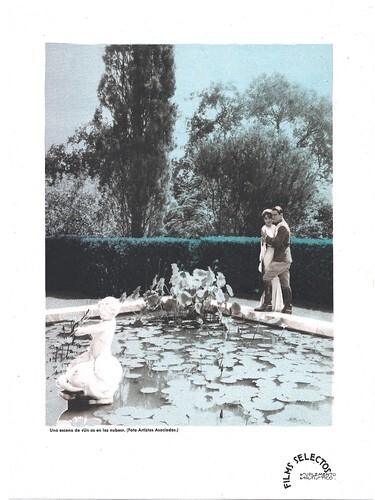
Spanish leaflet by Films Selectos, Suplemento Artistico, no. 134, 6.5.1933. Photo: United Artists. Billie Dove and Chester Morris in Cock of the Air (Tom Buckingham, 1932).
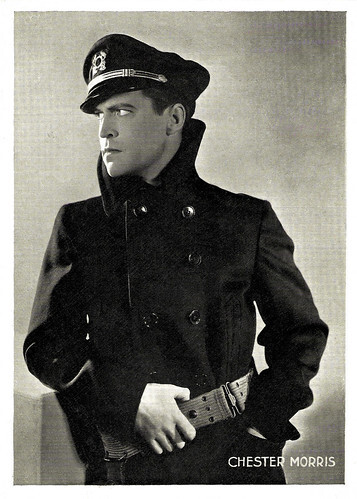
Vintage postcard. Photo: Metro Goldwyn Mayer. Chester Morris in Thunder Afloat (George B. Seitz, 1939).
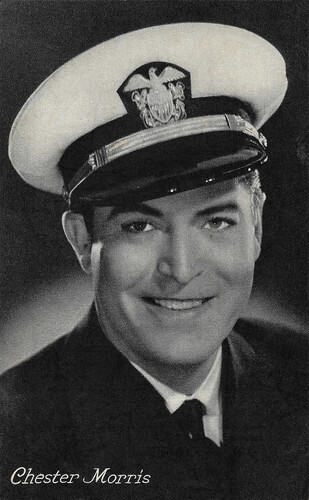
American collector card. Photo: Metro Goldwyn Mayer. Chester Morris in Thunder Afloat (George B. Seitz, 1939).
A natural for movie stardom
Chester Morris' dark, good looks and chiselled jaw made him a natural for movie stardom. He appeared without credit in Cecil B. DeMille 's The Road to Yesterday (1925), but it wasn't until the transition from silent pictures to talkies that he became a real film actor.
He was one of the first actors to be nominated for an Academy Award when in 1930 (the second year of the as-yet non-nicknamed Oscars) he was recognised with a nod as Best Actor for Alibi (Roland West, 1929) with Harry Stubbs and Mae Busch. It was his first talking picture. He followed with roles in Woman Trap (William A. Wellman, 1929) with Evelyn Brent , The Case of Sergeant Grischa (Herbert Brenon, 1930) and The Divorcee (Robert Z. Leonard, 1930), starring Norma Shearer .
The film for which he is best known is the archetype prison break picture The Big House (George W. Hill, Ward Wing, 1930), with Wallace Beery and Robert Montgomery . With his role as a convict in love, he broke through to stardom. From 1930 through the middle of the decade, he was a star with good roles in first-rate pictures, such as the comedy-drama Red-Headed Woman (Jack Conway, 1932) opposite Jean Harlow . He usually played tough guys.
However, his star dimmed and by the end of the decade, he was appearing in B-pictures. In 1941, the success of the crime comedy Meet Boston Blackie (Robert Florey, 1941) and the following 'Boston Blackie'film series at Columbia Pictures revived his career. In all, he appeared in 14 pictures as the criminal-turned-detective. He reprised the role of Boston Blackie for the radio series in 1944. He later segued to TV work in the 1950s and 1960s, appearing in the occasional film such as his last one, The Great White Hope (Martin Ritt, 1970), starring James Earl Jones.
The film was released after his death. Chester Morris had been a working film actor for seven decades. Although he was afflicted with cancer, it is unclear whether he took his own life as he was apparently in good spirits and left no note in 1970. Morris was married twice. He first married Suzanne Kilbourne in 1926. They had two children, John Brooks and Cynthia. The couple divorced in 1939. In 1940, Morris married socialite Lillian Kenton Barker at the home of actor Frank Morgan. They had a son, Kenton, born in 1944. The couple remained married until Morris died in 1970.
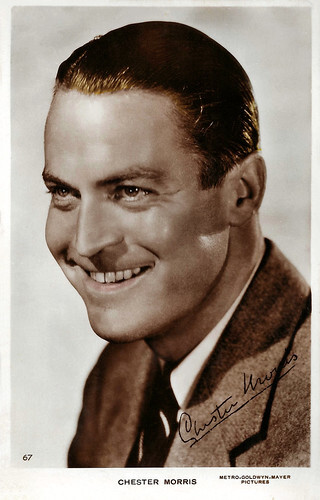
British Art Photo postcard, no. 67. Photo: Metro-Goldwyn-Mayer Pictures.
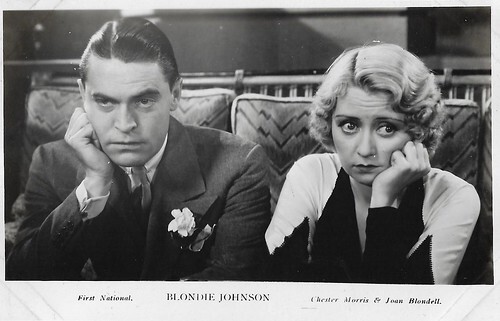
British postcard by Film Weekly. Photo: First National. Joan Blondell and Chester Morris in the pre-Code Gangster film Blondie Johnson (Ray Enright, 1933).
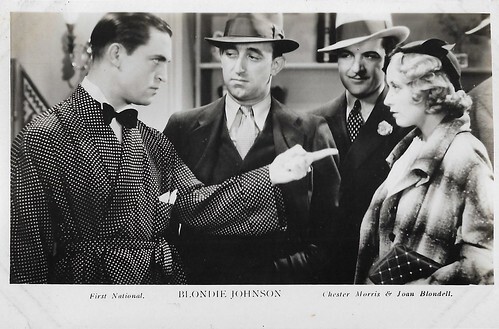
British postcard by Film Weekly. Photo: First National. Joan Blondell and Chester Morris in the pre-Code Gangster film Blondie Johnson (Ray Enright, 1933).
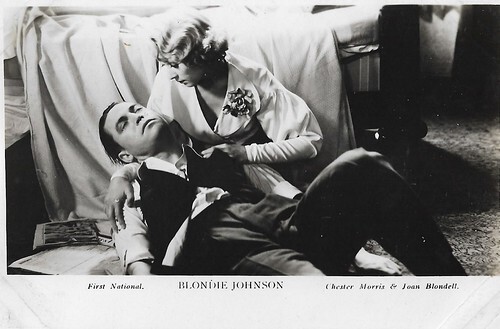
British postcard by Film Weekly. Photo: First National. Joan Blondell and Chester Morris in the pre-Code Gangster film Blondie Johnson (Ray Enright, 1933).
Sources: (IMDb), Wikipedia and .

Dutch postcard by JosPe, no. 709. Photo: Metro-Goldwyn-Mayer.

Spanish postcard by Dümmatzen, no. 18. Photo: United Artists. Chester Morris and Yola d'Avril in Cock of the Air (Tom Buckingham, 1932).

Spanish postcard by Dümmatzen, no. 114. Photo: United Artists. Chester Morris in Corsair (Roland West, 1931).

French postcard by Cinémagazine-Edition, no. 1025.
The youngest leading man in the country
Chester Morris was born John Chester Brooks Morris in New York City, in 1901. He was the son of Broadway stage actor William Morris and comedienne Etta Hawkins. His siblings were screenwriter-actor Gordon Morris, actor Adrian Morris, and actress Wilhelmina Morris. Another brother, Lloyd Morris, had died young.
Morris dropped out of school and began his Broadway career at 15 years old in the play 'The Copperhead' (1918), in support of the great Lionel Barrymore .
A year earlier, Chet Morris had made his film debut in the silent comedy-drama An Amateur Orphan (Van Dyke Brooke, 1917), but he didn't become a real film actor until the sound era. Instead, Morris appeared on Broadway in the plays 'Thunder' and 'The Mountain Man' in 1919.
He returned to the Great White Way in 1922 in the comedy 'The Exciters'. He followed it up with the comedy-drama 'Extra' in 1923. Now established, Chester Morris began billing himself as 'The youngest leading man in the country'.
In 1923, Morris joined his parents, sister, and two brothers, Gordon and Adrian, on the vaudeville circuit. They performed William Morris' original sketch called 'All the Horrors of Home', which premiered at the Palace Theatre, New York, then on the Keith-Orpheum circuit for two years, including Proctor's Theatre, Mount Vernon, New York, and culminating in Los Angeles in 1925. Morris returned to Broadway with roles in 'The Home Towners' (1926) and 'Yellow' (1927). While appearing in the 1927 play 'Crime', he was spotted by a talent agent and was signed to a film contract.

Dutch postcard. Chester Morris and Sally Eilers in She Couldn't Say No (Lloyd Bacon, 1930).

Spanish leaflet by Films Selectos, Suplemento Artistico, no. 134, 6.5.1933. Photo: United Artists. Billie Dove and Chester Morris in Cock of the Air (Tom Buckingham, 1932).

Vintage postcard. Photo: Metro Goldwyn Mayer. Chester Morris in Thunder Afloat (George B. Seitz, 1939).

American collector card. Photo: Metro Goldwyn Mayer. Chester Morris in Thunder Afloat (George B. Seitz, 1939).
A natural for movie stardom
Chester Morris' dark, good looks and chiselled jaw made him a natural for movie stardom. He appeared without credit in Cecil B. DeMille 's The Road to Yesterday (1925), but it wasn't until the transition from silent pictures to talkies that he became a real film actor.
He was one of the first actors to be nominated for an Academy Award when in 1930 (the second year of the as-yet non-nicknamed Oscars) he was recognised with a nod as Best Actor for Alibi (Roland West, 1929) with Harry Stubbs and Mae Busch. It was his first talking picture. He followed with roles in Woman Trap (William A. Wellman, 1929) with Evelyn Brent , The Case of Sergeant Grischa (Herbert Brenon, 1930) and The Divorcee (Robert Z. Leonard, 1930), starring Norma Shearer .
The film for which he is best known is the archetype prison break picture The Big House (George W. Hill, Ward Wing, 1930), with Wallace Beery and Robert Montgomery . With his role as a convict in love, he broke through to stardom. From 1930 through the middle of the decade, he was a star with good roles in first-rate pictures, such as the comedy-drama Red-Headed Woman (Jack Conway, 1932) opposite Jean Harlow . He usually played tough guys.
However, his star dimmed and by the end of the decade, he was appearing in B-pictures. In 1941, the success of the crime comedy Meet Boston Blackie (Robert Florey, 1941) and the following 'Boston Blackie'film series at Columbia Pictures revived his career. In all, he appeared in 14 pictures as the criminal-turned-detective. He reprised the role of Boston Blackie for the radio series in 1944. He later segued to TV work in the 1950s and 1960s, appearing in the occasional film such as his last one, The Great White Hope (Martin Ritt, 1970), starring James Earl Jones.
The film was released after his death. Chester Morris had been a working film actor for seven decades. Although he was afflicted with cancer, it is unclear whether he took his own life as he was apparently in good spirits and left no note in 1970. Morris was married twice. He first married Suzanne Kilbourne in 1926. They had two children, John Brooks and Cynthia. The couple divorced in 1939. In 1940, Morris married socialite Lillian Kenton Barker at the home of actor Frank Morgan. They had a son, Kenton, born in 1944. The couple remained married until Morris died in 1970.

British Art Photo postcard, no. 67. Photo: Metro-Goldwyn-Mayer Pictures.

British postcard by Film Weekly. Photo: First National. Joan Blondell and Chester Morris in the pre-Code Gangster film Blondie Johnson (Ray Enright, 1933).

British postcard by Film Weekly. Photo: First National. Joan Blondell and Chester Morris in the pre-Code Gangster film Blondie Johnson (Ray Enright, 1933).

British postcard by Film Weekly. Photo: First National. Joan Blondell and Chester Morris in the pre-Code Gangster film Blondie Johnson (Ray Enright, 1933).
Sources: (IMDb), Wikipedia and .
Published on January 12, 2025 22:00
January 11, 2025
New acquisitions Geoffrey Donaldson Institute
The Geoffrey Donaldson Institute (GDI) in Noord-Scharwoude is a small but wonderful Dutch Film Museum. The GDI promotes research on film production, film screening and film culture in the Netherlands. The archive contains a large collection of films, books, photos, posters and other objects. The institute is named after the first film historian of the Netherlands, Geoffrey Donaldson (1929-2002). The chairman of the board of GDI is our friend, film historian Egbert Barten. In the past, we posted regularly about newly acquired postcards from the GDI collection. A few months ago, Egbert came along with two big bags full of postcard albums. This year, we'll make a monthly post about one of the albums and we'll select postcards you've never seen before at EFSP. We start with a blue album with postcards by Verlag Hermann Leiser of famous authors, three cards with the legendary actor Alexander Moissi and two interesting Dutch cards.
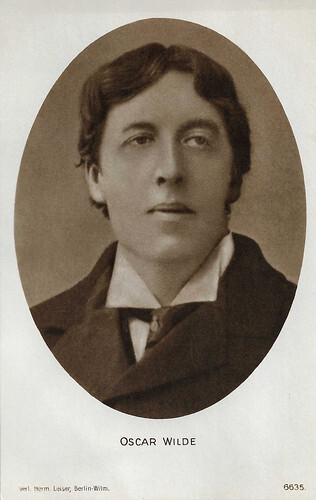
German postcard by Verlag Herm. Leiser, Berlin-Wilm., no. 6635.
Oscar Wilde (1854-1900) was a writer, poet and aesthete of Irish descent who lived in England for much of his life. A gifted poet, playwright, and wit, Wilde was a phenomenon in 19th-century England. He was illustrious for preaching the importance of style in life and art, and for attacking Victorian narrow-mindedness. He was noted for 'The Happy Prince and Other Tales' (1888), his only novel, 'The Picture of Dorian Gray' (1890), and especially his stage plays, such as 'The Importance of Being Earnest', 'Salome', 'A Woman of No Importance', 'An Ideal Husband', and 'Lady Windermere's Fan', of which have mee made countless film adaptations. Because of his homosexuality, Wilde was arrested for 'gross indecency', tried, and sentenced to two years of hard labour. Upon his release, he was penniless, and he was, as a result, reduced to living off of the generosity of friends, and of his wife, from whom he lived in a socially dictated separation. He died three years after his release in a hotel room in Paris.
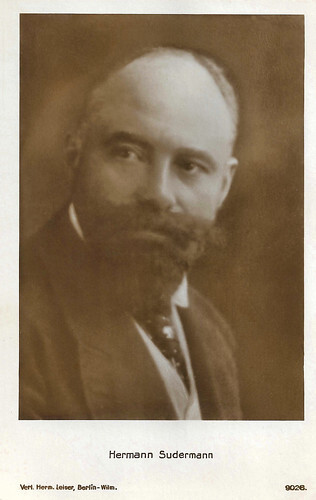
German postcard by Verlag Herm. Leiser, Berlin-Wilm., no. 9026.
German playwright and novelist Hermann Sudermann (1857-1928) is now best known for his stage plays but at the time he had more success with such novels as 'Frau Sorge' and 'Geschwister'. In 1890 his novel 'Katzensteg' attracted attention for its sympathetic portrayals of the poor and downtrodden. His 1891 novel 'Sodoms Ende' was declared "immoral" and temporarily banned by court order. His next work, however, is undoubtedly his most famous: the play 'Heimat', a major hit on stage and a favourite of such stage luminaries as Sarah Bernhardt, Eleonora Duse and Mrs Patrick Campbell, while also adapted to film. His novel Das Hohelied was adapted to film several times, with the 1933 film Song of Songs with Marlene Dietrich as the best-known version, while his short story 'Die Reise nach Tilsit' inspired F.W. Murnau's Sunrise (1927) and Veit Harlan's Die Reise nach Tilsit (1939).
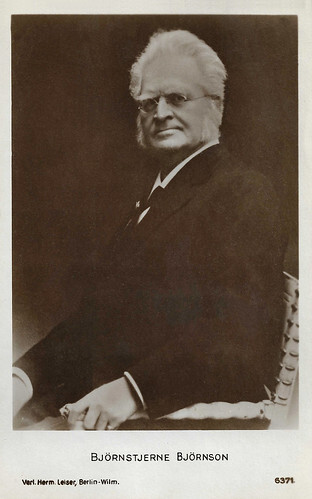
German postcard by Verlag Herm. Leiser, Berlin-Wilm., no. 6371.
Bjørnstjerne Martinius Bjørnson (1832-1910) was a Norwegian poet, social commentator, editor, public speaker and theatre personality. His production was very extensive, with peasant stories, plays, poetry, novels, articles, speeches and an enormous number of letters. As a poet and social actor, Bjørnson acted in both a national and Nordic spirit. In 1903 he became the first Norwegian Nobel Prize laureate. His novel 'Synnøve Solbakken' (1857) was filmed three times in Norway and Sweden; in 1919 by John Brunius, in 1934 by Tancred Ibsen, and in 1957 by Gunnar Hellström.
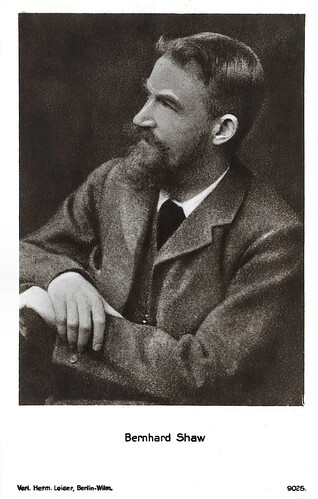
German postcard by Verlag Herm. Leiser, Berlin-Wilm., no. 9025.
George Bernard Shaw (1856-1950) was an Anglo-Irish playwright. He was awarded the Nobel Prize in Literature in 1925. Among other things, he wrote the play 'Pygmalion', later adapted into the musical 'My Fair Lady.' Pygmalion was also often adapted to film. Shaw is the only writer to date to have received both the Nobel Prize and the Oscar, the latter for his work on the screenplay for the film version of 'Pygmalion'. Shaw was an ardent socialist, unlike his lifelong close friend the writer G.K. Chesterton, who had a conservative outlook but criticised both capitalism and socialism, and who became a Catholic in adulthood.
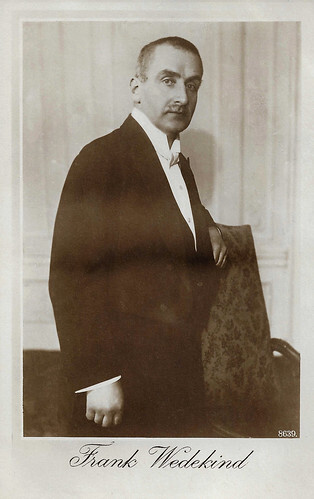
German postcard, no. 8639.
German author and actor Frank Wedekind (1864-1918) wrote plays and poems, and he also performed his poems as a revue actor. His plays 'Der Erdgeist' and 'Die Büchse der Pandora' were the basis for Alban Berg's famous opera 'Lulu'. and G.W. Pabst's classic film Die Büchse der Pandora/Pandora's Box (1929) starring Louis Brooks. Another famous work by Wedekind is the 1891 drama 'Frühlings Erwachen' (Spring Awakening).
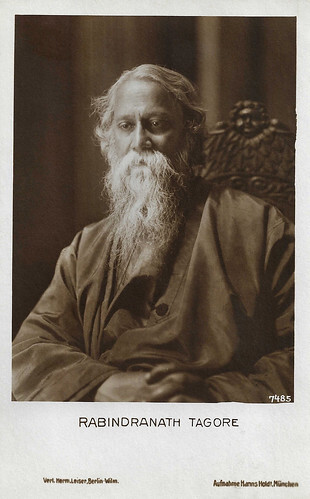
German postcard by Hermann Leiser Verlag, Berlin-Wilm., no. 7485. Photo: Hanns Holdt, München (Munich).
Rabindranath Tagore (1861-1941) was an Indian (Hindu) philosopher, nationalist and writer who was awarded the Nobel Prize in Literature in 1913. Tagore wrote the lyrics and melody for India's national anthem 'Jana-Gana-Mana' and Bangladesh's national anthem 'Amar Sonar Bangla'. He also wrote stage plays. Tagore wrote in both Bengali and English.
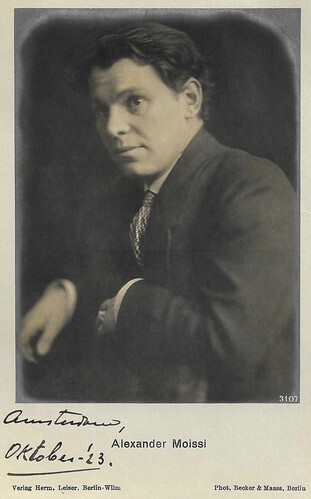
German postcard by Hermann Leiser, Bertlin-Wilm., no 3107.
Albanian-Austrian Alexander Moissi (1879-1935), born Aleksandër Moisiu, was one of the great European stage actors of the early 20th century. The attractive and charismatic women's idol also appeared in several silent and early sound films.
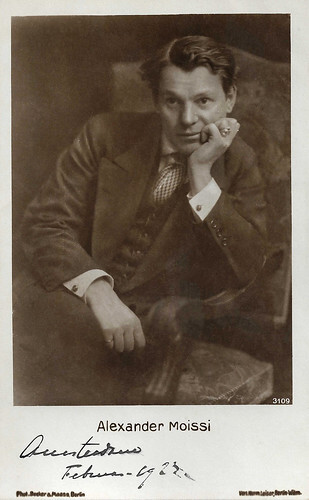
German postcard by Verlag Hermann Leiser, Berlin-Wilm., no. 3109. Photo: Becker & Maass, Berlin.
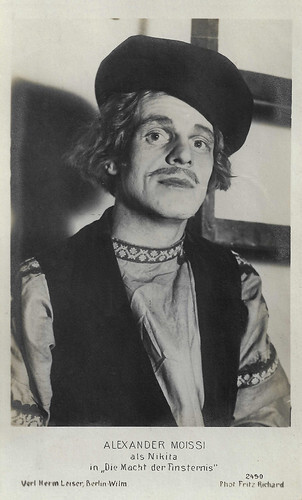
German postcard by Verlag Hermann Leiser, Berlin-Wilm., no.2450. Photo: Fritz Richard. Alexander Moissi as Nikita in 'Die Macht der Finsternis'.
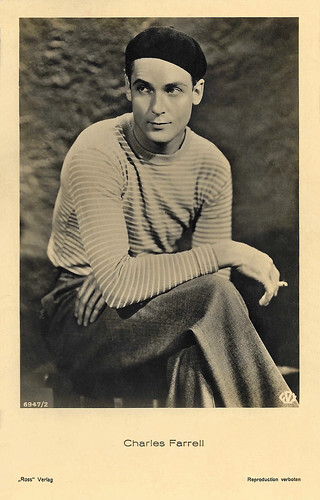
German postcard by Ross Verlag, no. 6947/2, 1931-1932. Photo: Fox.
Good-looking American actor Charles Farrell (1900-1990) was a Hollywood matinée idol of the Jazz Age and Depression era. He seems now forgotten, but between 1927 and 1934, he was very popular thanks to his teaming with Janet Gaynor in 12 screen romances, including 7th Heaven (1927), Street Angel (1928), and Lucky Star (1929). He retired from films in the early 1940s, but TV audiences of the 1950s would see him as Gale Storm's widower dad in the popular television series My Little Margie (1952-1955).
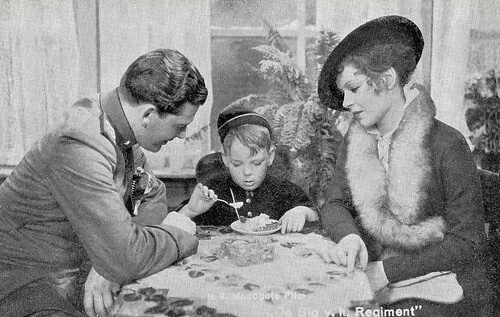
Dutch postcard. Photo: Metropole Film. Frits van Dongen , Hansje Andriesen and Jopie Koopmans in De Big van het Regiment/The Darling of the Regiment (Max Nosseck, 1935).
Handsome, deep-voiced leading man Frits van Dongen (1901-1975) was the first Dutch Hollywood star. He started his film career in the Netherlands, and in the mid-1930s he became a matinee idol in the German cinema. From 1940 on, he worked in Hollywood, billed as Philip Dorn. A tragic accident caused him to retire in 1955.
Jopie Koopman (1910-1979) was one of the stars of the Dutch cinema of the 1930s. The pretty cabaret artist sang and played in several revues and early sound films.
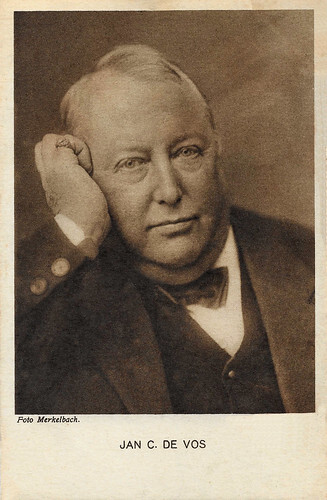
Dutch postcard. Photo: Merkelbach.
Jan C. de Vos sr. (1855-1931) was a Dutch actor, director, writer and founder and director of several theatre companies. He was the son of a Hague headmaster and initially studied Dutch literature. He attended drama school in 1876 and made his debut with the Nederlandsch Tooneel in the same year. In 1890, with Willem van Korlaar Sr., he founded the Rotterdam Tivoli theatre company, of which he remained director for five years. During that period he also taught at the theatre school (1892-1915). He played less frequently in the period 1885-1887 when he founded the ‘Weekblad de Lantaarn’ and was editor-in-chief of the Haagsche Courant. He was married to Mina Valois and Guusje Poolman (son: Jan C. de Vos Jr.). De Vos also translated and wrote several plays, namely 'Na dertig jaren' (After Thirty Years), 'Suzanne' and with M.B. Mendes da Costa 'De schuld' (The Debt). He also appeared in Dutch silent films, such as De vrouw Clasina/The Woman Clasina (Maurits Binger, 1915) and Voorbeschikten/Forecasts (Tonny Stevens, 1920). Until 1921, when he had to take leave due to illness, he worked as an actor, director and stage manager with various companies.
All photos: Collection Geoffrey Donaldson Institute. Check out our other posts on The Geoffrey Donaldson Institute.

German postcard by Verlag Herm. Leiser, Berlin-Wilm., no. 6635.
Oscar Wilde (1854-1900) was a writer, poet and aesthete of Irish descent who lived in England for much of his life. A gifted poet, playwright, and wit, Wilde was a phenomenon in 19th-century England. He was illustrious for preaching the importance of style in life and art, and for attacking Victorian narrow-mindedness. He was noted for 'The Happy Prince and Other Tales' (1888), his only novel, 'The Picture of Dorian Gray' (1890), and especially his stage plays, such as 'The Importance of Being Earnest', 'Salome', 'A Woman of No Importance', 'An Ideal Husband', and 'Lady Windermere's Fan', of which have mee made countless film adaptations. Because of his homosexuality, Wilde was arrested for 'gross indecency', tried, and sentenced to two years of hard labour. Upon his release, he was penniless, and he was, as a result, reduced to living off of the generosity of friends, and of his wife, from whom he lived in a socially dictated separation. He died three years after his release in a hotel room in Paris.

German postcard by Verlag Herm. Leiser, Berlin-Wilm., no. 9026.
German playwright and novelist Hermann Sudermann (1857-1928) is now best known for his stage plays but at the time he had more success with such novels as 'Frau Sorge' and 'Geschwister'. In 1890 his novel 'Katzensteg' attracted attention for its sympathetic portrayals of the poor and downtrodden. His 1891 novel 'Sodoms Ende' was declared "immoral" and temporarily banned by court order. His next work, however, is undoubtedly his most famous: the play 'Heimat', a major hit on stage and a favourite of such stage luminaries as Sarah Bernhardt, Eleonora Duse and Mrs Patrick Campbell, while also adapted to film. His novel Das Hohelied was adapted to film several times, with the 1933 film Song of Songs with Marlene Dietrich as the best-known version, while his short story 'Die Reise nach Tilsit' inspired F.W. Murnau's Sunrise (1927) and Veit Harlan's Die Reise nach Tilsit (1939).

German postcard by Verlag Herm. Leiser, Berlin-Wilm., no. 6371.
Bjørnstjerne Martinius Bjørnson (1832-1910) was a Norwegian poet, social commentator, editor, public speaker and theatre personality. His production was very extensive, with peasant stories, plays, poetry, novels, articles, speeches and an enormous number of letters. As a poet and social actor, Bjørnson acted in both a national and Nordic spirit. In 1903 he became the first Norwegian Nobel Prize laureate. His novel 'Synnøve Solbakken' (1857) was filmed three times in Norway and Sweden; in 1919 by John Brunius, in 1934 by Tancred Ibsen, and in 1957 by Gunnar Hellström.

German postcard by Verlag Herm. Leiser, Berlin-Wilm., no. 9025.
George Bernard Shaw (1856-1950) was an Anglo-Irish playwright. He was awarded the Nobel Prize in Literature in 1925. Among other things, he wrote the play 'Pygmalion', later adapted into the musical 'My Fair Lady.' Pygmalion was also often adapted to film. Shaw is the only writer to date to have received both the Nobel Prize and the Oscar, the latter for his work on the screenplay for the film version of 'Pygmalion'. Shaw was an ardent socialist, unlike his lifelong close friend the writer G.K. Chesterton, who had a conservative outlook but criticised both capitalism and socialism, and who became a Catholic in adulthood.

German postcard, no. 8639.
German author and actor Frank Wedekind (1864-1918) wrote plays and poems, and he also performed his poems as a revue actor. His plays 'Der Erdgeist' and 'Die Büchse der Pandora' were the basis for Alban Berg's famous opera 'Lulu'. and G.W. Pabst's classic film Die Büchse der Pandora/Pandora's Box (1929) starring Louis Brooks. Another famous work by Wedekind is the 1891 drama 'Frühlings Erwachen' (Spring Awakening).

German postcard by Hermann Leiser Verlag, Berlin-Wilm., no. 7485. Photo: Hanns Holdt, München (Munich).
Rabindranath Tagore (1861-1941) was an Indian (Hindu) philosopher, nationalist and writer who was awarded the Nobel Prize in Literature in 1913. Tagore wrote the lyrics and melody for India's national anthem 'Jana-Gana-Mana' and Bangladesh's national anthem 'Amar Sonar Bangla'. He also wrote stage plays. Tagore wrote in both Bengali and English.

German postcard by Hermann Leiser, Bertlin-Wilm., no 3107.
Albanian-Austrian Alexander Moissi (1879-1935), born Aleksandër Moisiu, was one of the great European stage actors of the early 20th century. The attractive and charismatic women's idol also appeared in several silent and early sound films.

German postcard by Verlag Hermann Leiser, Berlin-Wilm., no. 3109. Photo: Becker & Maass, Berlin.

German postcard by Verlag Hermann Leiser, Berlin-Wilm., no.2450. Photo: Fritz Richard. Alexander Moissi as Nikita in 'Die Macht der Finsternis'.

German postcard by Ross Verlag, no. 6947/2, 1931-1932. Photo: Fox.
Good-looking American actor Charles Farrell (1900-1990) was a Hollywood matinée idol of the Jazz Age and Depression era. He seems now forgotten, but between 1927 and 1934, he was very popular thanks to his teaming with Janet Gaynor in 12 screen romances, including 7th Heaven (1927), Street Angel (1928), and Lucky Star (1929). He retired from films in the early 1940s, but TV audiences of the 1950s would see him as Gale Storm's widower dad in the popular television series My Little Margie (1952-1955).

Dutch postcard. Photo: Metropole Film. Frits van Dongen , Hansje Andriesen and Jopie Koopmans in De Big van het Regiment/The Darling of the Regiment (Max Nosseck, 1935).
Handsome, deep-voiced leading man Frits van Dongen (1901-1975) was the first Dutch Hollywood star. He started his film career in the Netherlands, and in the mid-1930s he became a matinee idol in the German cinema. From 1940 on, he worked in Hollywood, billed as Philip Dorn. A tragic accident caused him to retire in 1955.
Jopie Koopman (1910-1979) was one of the stars of the Dutch cinema of the 1930s. The pretty cabaret artist sang and played in several revues and early sound films.

Dutch postcard. Photo: Merkelbach.
Jan C. de Vos sr. (1855-1931) was a Dutch actor, director, writer and founder and director of several theatre companies. He was the son of a Hague headmaster and initially studied Dutch literature. He attended drama school in 1876 and made his debut with the Nederlandsch Tooneel in the same year. In 1890, with Willem van Korlaar Sr., he founded the Rotterdam Tivoli theatre company, of which he remained director for five years. During that period he also taught at the theatre school (1892-1915). He played less frequently in the period 1885-1887 when he founded the ‘Weekblad de Lantaarn’ and was editor-in-chief of the Haagsche Courant. He was married to Mina Valois and Guusje Poolman (son: Jan C. de Vos Jr.). De Vos also translated and wrote several plays, namely 'Na dertig jaren' (After Thirty Years), 'Suzanne' and with M.B. Mendes da Costa 'De schuld' (The Debt). He also appeared in Dutch silent films, such as De vrouw Clasina/The Woman Clasina (Maurits Binger, 1915) and Voorbeschikten/Forecasts (Tonny Stevens, 1920). Until 1921, when he had to take leave due to illness, he worked as an actor, director and stage manager with various companies.
All photos: Collection Geoffrey Donaldson Institute. Check out our other posts on The Geoffrey Donaldson Institute.
Published on January 11, 2025 22:00
Paul van Yperen's Blog
- Paul van Yperen's profile
- 13 followers
Paul van Yperen isn't a Goodreads Author
(yet),
but they
do have a blog,
so here are some recent posts imported from
their feed.



